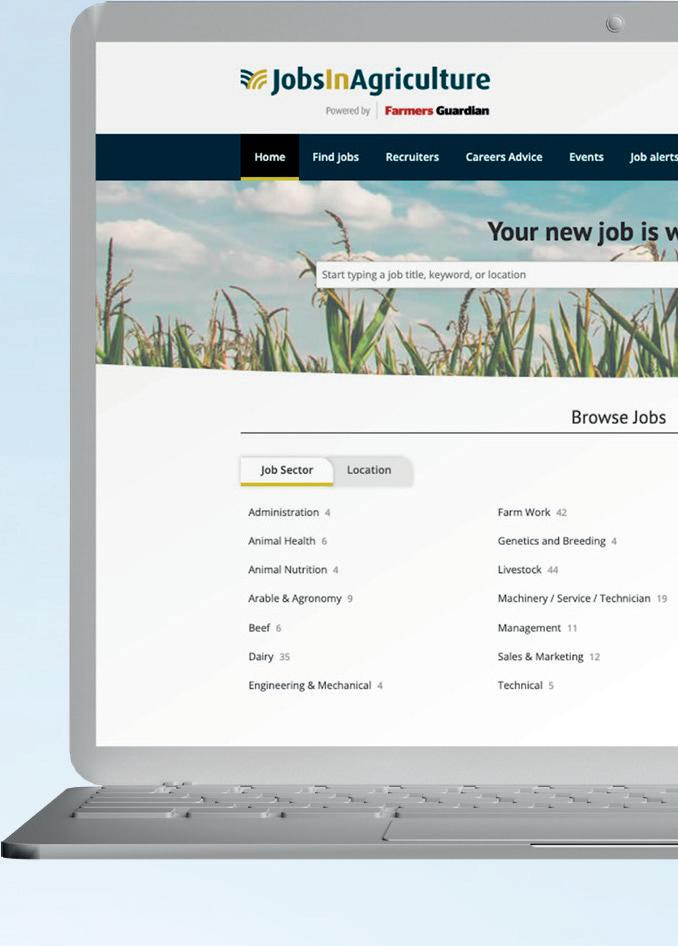increases feed efficiency by 6% up to



increases feed efficiency by 6% up to


Feeding Levucell SC contributes to sustainable milk production by helping produce more milk from the same amount of feed.



Up to 6% increase in feed efficiency


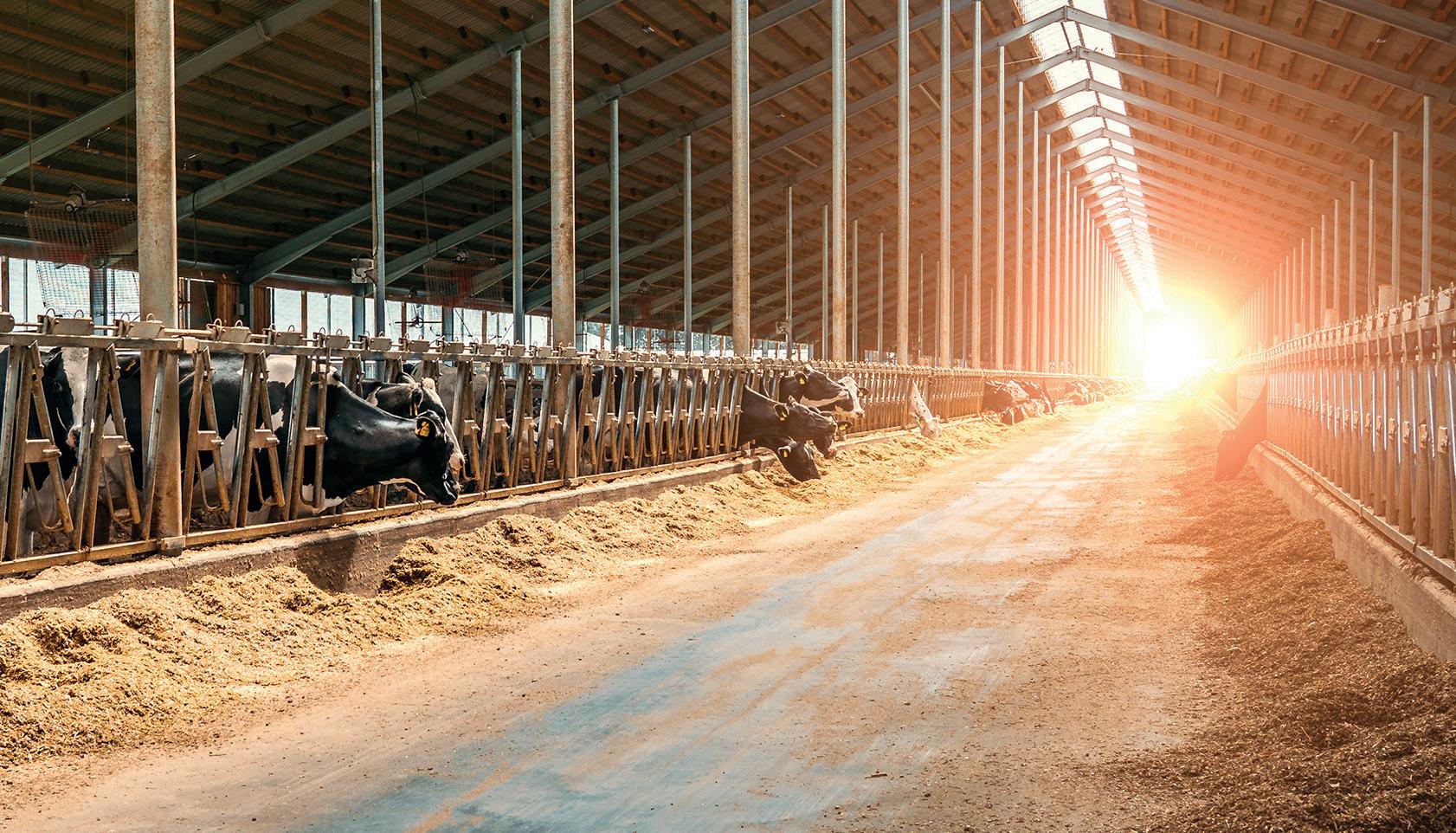
On average +1.1kg more milk / cow / day
Typical return on investment of 4:1


To learn more about Levucell SC visit LallemandAnimalNutrition.com or call our experts on 07827 228161



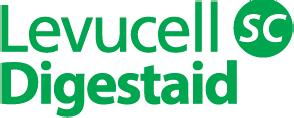





Youngstock Busting colostrum pasteurisation myths

Pages 18-19

NUTRITION
Focus turns to utilisation of conserved forages

Pages 54-70
UK DAIRY DAY
All of the highlights from the Telford event
Pages 40-50
We go in depth with this year’s four hopefuls
Pages 52-53


MILK PRICES
Pages 76-78
TIP OF THE MONTH: What you need to do to apply for the calf housing grant – p34











Editor Katie Jones 07786 856 439 katie.jones@agriconnect.com

Content Editor/Designer




Mike Begley 01772 799 405 mike.begley@agriconnect.com


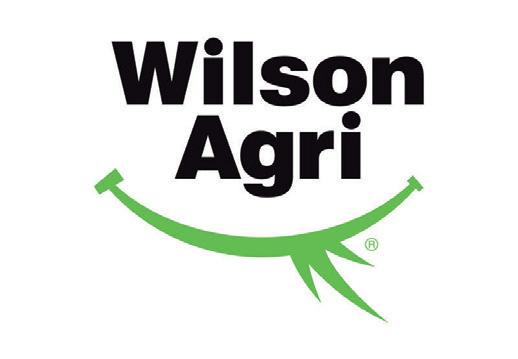
Picture Editor
Marcello Garbagnoli 01772 799 445 marcello.garbagnoli@agriconnect.com
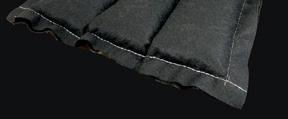
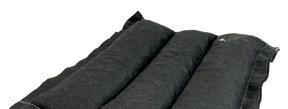

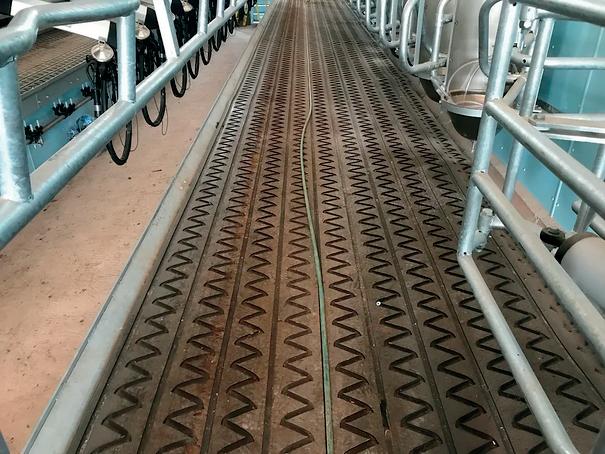
Sales Director
Stephanie Ryder 07917 271 987 stephanie.ryder@agriconnect.com

Account Manager
Mark Jackson 01322 449 624, mark.jackson@agriconnect.com
Classified Advertisements 01772 799 400 fgclassified@agriconnect.com
Advertising Production
Justine Sumner 01772 799 437 Fax: 01772 796 747 justine.sumner@agriconnect.com
Circulation and subscriptions 0330 333 0056 help@subscribe.farmers-guardian.com

Subscription rates: UK £65 a year Europe: £85 World: £95
ISSN 1475-6994
© Farmers Guardian 2023
All rights reserved. No part of this publication may be reproduced or transmitted in any form or by any means, electronic or mechanical including photocopying, recording, or any information storage or retrieval system without the express prior written consent of the publisher. The contents of Dairy Farmer are subject to reproduction in information storage and retrieval systems.
Dairy Farmer, Unit 4, Fulwood Business Park, Caxton Road, Preston, Lancashire PR2 9NZ



Origination by Farmers Guardian, Unit 4, Fulwood Business Park, Caxton Road, Preston, Lancashire PR2 9NZ. Printed by Precision Colour Printing, Halesfield 1, Stirchley, Telford TF7 4QQ. No responsibility can be accepted by Dairy Farmer for the opinions expressed by contributors.
It was great to once again be at UK Dairy Day in September and, despite the underlying worry of milk prices and high input costs, I think most farmers will have been glad to get out and chat to fellow farmers, visit trade stands and perhaps stand and admire some of the cows on show.

Speaking to trade stand exhibitors, despite the current mood within dairy farming, there were some meaningful conversations taking place about investments in genetics, technology and infrastructure. However, I am mindful that not all farmers are positive about their own futures, as is highlighted by the NFU’s recent Dairy Intentions survey and discussed by NFU dairy board chair Michael Oakes in this month’s Dairy Ma ers pages (see p14-15).
e panel sessions at UK Dairy Day were particularly well-a ended and poignant, as they looked at the future of the dairy cow, milk pricing, the industry and farmers’ businesses. ere was, of course, plenty of debate about milk pricing and, while there were probably no direct actions to come out of these discussions, it at least gave farmers a chance to say their piece.
And say our piece we must. We cannot just let these issues pass us by. We have to stand up for our industry.
Recently there has been news about earlier payments for some farmers who have secured Sustainable Farming Incentive agreements, but this clearly does not go far enough and only helping ‘some’ farmers is clearly not good enough.


Farmers who have secured Sustainable Farming Incentive (SFI) agreements by the end of October will be paid 25% of the monies in November, but farming groups do not feel it goes far enough.

Defra Secretary erese Co ey said the move would help ease businesses’ cash ow and boost farmer con dence.
Dairy Farmer understands the number of farmers who will receive this cash injection is likely to be low and could be in the hundreds rather than the thousands.

It comes as the rst SFI agreement has just been processed and nalised this week.
Defra has been under pressure over its decision to delay the rollout of the SFI due to technical issues, with the NFU calling on the department to halt any further reduction in existing Basic Payments until the problems with the new scheme are ironed out.
But in an exclusive interview with DF’s sister publication Farmers Guardian at Defra’s headquarters, the Defra Secretary said while she would not bow to the union’s demands, this latest move would ‘hopefully assure’ farmers.
Ms Co ey said: “If they manage to sign o their contracts
JBadger culling will continue in England for as long as necessary, with Defra Secretary Therese Coffey confirming there was ‘no set end date’.
Ms Coffey made it clear she did not agree with her predecessor’s ‘arbitrary deadline’ on ending the badger cull.
With bovine TB herd incidence rates tumbling since the start of intensive culling in high risk and edge areas of England, she stressed there would be no deadline.

She said: “We will keep culling for as long as we need to keep culling and there might be areas of the country where there might still be seepage and we will assess that and if we start to see problems in different parts of the country we will consider culling there too.
“This is not about some shoot up badgers fest, this is about trying to make sure we use science and epidemiology appropriately and back our science, but ultimately we have to support our farmers to get through this difficult time.”
JGB milking herd youngstock numbers have declined for a second consecutive quarter.
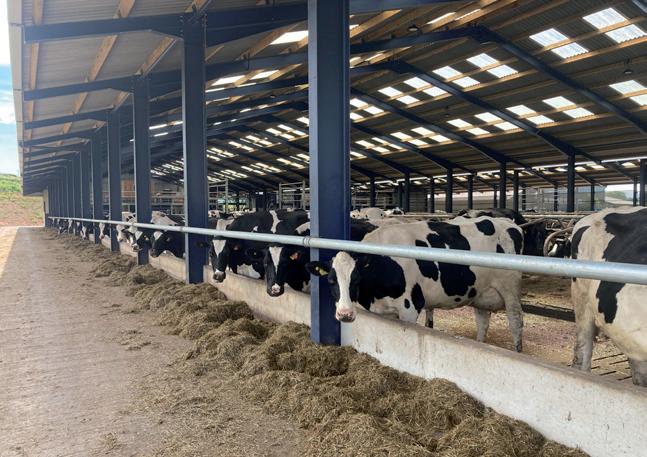
Data from AHDB shows the youngstock population has seen a decline for the second consecutive quarter.
Youngstock numbers reduced by 1.2% or 11,500 head compared to the same point last year, to stand at 929,000 head in July.
by October, they will get paid in November. Instead of having to do everything in arrears, I want to make sure they get some of that cash straight away so they can start getting on with the job.”
She conceded Defra had incorrectly told some farmers signing up for SFI 2022 that they could not apply for SFI 2023, adding she would ‘track down’ emails from her department’s officials and the Rural Payments Agency.
She added: “We will honour the contract. I am aware they have
been contacted suggesting they will not be able to participate in SFI 2023 and that is not the case. Anyone who signed up to SFI 2022 who wants to get involved in SFI 2023 are in my top priority.”
NFU president Minette Batters said while the news would be ‘great news for the minority’, ‘the majority still face big cashflow issues’.
With a General Election looming and both Labour and the Liberal Democrats seemingly gaining ground in rural areas, the Defra Secretary was strident in her backing of the country’s food producers.


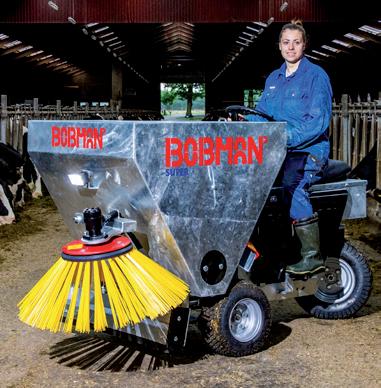
She said: “We have great food, great welfare, great standards.”
Following the publication of July figures, the data shows a ‘relatively small’ year-on-year decline in the GB milking herd of 0.6%, with July figures totalling 1.62 million head.
JHugh McClymont, who recently retired as research farms manager for SRUC, has been awarded the RABDF Princess Royal Award for outstanding contribution to the dairy sector.
He was presented with the award by Princess Anne at a ceremony at Gatcombe Park.
Anyone who signed up to SFI 2022 who wants to get involved in SFI 2023 are in my top priority THERESE COFFEY
Surveys criticising livestock farmers are having a ‘detrimental impact’ on their mental health and well-being.
That was the message from NFU livestock board chair Richard Findlay, after the Social Media Foundation released results of a survey which found approximately threefifths (58%) of participants had tried to cut down on red meat due to concerns about animal welfare, health and environmental harm.
Mr Findlay said he was concerned by both the validity of the survey and the harm it would cause to farmers who are working ‘tirelessly’ to place food on the public’s tables.
“We have seen surveys with very little merit like this before which does nothing but place farmers with another burden while trying to influence politicians in a negative way,” he said.
“What concerns me the most is the wider harm it can place on the public’s health - especially children.
“These types of surveys harm people’s perceptions of what is and what is not healthy for them, with the latter being promoted without any founding logic.”
He added the NFU would always promote a balanced diet.
“Telling people to do the opposite is dangerous to their health because the harm plantbased alternatives could do is something is very concerning.
“Surveys like this are an attack on farmers’ livelihoods, and it is damaging to their mental health.
“Farmers already face pressures to keep a roof over their heads and this is the last thing they should be facing.”
The survey is part of a series exploring alternative proteins, sponsored by the RSPCA.

Gemma Hope, assistant director for policy, advocacy and evidence
at the RSPCA, said the public was clear about supporting plant-based alternatives.
“Even during the depths of a cost of living crisis, a majority want their taxes spent on subsidising plant-based alternatives to meat. This is a priority issue for them and they want action,” she said.
She added the first step was clear labelling on meat products, telling shoppers how animals were reared.
JA new report released by the Centre for Innovation Excellence in Livestock (CIEL) has identified that the livestock sector can use nitrogen more effectively.
The ‘Why nitrogen matters in livestock production’ report sets out how the industry can better utilise nitrogen and encourage effective nitrogen cycling says Dr Mark Young, innovation specialist at CIEL.
He says: “Nitrogen is essential for agriculture. It is the key element needed for protein production, captured by microbes living in soil, in the roots of plants and colonising the gut of sheep and cattle.
“However, while some
agricultural practices cause excessive loss of nitrogen to the atmosphere and waterways, others can capture nitrogen.
“Losses from the nitrogen cycle cannot be eliminated, so the livestock sector needs to exploit the opportunity to minimise losses and hold more nitrogen in the system.
“This will make farming both more efficient and reduce losses of nitrogen as nitrous oxide [a greenhouse gas], ammonia emissions, and nitrate through leaching or run-off.”
To better understand nitrogen’s interaction with the environment and the potential, this report by CIEL takes a deep dive into
the natural nitrogen cycle, explaining how agricultural practices shape the cycle and the opportunities to improve nitrogen use.
He adds: “The report identified the critical need for farmers to have access to reliable tools to measure nitrogen on-farm, soils in particular, to identify and monitor where nitrogen losses occur, in order to maximise nitrogen use efficiency.
“By managing the land and on-farm nitrogen resources such as soils, manures and fertilisers, farmers can make management decisions that will make better use of nitrogen.
“In addition to this, developing on-farm technologies which will help to capture or hold nitrogen, for example in livestock manure, and to make this available for enhancing growth of feed crops will also help to reduce nitrogen losses in the sector.”
Dr Young says: “This report provides a rounded picture of nitrogen in agriculture, highlighting its key role in producing high quality protein from livestock and identifying where losses that impact on the environment occur.
“Sustainable agricultural systems should aim to maximise these nutritional benefits while minimising negative environmental impacts.”



Ifan Roberts is herd manager at Houghton Lodge, Leicestershire, which is one of the farms managed by Evolution Farming. This farm runs more than 1,000 cows on a spring-calving system.
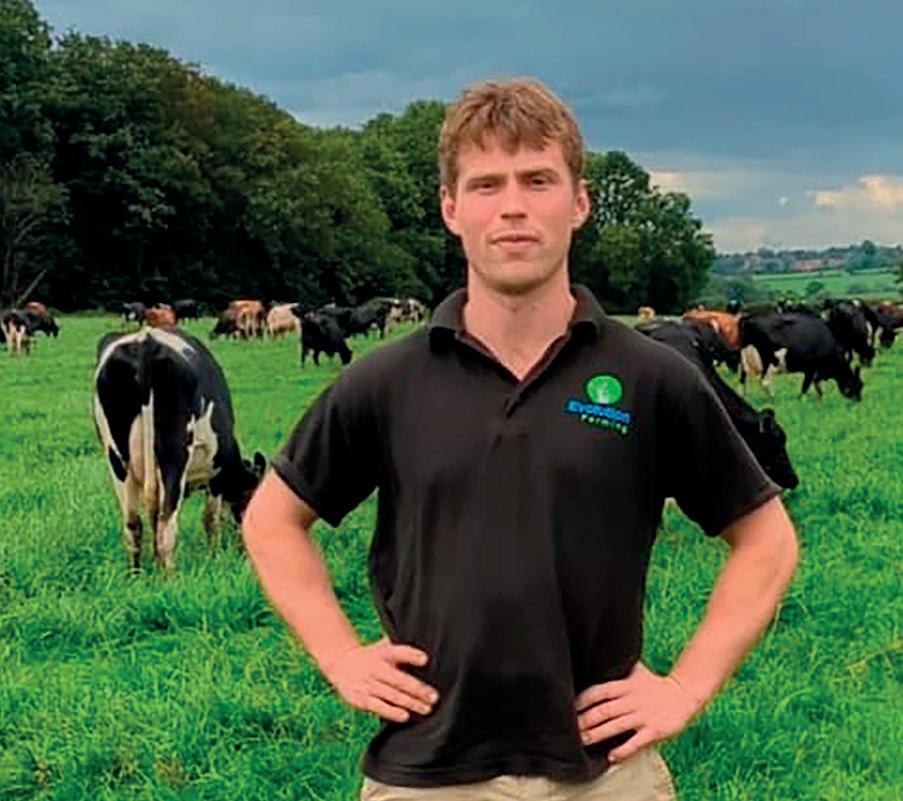
Having grown up on a small dairy farm in North Wales, I knew from an early age that dairy farming was going to be a real passion for me in life, even though I was o en discouraged from taking it up as a career by friends and family.
At the age of 15 I set myself the heady goal of one day milking 1,000 cows. When I shared this goal with the people around me at that time, I was met with many a sarcastic laugh or negative comment.
In 2014 I le collage at 18 and, along with my father, looked to grow the family dairy business by taking on a share farming opportunity locally, where we grew our herd from 50 to 150 cows.
During this time, I learned about ‘cow leasing’ and started to grow a herd of my own within my father’s business, which started o with one rather useless under-grown Jersey cow and soon a er I grew this to a herd of 12.

Sadly, the challenging times of 2015-2016 were a perfect storm that my father and I had not prepared for, leading to my father deciding to consolidate his business back to the home farm in 2017, leaving myself and my cows with few prospects at the time.
It was at this point I felt as though the dream of milking my 1,000 cows could not have felt further away.
Luckily, it was around this time I took my rst motorway trip down the M6 to meet with Tom Rawson for an interview. At some point during this meeting, I remember sharing my dream with Tom and was pleasantly surprised to nd that he was the rst person who didn’t laugh.
Fast forward six years and despite facing numerous challenges and lessons I can now proudly say that with the help from everyone at Evolution Farming, and many others, I have now achieved my goal and am now managing 1,070 spring calving dairy cows plus followers at Houghton Lodge farm in Leicester.
Of these cows, I now own 370, which I am leasing back to the enterprise.
e farm comprises 500 hectares of grass and has a team of seven full-time sta plus relief. I also

rent some pasture land from my grandmother on which I raise all of my replacements.
is year has been an extremely varied year for us at Houghton Lodge, providing many challenges, including downward pressures from the milk price and a cold and wet late spring a ecting pasture quality, grass utilisation and calf health. is was followed by an extremely hot and dry start to the breeding season, a uctuation in sta numbers for various reasons and, on top of this, growing our herd by calving more than 400 heifers, which took a fair e ort from the team to break into the milking routine.
However, our team prevailed in delivering an overall positive result in calving and breeding and, although we have taken a hit on our average yield, sacri cing a projected 500 litres per cow on last year, we have ended up adding another 1% on to our six-week in-calf rate, which is now up to 74%. e second half of the season brought way above average summer grass growth from July onwards. is, coupled with good pasture management, careful cost control and great husbandry skills from the team, means we are set to potentially deliver our year ‘on budget’, despite all the challenges faced. On top of this we have also drastically increased our forage stocks to hopefully aid future potential droughts and have grown a healthy looking generation of more than 300 youngstock.
“ This year has been an extremely varied year for us at Houghton Lodge, providing many challenges
Fourth-generation farmer Gemma Smale-Rowland farms with her parents at North Petherwin, near Launceston, north Cornwall, where they milk 120 pedigree Holsteins under the Glebewin prefix. She established the Cornish Moo brand in 2018 and was one of the first farmers in the country to install an on-farm milk vending machine.

As the annual migration of buckets and spades began, with high spirts and families looking forward to summer on the beach in Cornwall, so did rainy season.
The British summer never fails to disappoint and when the schools break up, we can always guarantee the British summer makes sure everything is a washout.
The accuracy of the Met Office forecast this year makes me wonder if we are just playing a game of The Wheel of Fortune, with the wheel spun on a daily basis and just delivering whatever it likes for that given day. It seems that is about as reliable as it gets when it comes to the Met Office and every day we seem to wake up to a new challenge. With small windows of opportunity, we have managed to get all the harvest in.
Maize is pending, but nearly there and hopefully by the time you read this it will be safely in the pit.
We have been lucky that we have managed to get good grass growth this year to keep in front of the cows, along with filling the clamps.
However, the rain has affected grass quality and we are already buffer feeding with first cut to try and keep yield and quality high.
As we all face different challenges throughout the farming calendar, we all handle them differently and have a range of mechanisms of coping.
Something I found really interesting this summer was an Instagram account run by Andrea McDowell, also known as @dahliabeach. She is a lady who ran a hugely successful wedding company in London, which unfortunately ended up closing in 2020 due to Covid-19.
She is now living in the Cotswolds and has decided to follow her dream to become a flower farmer.
In her first year in business in 2022 she had a hugely successful time with a massive field of dahlias and she ran a pick-your-own enterprise. It all sounded wonderful and many following her might have thought ‘how difficult can farming be?’
But as all of us farmers know year to year things tend to differ, and this year has not been quite so good for her, with the wet spring and then the lack of sunshine all making for challenging growing conditions. I found it interesting from a farmer’s point of view how she documented all the highs and lows of what her year had to brought, and there have been many, I tell you.
The thing which really made me think was this was someone who had come from the outside into farming and had really struggled this year with the challenges we face day-in day-out, year-in year-out.
She has been brutally honest about the effect this has had on her mental health. This will have brought some insight for her 81,400 followers of what us as farmers producing products for this country have to go through and how resilient farmers can be.
This summer has seen some huge efforts by people to bring mental health awareness and suicide prevention to the fore. We had Olly Harrison driving in the combine challenge, which helped raise awareness and funds for Mind mental health charity and Children with Cancer UK. There was also the Len’s Light tractor relay, which again shone a light on mental health and suicide in the rural community.
These amazing efforts really help to bring awareness to the public and to open the eyes of the rural community.
So as the vibrant green trees now turn to rusty orange, the fields start to fill with pumpkins and the country lanes are scattered with pheasant pullets, we can see the seasons are clearly changing. This seems like a good time to reflect on the past year and how things have gone.
But as we head into the long autumn months ahead, we must also remember to look out for each other.
Let’s hope for a dry autumn, which helps lift some pressure, by ensuring we can finish the harvest and keep stock out for longer.
“ These amazing efforts really help to bring awareness to the public and to open the eyes of the rural community
Josh
is a
with
After working on a pig unit as a teenager, and a brief spell as a builder for his father’s business, Josh Fincham decided to follow a career in agriculture and worked his way
up to becoming a dairy farm manager, before entering into a share farming arrangement.
e share farming contract is with Guy and Anne Trehane, owners of Hampreston Manor, near Wimborne, Dorset.
e Trehanes had a history
within the Holstein breed, having owned the country’s oldest closed herd of pedigree Holsteins.

Josh says: “When I arrived at Hampreston Manor in 2018, I worked as herd manager for the contract farmer at the time, but it was always with a view to taking on the agreement in my own right.
“A couple of years later, I took over the contract, which is based on a pro t share of 80:20 in my favour, without the Single Farm Payment. It is a question of nding a solution which bene ts both parties and I am very happy with the division.
“I run the operation as a limited business. e pro t share is awarded once a year. I also

receive a contractor fee on a monthly basis. e business employs a herd manager, David White, who does most of the milking.”
Josh’s ancee, Lauren Pincombe, a quali ed vet, also works alongside Josh on the farm. Hampreston Manor carries 270 autumn-calving cows, which have an average yield of 6,500kg, including 540kg of milk solids, with milk marketed on a solids contract to Blackmore Vale Dairy. e farm operates a 320-day grazing system and the herd achieves an average 3,500kg of milk from forage, while concentrate usage is about 1.5 tonnes/head.
Cows are a mix of Irish and
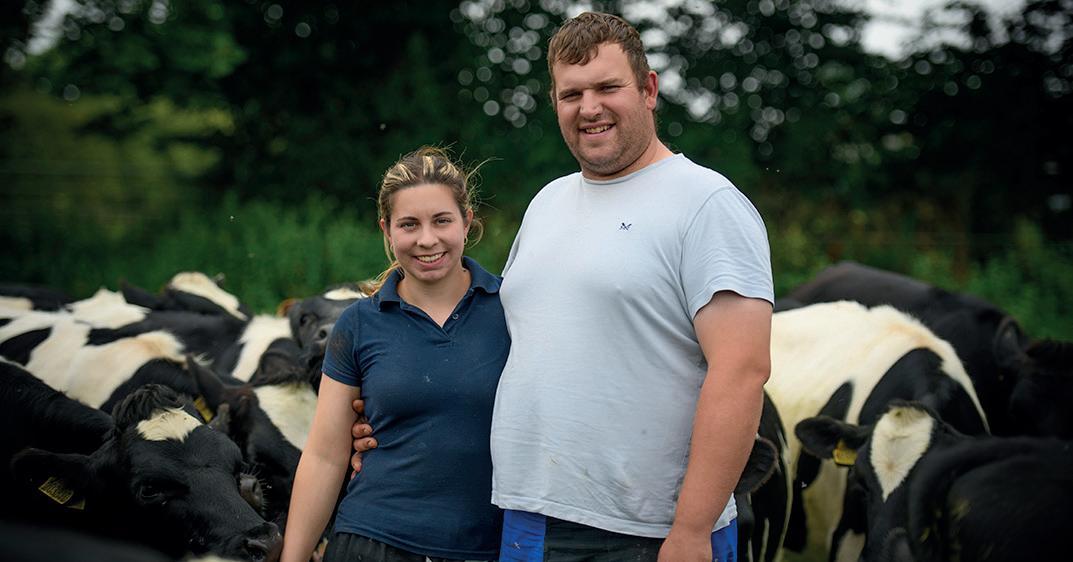
New Zealand Friesian and there are also some Jersey cross-breds on the unit.
e cows are housed in cubicles at night from October until January or February, depending on the weather.

e farm covers 121 hectares (300 acres), with a further 40ha (100 acre) block rented.

“One half of the land is a ood plain and the other half is a gravelly loam,” says Josh.








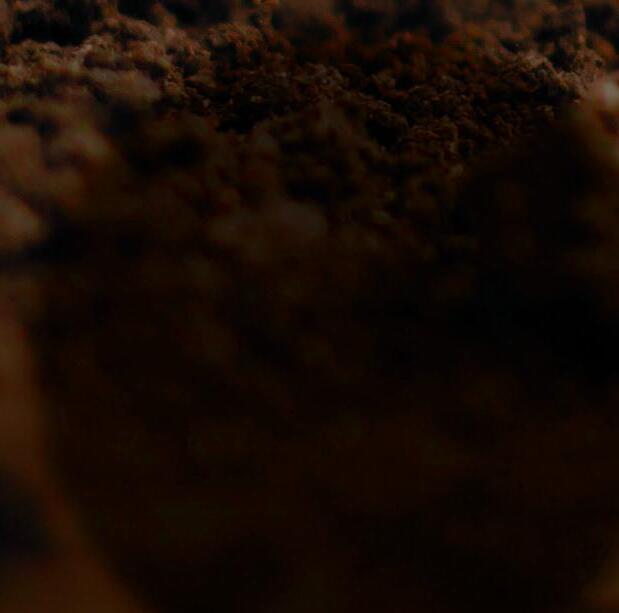



Green

“ is o ers a degree of exibility.







e ood plain precludes spring calving unfortunately, but it will stay green during droughts, while the free-draining elds are ideal for maize-growing and extending the grazing period.
“ e gravel land also permits us to calve fully outdoors on standing hay.”

e grassland is divided into 3.4ha (8.5-acre) paddocks, each of which is grazed by the whole
herd three times throughout the season. ese are reseeded every ve years and herbal leys are being trialled.
Some 36ha (90 acres) of maize are grown annually to boost forage stocks, as lack of soil moisture usually means that spring is the only feasible time for taking the one cut of grass silage.
e self-feed forage system keeps labour to a minimum, but it has to be managed carefully to ensure success, he says.
“ e heifers are trained for selffeed before they enter the herd.

“It usually takes about two weeks before they will consistently eat fresh silage from the face, rather than eating scraps from the clamp sides.
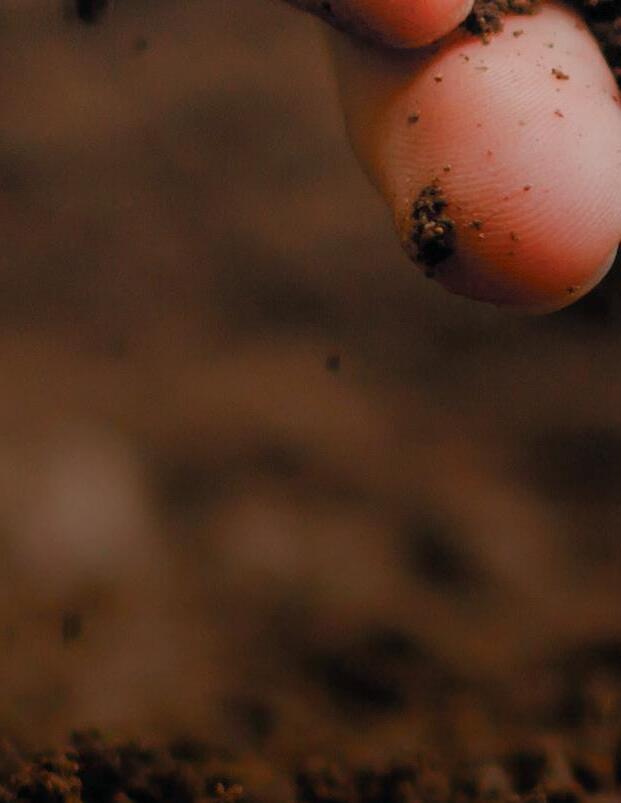
“In the early stages, one end of the electri ed wire is secured on the ground and the other starts o at about six inches from the oor and is raised gradually.

“ e barrier is kept at about 18 inches from the grass silage face
and 24 inches for the maize. e grass silage clamp is closed unless the cows are fully housed.
“Otherwise, intakes would be reduced at grazing.




“I have been asked whether the cows will choose the maize silage over the grass, and my answer is that the grass silage has to be very good to achieve an approximately



equal split. I try to produce a highly palatable grass crop and the analysis is usually about 17% protein, 12 ME and 30% dry ma er.
“However the heifers tend to prefer the maize, as it is a bit easier to pull out from the face.
“If the two crops were layered, any eating preferences

would make the clamp unstable.”
Heifers calve at 24 months and the lower end of the herd produces beef cross calves which are sold at 10 days old.
Fertility is closely monitored and the current statistics show 50% of the heifers calving within four days during the nine-week block-calving period.
ese gures, says Josh, show the bene t of having a vet working on the unit. Lauren also manages the calves and focuses on rapid early growth, consistently reaching the target calf weight of 100kg for weaning at six weeks on ad-lib feeding.
And Josh says he has not regre ed the switch from a
r121 hectares (300 acres), with a further 40ha (100-acre) block rented
r270 autumn-calving cows which have an average yield of 6,500kg
rSelf-feed forage system

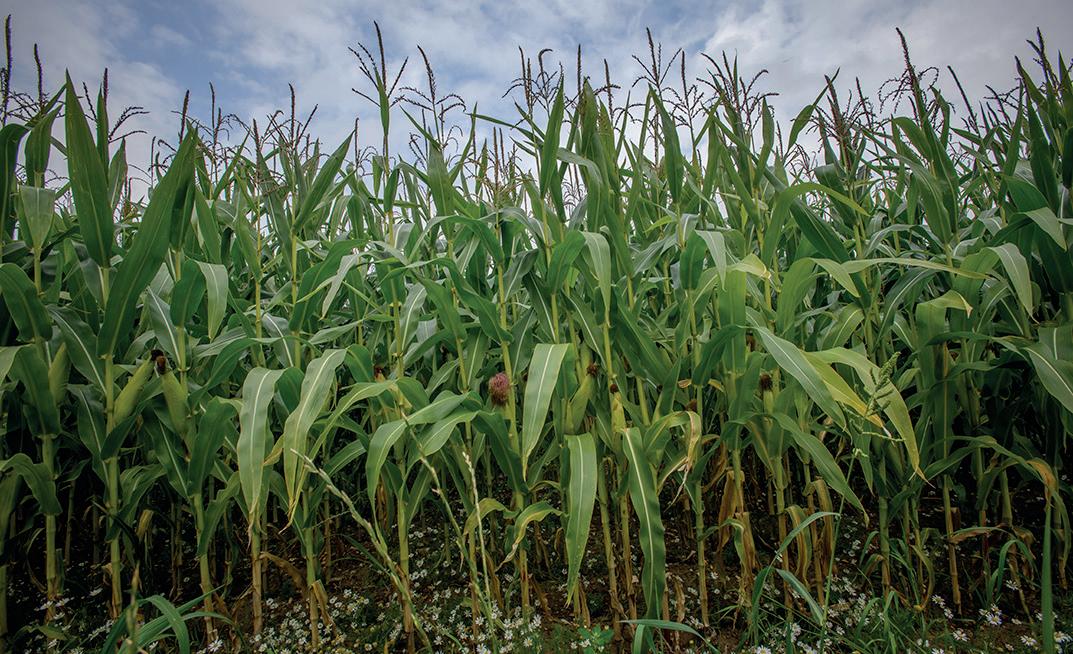
rCows are housed in cubicles at night from October until January or February
high-yielding Holstein herd, to a more low input system using a di erent type of cow.
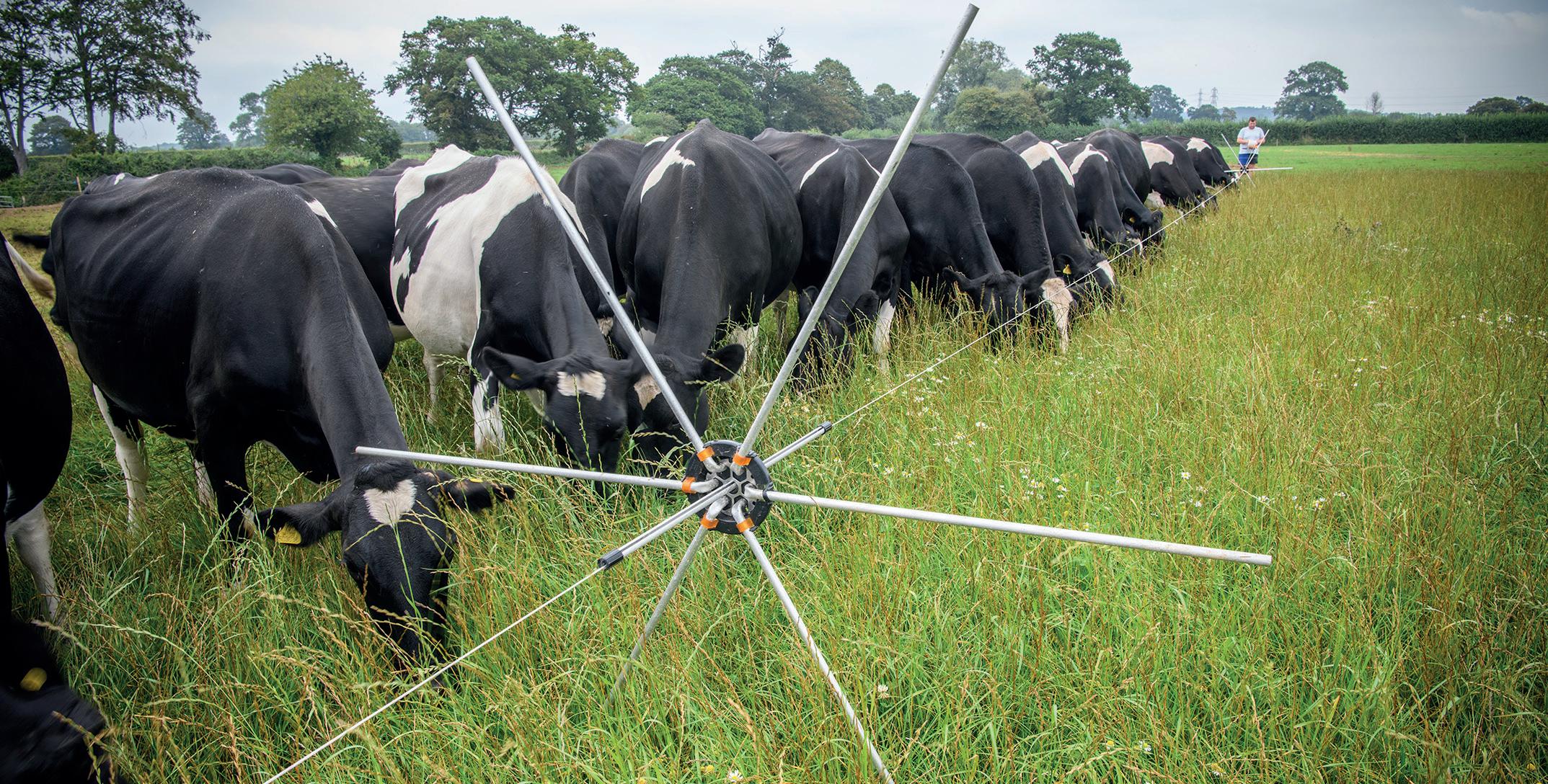
“I felt that a smaller-framed, hardy cow with good ability to convert milk from forage would be the best way forward.
“I was lucky enough to inherit a new 20:40 Waikato parlour with in-parlour batch feeders and a new water system. I also had the bene t of 1.5 miles’ of concrete sleeper tracks and I have since added some chalk and arti cial grass tracks.”
Several hurdles have been overcome, in order to make the venture a success.
“ e main problem was nance; I had no business records and no nancial history.
“When I approached a dealership about buying a tractor, I was turned down, although I succeeded eventually with help from a salesperson I had known from the Young Farmers’ Club.
“ e machinery is limited to a loader tractor and a scraper tractor and therefore contractors are used for tasks like maize drilling and new ley establishment.
“ e original contract farmer had half of the cows in his name and the owner retained the other half. e bank would not give me a loan to purchase my halfshare in the herd, as the proposal was considered high risk.
“Nevertheless, I was permi ed to pay for the contract farmer’s cows using my share of the pro ts
over a period of two years and I started by buying the youngstock. ere was not a lot of money available for personal spending in those early days.”
Next year will see the couple’s wedding and they plan to leave plenty of room for family time, while running their business and living on site in a house which is included in the arrangement.
“Our herdsman has a young family and, as a team, we try and make sure that we all have a decent quality of life, by limiting our weekly working hours to 40-50.
“ at is only achievable because the management system has been simpli ed as far as possible. I did not go into this venture to work 100 hours a week, because that is not good for anybody’s physical or mental well-being.
“ e unit is performing well as a business and I am feeling fairly con dent about the future. Buying my own farm would be far too expensive, but I was inspired by learning how other new entrants had managed to get on the farming ladder. I hope that my story will encourage others to look out for opportunities and grasp them, if they come along,” says Josh.
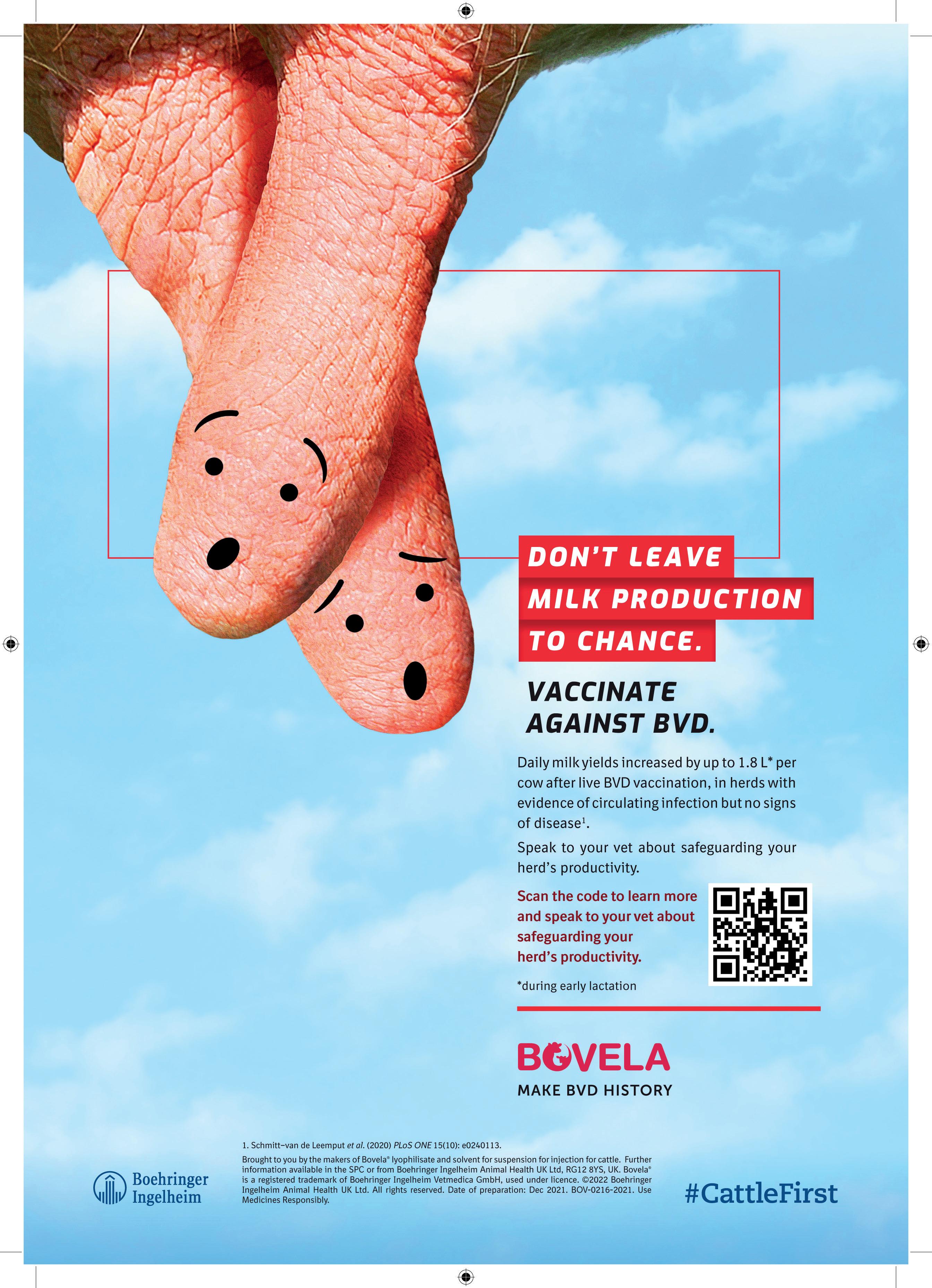
Michael Oakes is the NFU dairy board chair, a position he has held since 2016. He is a tenant dairy farmer based just outside Birmingham, milking a herd of 180 pedigree Holstein cows and the milk is sold to Arla.

With milk and other dairy products being such a staple in the vast majority of British households, it seems inconceivable that almost a third of producers are considering their future within the sector. However, that is the stark reality as we face volatile markets, significant inflationary pressures and below cost of production prices – all of these are putting the long-term resilience of many dairy farming businesses under threat and bracing them for an uncertain future.
The NFU’s annual Dairy Production Intentions survey assesses the impact of high input prices and the cost of living crisis on UK milk production. The information gathered supports our calls for fair and functioning supply chains to deliver long-term resilience in the sector.
This year’s survey revealed approximately 9% of dairy farmers intend to stop producing milk by 2025, and a further 23% are unsure if their businesses will continue production beyond the next two years.
Out of nearly 600 respondents across England and Wales, the results found that dairy farmers who are producing less than one million litres of milk per annum felt less certain about the future of their businesses compared to larger producers.
However, uncertainty is creeping in across the sample, with 5% of those who produce three million or more
litres also intending to cease production by 2025. The number of producers likely to stop production over the next two years has increased; up 2% compared to the NFU’s 2022 survey. AHDB figures published earlier this year found that nearly 5% of dairy producers in Great Britain left the industry in the period leading up to April 2023 alone, despite the higher milk prices experienced in the later part of last year.
The survey also revealed that the majority of producers are very concerned about the impact increases in input prices such as feed (84%), energy (83%), and fertiliser (74%) have had on their businesses, while over a third (36%) of those ceasing production are doing so due to retirement, with almost a fifth (18%) handing over their farm to the next generation.
Labour availability was cited by 66% of respondents as a key factor of concern over the next two years.
So, what are the factors impacting on the confidence of dairy farmers? Not surprisingly, insufficient returns, the impact of Government regulation and the scale of on-farm investment required are all reasons cited by producers in our survey as areas of huge concern affecting the long-term viability of their businesses.
Another significant statistic from our survey is the 90% of respondents who identified supply chain fairness as important to support business growth. The NFU has long lobbied for fairness and transparency across the dairy supply chain; this is key to boosting the business confidence of producers.
Of course, the long-awaited contract regulation, which is expected to come from Government later in the year, will go a long way in supporting fairer, more transparent and accountable dairy supply chains. But let’s be clear – it is not a ‘silver bullet’.
Under the proposed legislation, it is anticipated that all milk contracts will be required to clearly set out the factors used to generate their milk price, and any changes to the contract will have to be agreed between the farmer and buyer, rather than one party having the power to change pricing mechanisms and contract terms without agreement. The legislation is also expected to include a dispute process which farmers can utilise if they believe
they are being treated unfairly or their contract is not in line with the new regulations.



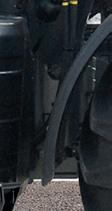




Another area of concern that was highlighted as part of our survey was the need to invest in on-farm infrastructure. Of the producers who responded to the survey, 83% told us they were concerned about the scale of investment required for their enterprise to stay compliant, such as investment in slurry storage. A huge 91% of respondents also said this would be a key issue if they were to expand their business in the future.

Meanwhile, 87% of producers said Government regulation was a key concern over the next few years.



Regarding the wider environmental regulation dairy farmers are faced with, the NFU is continuing to lobby to ensure it is t for purpose and works alongside pro table, productive food production.
It is essential environmental support schemes, such as the Sustainable Farming Incentive, also provide a nancially a ractive o er to dairy farmers.

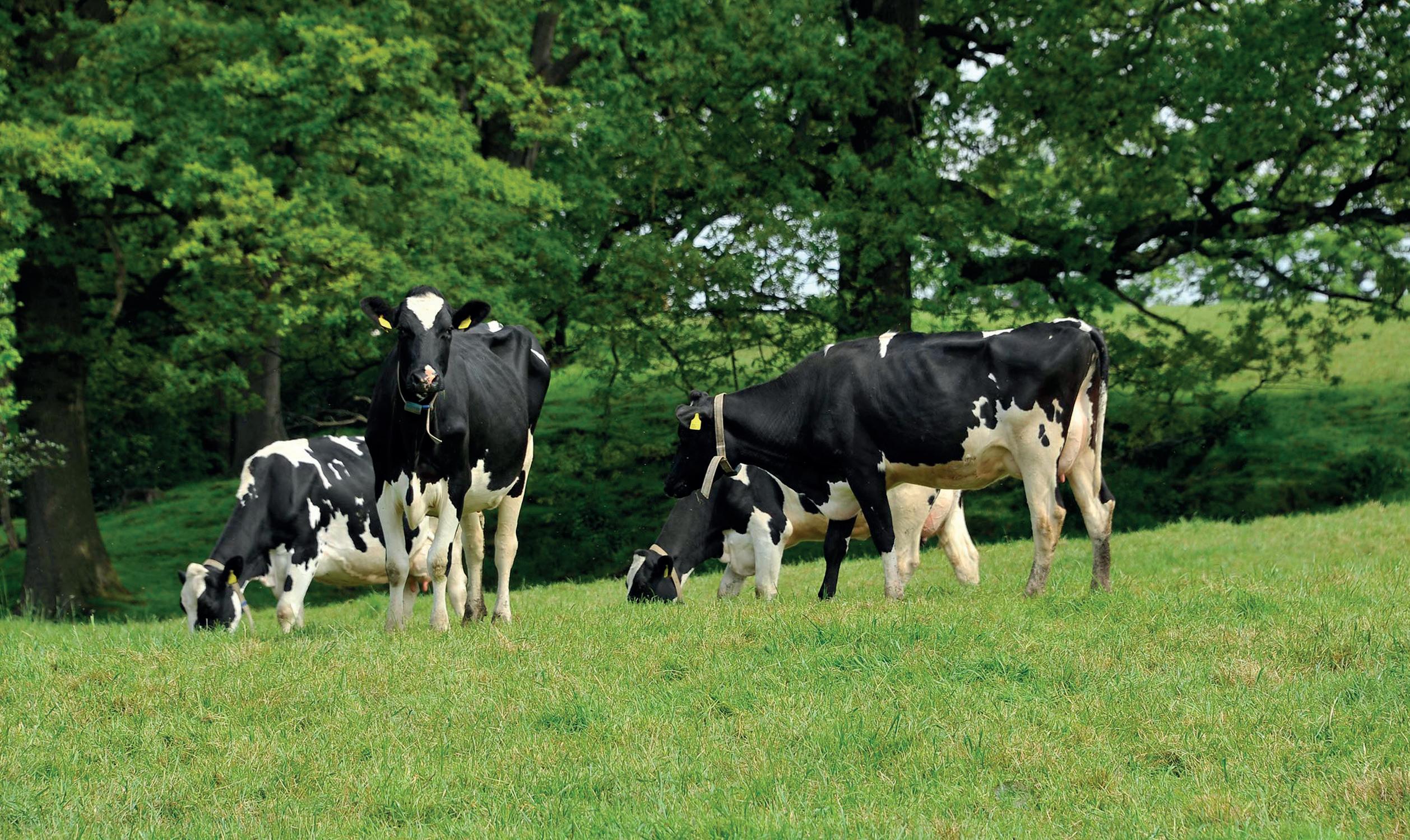
e availability of labour has also long been a concern

in the dairy sector, and this also came out in the survey. Almost three-quarters (74%) of respondents saw access to labour as a barrier to the growth of their business.

To encourage more people to seek careers in the industry, it is vital that dairy is an a ractive, pro table, and exciting sector to work in – long-term, resilient dairy businesses are key to achieving this.
It is abundantly clear that we are facing a crisis of condence among Britain’s dairy farmers. e evidence from our survey shows that, now more than ever, we need to reverse this trend of boom or bust and invest in resilient and collaborative dairy supply chains.
However, I do believe that the UK dairy sector has a bright future, particularly with increasing domestic and global demand for our products.




To ensure we maximise our potential, it is imperative that Government continues to work with us to ensure we have the right environmental, regulatory and trade framework in place to support the production of climate-friendly sustainable food.

“ It is abundantly clear that we are facing a crisis of confidence among Britain’s dairy farmers
New technology which disrupts bacterial communication is proving successful in on-farm mastitis control and could replace antibiotic treatment. Katie Fallon reports.

Mastitis continues to be one of the most costly diseases affecting the UK dairy industry, and while antibiotics have traditionally underpinned mastitis prevention and treatment, increasing concern regarding antibiotic resistance is putting pressure on farmers to seek alternatives.
In response to this, Animal Health Vision (AHV) has developed an innovative approach to treating both mastitis and other animal health issues without the use of antibiotics. Jan van Dijk, veterinary technical adviser at AHV, explains how this new technology provides cows with the tools to deal with bacterial infections without the need for antibiotic intervention.
Dr van Dijk says that during a bacterial infection individual bacteria unite and work together to form a colony, which is much harder to remove than individual ‘freeliving’ bacteria. He explains the bacteria have sensors on their surface which pick up messages sent by other bacteria, and when enough
of those messages are received, the bacteria will begin to colonise and take over the cow.
It is during this time that the bacterial colonies will form a mucous layer known as a biofilm to protect themselves, which is practically impenetrable for both the immune system and antibiotics.
Dr van Dijk says: “Within this biofilm, the bacteria can multiply, and they are protected from the immune system of the animal as well as from antibiotics.”
Using bacteria cultured from mastitis milk, AHV tested whether the important and contagious udder colonisers, Staph. aureus and Strep. agalactiae, as well as ‘environmental’ bacteria, e.coli, Strep. uberis and Klebsiella pneumoniae, were able to form a biofilm.

Results showed that all bacteria tested were able to build this protective structure. After developing a bioactive molecule to break down the biofilm, AHV proved that this molecule was able to remove the biofilm produced by all five bacterial species.
Dr van Dijk says the bioactive
molecule both interferes with the communication between the bacteria required to form a mucous layer and breaks down any existing biofilm.
He says making individual bacteria available allows the cow to deal with the infection itself. To support this, plus optimise the animal’s immune system and general metabolism, the cow is then assisted with AHV’s immune-modulatory treatments and nutritional support.
“The whole idea is that we are giving the cow the tools to deal with the infection herself. If there are a lot of bacteria in the udder which are sitting in the biofilm, the cow can no longer remove them.
“So, what we are doing is breaking down the biofilm so all the bacteria are available to the cow so she can now deal with them, employing her own immune response.”
Dr van Dijk says a key element of the technology is putting the tools in the hands of the farmer; it is a non-prescriptive medicine, which is administered orally. Additionally, the bioactive molecules do not carry any milk withhold. Therefore, the cow can continue to be milked without any concerns regarding milk tank failures.
While the treatment can be used reactively, AHV is focused on prevention rather than cure. Dr van Dijk explains that for optimal results
The whole idea is that we are giving the cow the tools to deal with the infection herself
DR JAN VAN DIJK
Animal Health Vision has developed a bioactive molecule which can break down the biofilm produced by harmful bacteria such as Staph. aureus and Strep. agalactiae.

Neck collars and eartags used by SenseHub® to detect heats and monitor rumination and health parameters in dairy cows can also be used as ID tags for compatible milking parlours and automatic shedding gates.
When paired with a compatible sorting gate, the data collected by the SenseHub® system can be used to automatically segregate cows for artificial insemination (AI) or those which are showing suspected signs of ill health and need additional management or veterinary intervention.
the tablets are best administered routinely to prevent a bacterial load from building up in the udder.
As a result, AHV o ers an udder herd health programme for preventative treatment where, a er applying various orally administered boluses, the udder is cleansed at the beginning and end of lactation.
He says the routinely administered tablet works for seven days and should be administered one week post-calving, and again between four and eight weeks prior to the cow being dried o .
An immune-modulating tablet is given at the same time to ensure the cow’s immune response does not damage the udder tissue.
In addition, two weeks before and one week a er calving, the rumen and the liver of the transition cow are further supported by a booster
tablet to help produce an e ective immune response.
Dr van Dijk says: “It is completely new what we are doing, and it does take a di erent mindset. We have been too used to waiting for a problem to occur and then trying to treat it, and it is obvious that it is no longer working.”
He says the removal of the bio lm and allowing the bacteria to be dealt with by the immune system of the cow is a key step towards both increasing treatment success and reducing antibiotic use.
“I think, ultimately, it could replace antibiotic use for mastitis treatment altogether. ere may always be cows that, for one reason or another, may need support from antibiotics, but if you go down the preventative route, it is possible. In fact, some of our herd health programme farms are not using any antibiotic tubes at all.”
Automating the drafting process reduces the requirement for skilled labour and eliminates the need to visually identify each cow as they pass through the parlour.

It also removes the need for staff to leave the milking parlour to segregate animals – a process which can be time consuming for staff and stressful for animals – and eliminates the scope for human error, thereby ensuring every animal is inseminated or treated at the optimum time.
The SenseHub® smartphone app can

also be used to manually select any additional animals which need to be segregated from the herd.
In addition to segregating animals out of the herd, SenseHub® also sends automatic SMS alerts to highlight potential health issues, often before any clinical symptoms have been seen. This enables herd managers to inspect cows sooner and investigate why the animal’s rumination has fallen away or why the animal’s activity pattern has been disrupted.
This early intervention allows sick cows to return to full health sooner and enables herd managers and farm vets to put plans in place to prevent underlying health or nutrition issues developing into something more serious.
Vet Graham Shepherd says there are common misconceptions about colostrum pasteurisation for calf feeding. Wendy Short finds out more.
Producers who pasteurise cow colostrum will o en report an overall improvement in calf health, says Graham Shepherd, of G. Shepherd Animal Health. is, he says, is probably because not only does pasteurisation denature the majority of harmful pathogens, the process also standardises milk temperature and other calf feeding protocols.

He says some producers will install a colostrum pasteuriser in response to a major disease challenge in the herd.
“Pasteurisation can help to tackle diseases such as Johne’s, bovine TB, Mycoplasma and salmonella. Successful Johne’s control, for example, is a ‘numbers game.’
“Pasteurisation will e ectively create a barrier between one generation of the Johne’s bacterium and the next. e most e ective general approach is to implement a range of measures to limit the
calves’ exposure to viruses and bacteria.”
On-farm colostrum pasteurisation is sometimes dismissed due to the belief that it will destroy benecial antibodies, says Dr Shepherd.
“In fact, only about 6% of the immunoglobulins, or ‘good’ antibodies, that are passed from cow to calf for disease protection will be denatured when using a high-quality colostrum pasteurisation machine.
“ is does not represent a scienti cally signi cant gure; pasteurisation does not denature harmful pathogens in the same way as sterilisation.
“Research has demonstrated higher antibody levels and lower disease incidence in calves fed pasteurised colostrum, compared with groups fed the raw product.
“However, excessively high temperatures and extended heating periods will damage immunoglobulins.
“As with any element of mechani-
sation, making sure that the recommended se ings are followed and carrying out the required maintenance are essential factors for maximising the potential for positive results.”
It is sometimes believed that calf milk replacer is a ‘safer’ product compared with on-farm pasteurisation, but Dr Shepherd counters this viewpoint.
“ e dairy ingredients of calf milk replacer are subject to pasteurisation on a commercial scale at a more rapid rate, compared with an on-farm pasteuriser. Both sys-

tems are equally e ective at denaturing harmful pathogens, but on-farm processing allows producers to protect their calves from diseases that are speci c to the individual farm.
“ e antibodies it contains are produced by the dam in response to viruses and bacteria that she has encountered in her environment.”
Another myth is that colostrum pasteurisation will not kill Johne’s bacteria.
“Studies carried out a decade ago proved that specialised colostrum pasteurisers would destroy harmful pathogens and machines have since been improved and re ned,” says Dr Shepherd.
“ e ‘yo-yoing’ of the target temperature must be avoided, because correct temperature is essential for achieving disease control. While it is possible that a minority of pathogens will survive processing, they are unlikely to have any harmful e ect.”
Colostrum pasteurisation can also help with management protocols for calf feeding.
“Colostrum feeds will depend on time of birth, but pasteurisation can be also be used for the preparation of whole calf milk. e machine will heat the liquid for a predetermined time and to a set temperature. is is particularly useful if multiple people are involved in looking a er the calves, as consistency of routine is hugely bene cial to calf health.
“ e pasteurisation of liquids
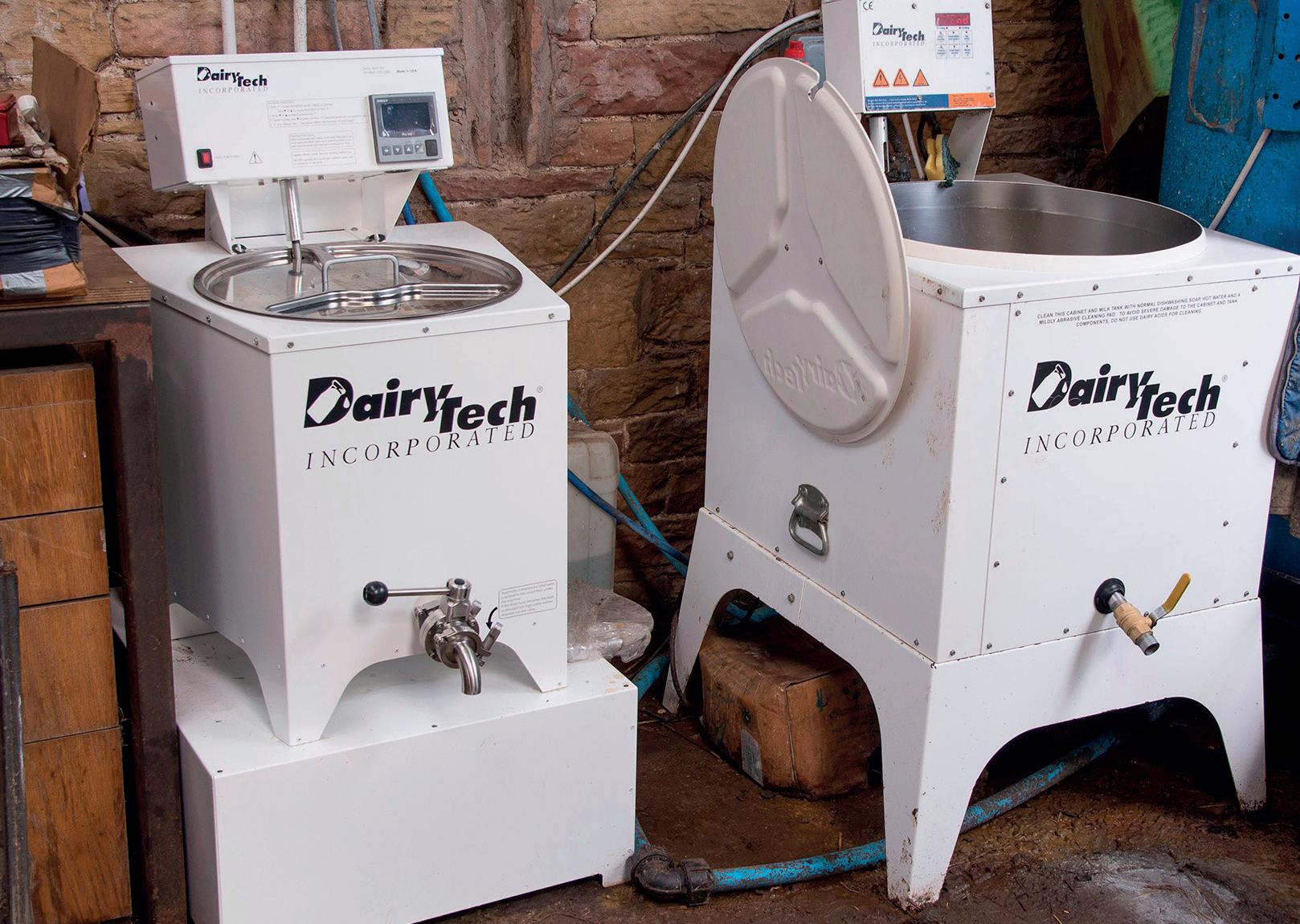
Pasteurisation can help tackle diseases like Johne’s, bovine TB, Mycoplasma and Salmonella
DR GRAHAM SHEPHERDResearch has demonstrated higher antibody levels and lower disease incidence in calves fed pasteurised colostrum, compared with groups fed the raw product.

fed to calves is believed to be been trialled as early as 1935, when researchers in Scotland recorded a growth rate improvement in calves fed pasteurised milk, compared with raw milk.
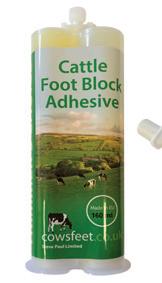
“Today’s machines are extremely sophisticated and they can also be used to thaw frozen, pasteurised colostrum; the process will take about half an hour. e liquid will keep for up to six months if frozen and last for three days in the refrigerator.
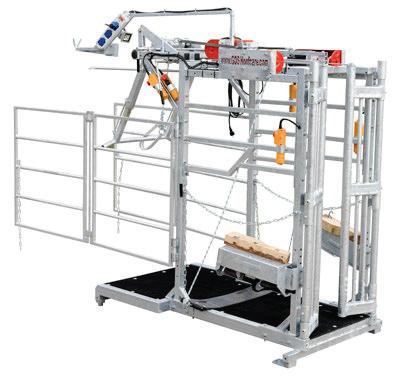

“Maintaining a high herd health status continues to pose a challenge for producers, and while I feel that colostrum pasteurisation is important, it is only one element within a wide range of options for producing healthy calves which will grow into healthy cows that will live a long time and meet, or exceed, target milk yields,” says Dr Shepherd.

JAll colostrum should be heated to 39degC and fed to calves as soon as possible after birth, says Dr Shepherd.
“A large, Holstein-type calf will require four litres of colostrum for its first feed, with a second feed of two litres given 12 hours later.
“The tube-feeding of colostrum is preferable to teat-feeding, as tubing ensures that calves receive the full volume required. However, it should only be administered by a skilled operative who is confident in their ability to follow the correct procedure.
“It is also vital that the treatment is given


in a calm manner and in a quiet environment. Tubefeeding can become quite frustrating if calves resist the procedure, and they may need to be gently restrained.”
He recommends testing all colostrum before feeding, as quality can vary greatly.
“Several options are

available for colostrum testing, including the use of a floating colostrometer –which is inserted into a tube containing the liquid –a digital refractometer or a Brix refractometer.



“Any sample with a reading below 22% should be discarded, or it can be fed to older calves. Ironically, good dry cow management can have an adverse effect on colostrum quality, as cows will go straight into high production immediately after calving. This can lead to a dilution of the valuable components of the colostrum and it may need to be fortified using a colostrum powder.”


It is vital that treatment is given in a calm manner
DR GRAHAM SHEPHERD
Starting off in dairying is a tough challenge for anyone, but one young couple in Ontario have bucked the trend and are now running two farms. Chris McCullough reports.
First generation dairy farmers Eric and Courtney Veldhuizen own and operate Velstar Dairy, which sees them milk 70 cows on one farm at Mossley and another 80 cows on a second farm at Tillsonburg.
Eric’s career in dairying dates back to 2009 when he started o with 17 cows in a rented tie-stall barn at Woodstock, while working full-time as the herdsman at his uncle’s dairy.
Eric says: “In 2018, the farm at Mossley came up for sale and our o er was accepted. at really started Courtney and I o on our own as full-time dairy farmers.
“At that time Mossley was an 80-cow, tie-stall unit and in order to have the new purchase make nancial sense, we decided to continue milking cows in the rented tie-stall farm, which had increased to 60 cows by then.”
Two years later, the Veldhuizens were successful in buying their second unit, this time at Tillsonburg, to where they moved all their stock from the rented farm.
“We nished our rental agreement at the Woodstock farm and moved those cows to Tillsonburg, which had a free-stall barn, so is more comfortable for the animals,” says Eric.
“By January 2021, the Tillsonburg farm was milking 70 cows in a parlour and at Mossley there were 80 cows milked in the tie-stall.

“As things progressed our
space was ge ing tight at both farms and we were doing a lot of trucking youngstock to Tillsonburg and back to Mossley to calve in order to have enough room.”
So to gain extra room, Eric and Courtney built a new free-stall barn incorporating two Lely robots at the Mossley location.
e new barn was completed in December 2022 and has features including 152 milking cow stalls, perimeter feed with a Lely Juno feed pusher, tipping water troughs, fans and stalls for 28 dry cows, along with a 4,000 square feet area for calving.
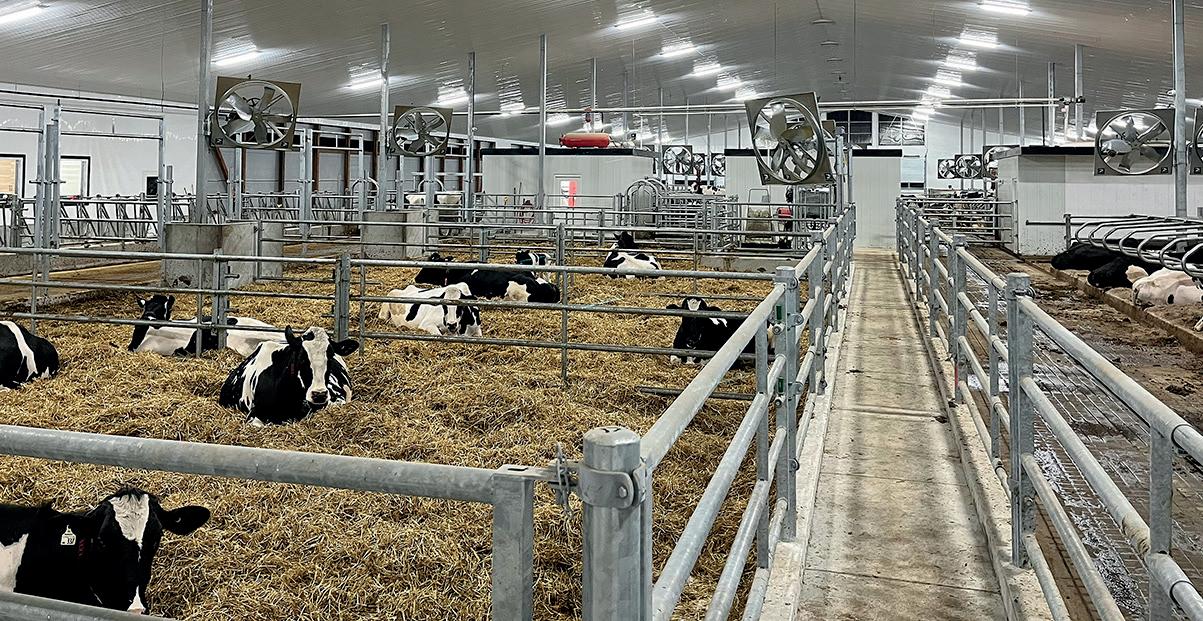
Eric says: “At the Mossley farm, the 70 cows are milked on average 3.2 times per day through the robots.
“Current milk yield is averaging 45 litres per cow per day at 4.15% fat. At Tillsonburg we
milk 80 cows twice per day in a double-eight parlour.
“We send our younger cows to the Tillsonburg farm since it has a sla ed barn with mats and shavings.

“Milk production at Tillsonburg averages 34 litres per cow per day with a 4.15% fat.
Rations are di erent at each farm, with the Tillsonburg unit currently using a purchased commodity mix, purchased minerals, and corn silage and haylage.
e Mossley farm feeds triticale, corn silage, a complete feed and a robot-speci c pellet.
Eric says: “Over the past three years we have grown more acres of triticale and are nding great results in cow performance, especially for increasing bu erfat.
“I also love the idea of having a crop growing over the winter on ground that can then have corn planted a er the spring harvest.”
Technology plays a huge role on the farms for Eric and Courtney allowing them to shape their work life balance in their favour.
Courtney says: “We are loving our Lely robots and the fact that they are allowing us to continue managing our farms ourselves while still giving us the freedom of our schedules with very young kids.

“In the future we are looking into new feeding strategies that would give bene ts in terms of labour savings and precision.
“We feel our situation is quite unique in Canada. We are young and still very much looking to grow within the dairy sector.
“We would love to milk more cows, and feel the way we are currently positioned, gives us a variety of options to do that.”
She adds that both farms have room for continuous improvement.
“Our old Mossley tie-stall is currently vacant and so our next project will be transitioning that barn to young calf housing.
“And, installing robots in at our Tillsonburg farm would also be a

Correct management in the transition period, including meeting greater needs for trace minerals, underpins milk yields, fertility and profitability in the subsequent lactation.
Farm facts
rAll the milk is sold to Dairy Farmers of Ontario
rCows are all Holstein, with artificial insemination sires selected on type with a particular emphasis on fat and protein

rAll cows across both units are fed indoors once per day via a pull type New Direction Equipment mixer
potential future project, if the correct resources were in place.”
Buying dairy farms in Canada and the associated quota on top of that costs a lot of money, and there is always huge demand for such investments from both locals and foreign parties.
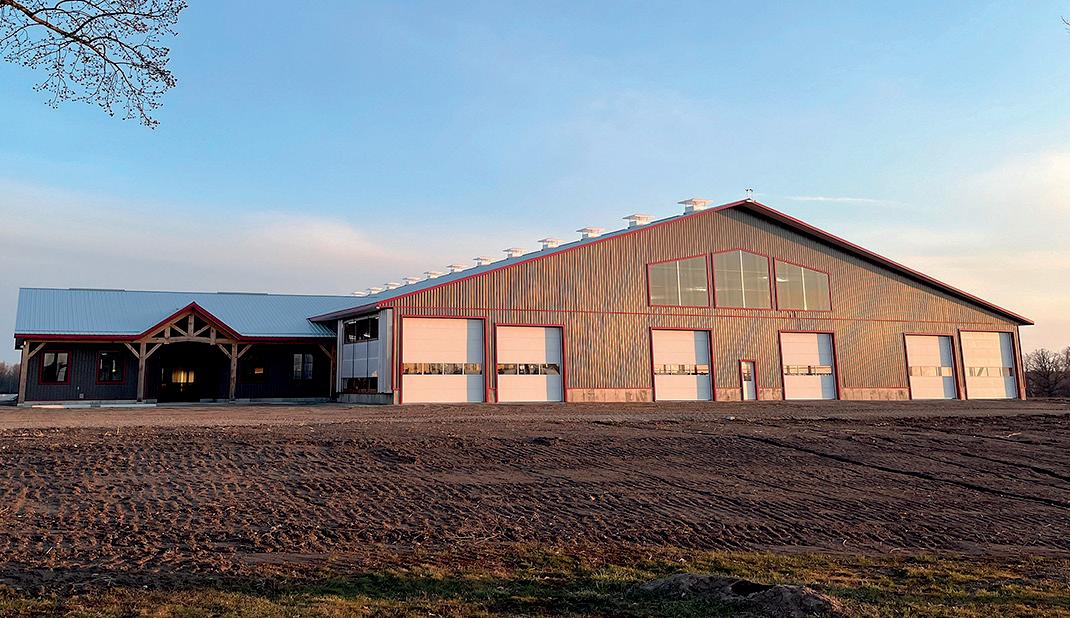
Eric says: “We are rst generation farmers. Normally the average Canadian dairy farm is generational and, for us, coming up with the capital to compete on farm and land purchases against well-established farmers is always tough. However, we believe if we can focus on ourselves and nd our greatest e ciencies, we will thrive.”
Trace mineral supply is a cornerstone of successful transition cow management, says Kate Ingram, ruminant technical adviser at Virbac UK. This is a period in the cow’s cycle when many things can go wrong, including oxidative stress, an imbalance of free radicals and antioxidants, which can lead to cell and tissue damage, impacting her health and performance.
Ms Ingram says: “Trace minerals, in particular zinc, copper, manganese and selenium, are vital components of antioxidant enzymes which are required to combat this imbalance.”
In the last trimester of pregnancy, there is a natural decline in the trace mineral status of cows, due to an increasing demand for these for calf development.
Feed intake is significantly reduced pre-calving, which can result in reduced trace mineral intakes, so even with dietary supplementation, trace mineral stores in the body can become depleted.
Ms Ingram says: “During the transition period, even in apparently well-supplemented cows, trace mineral deficiency can occur.”
That maternal deficiency in late pregnancy can also impact her calf, as trace minerals are required by calves for immune function. Deficiency can increase the calf’s susceptibility to scour, pneumonia, navel ill and joint ill. An option for supplying those trace minerals ahead of that high demand period is Multimin™, an injectable for cattle which contains zinc, copper, manganese and selenium.
Trials have shown improvements in parameters such as fresh cow disease rates in cows supplemented with Multimin™ during the transition period and post-calving, including reductions in both clinical and subclinical mastitis rates¹.
Ms Ingram says: “As each case of mastitis is estimated to cost £70-£250/ cow/year, considering the effect on mastitis alone represents a real return on investment.”
In the same study, cows treated with Multimin™ also had lower rates of stillbirth and endometritis than the control group¹. As Multimin™ is a prescription-only medicine, Ms Ingram recommends farmers talk to their vet about how and when to introduce it.
For more information, scan the QR code or go to farmersguardian.com/virbac-dairy-bitesize

MultiminTM solution for injection for cattle contains: zinc (60mg), copper (15mg), manganese (10mg) and selenium (5mg). Further information available from the package leaflet, datasheet or SPC or by contacting Virbac, Unit 16 Woolpit Business Park, Windmill Avenue, Woolpit, Bury St. Edmunds, Suffolk IP30 9UP. Tel: +44 (0) 1359 243 243; email: enquiries@virbac.co.uk. Advice on the use of this medicine or alternatives must be sought from your veterinary surgeon. Use medicines responsibly noah.co.uk/responsibly. References: 1. Machado, V.S. , et al. Effect of an injectable trace mineral supplement containing selenium, copper, zinc and manganese on the health and production of lactating Holstein cows. The Veterinary Journal (2013).
Cross-breeding for longevity and switching to autumn calving, aided by herd monitoring technology, has led to performance improvements for the Humphry family. Dairy Farmer reports.
Since switching from a spring and autumn calving pattern to an autumn-only system 10 years ago, Matt Humphry has also been experimenting with cross-breeding and a herd monitoring system has been recently installed to improve heat detection and labour efficiencies.

Matt, who farms with his parents – Mark and Belinda – at Southey Farm, near Taunton, where the family has been a tenant on the Duchy of Cornwall Estate for five generations, has also increased cow numbers from 270 to 400 over the last six years.
He says: “We started experimenting with cross-breeding 20 years ago when we had the opportunity to buy some Jersey cross heifer calves at a good price.
“Since then, we have tried everything from Swedish Red and Montbeliarde genetics. But it is since we started using Norwegian Reds and Fleckviehs that we have seen some really significant gains, with the strong feet of the Norwegian Red and sturdiness of
the Fleckvieh helping us to gain an extra lactation per cow.”
The herd grazes for as long as pos-

sible throughout the year, with turnout date dictated by the weather.
Matt says: “Last year the cows went out on January 31, but this year they did not see fresh grass until April 12. Even then, the unpredictable weather meant they had to come back in a week later, but it is that kind of challenge which keeps the job interesting.”
The management of the herd has also been kept interesting over the years, with successive tweaks to the herd’s calving schedule.
Matt says: “We originally calved all year round, before splitting the herd into spring and autumn groups 10 years ago.
“The summer gap gave us breathing space to concentrate on silaging and harvest, but the spring group proved to be more trouble than it was worth, with any cows which failed to conceive in autumn being pushed into the spring herd.
“By that time, they were either overweight or too old, which meant they continued to struggle to conceive or needed assistance at calving.
“We have therefore moved everything to an autumn calving pattern, which gives us more time to focus on first cut silage and maize drilling.”
Matt and Mark have also
We originally calved all year round, before splitting the herd into spring and autumn groups 10 years ago
MATT HUMPHRYEach of the 400 milking cows wears a SenseHub neck collar to collect 24/7 fertility and health-related data.
•
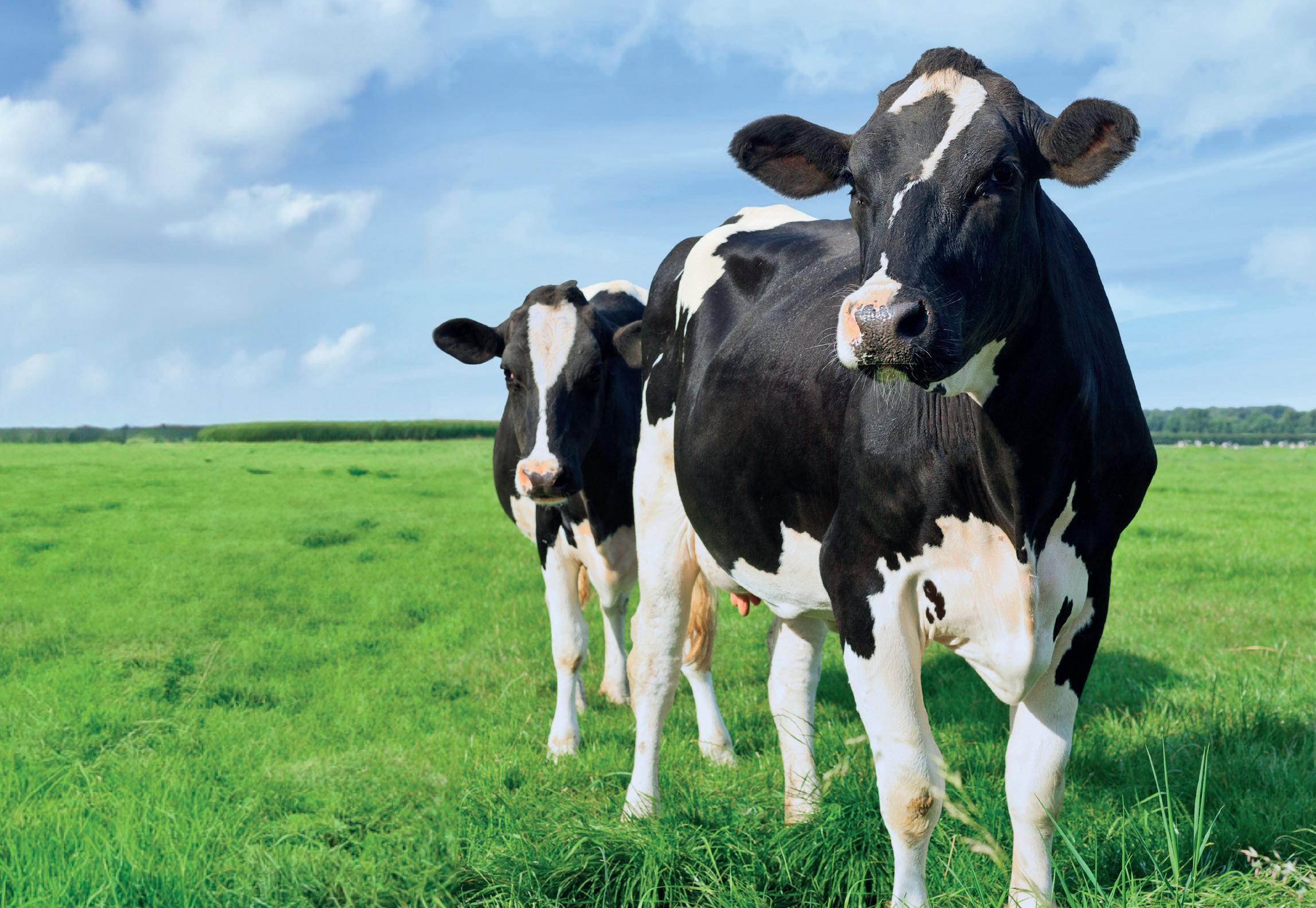
expanded the farm by taking on the estate’s neighbouring farm to rear youngstock and grow additional forage.
Ma says: “Our plan was to increase cow numbers by purchasing 100 cows, but that idea was abandoned a er the rst group of 50 cows, when a salmonella outbreak was linked to a previous farm sale purchase which caused 30 to abort.
“We therefore switched our focus to breeding our own heifers, using sexed semen on breeding stock and everything else put to British Blue beef semen.
“Our aim is to calve everything in a very tight window so we are constantly looking for ways to improve conception rates.”
To that end, a herd monitoring system was installed 10 days before the November 2022 breeding window opened.
Ma says: “We had previously applied for a grant to help with the investment, but were rejected because we did not score highly enough. at was probably because we had already implemented a lot of
the environmental schemes which would have boosted our rating.”
In the end, the decision to invest was forced when Mark was scheduled to have an operation on his foot which would have le Ma short-handed on-farm.
He says: “We knew we needed to get something sorted quickly, so we approached four manufacturers, eventually choosing the SenseHub system.”

Prior to installing the new system, tail-painting was used to detect heats – a system which not only required sta to check the herd throughout the day, but also at 9pm.
He says: “We were checking for heats for at least three or four hours a day and still pu ing too many cows in front of the vet only to nd out that many of those we thought were not cycling properly had been in heat.
“We therefore installed the SenseHub collars to improve heat detection, but their second function – to assess the health of cows –is now just as important.”
While the system cannot diagnose speci c ailments, it can detect the behavioural pa erns associated
with health problems, such as decreased activity and reduced rumination.
Ma says: “We receive a text alert every time the collars detect a change in behaviour, which means we can inspect the a ected animal 24 hours ahead of time.
“We can then get her into the sick bay before she deteriorates or goes down in a cubicle and treat her sooner for whatever ailment she is su ering from. We are losing less milk as a result and our antibiotic usage has gone down.”
Within a couple of weeks of the collars being ed, the system was already highlighting more heats than could be seen through visual inspections.
Ma says: “ is gave us the con dence to stop our evening checks, which makes a huge di erence to our quality of life.
“We have seen an improvement in conception rates, with the number of days to rst service falling from 83 to 69 days, and days to pregnancy falling from 102 days to 85.
“Submission rates have also improved from 77% to 97%, with the percentage of cows pregnant by 100 days in-milk increasing from 49% to 75% and the herd’s expected calving interval coming down from 382 days to 365 days.
“Some of this is a result of delaying the rst service date by 11 days to consolidate the block, with the app’s ability to tell us exactly when each animal came into heat and when she will be most receptive to arti cial insemination also being a key factor.
“ e system has also taught us that we were previously inseminating cows too early, which meant we would invariably end up serving a lot of cows twice.
“We now have fewer empty cows at the end of the breeding season, which is vital to keeping the calving pa ern as tight as possible and we have been able to knock three weeks o our calving block for 2023.
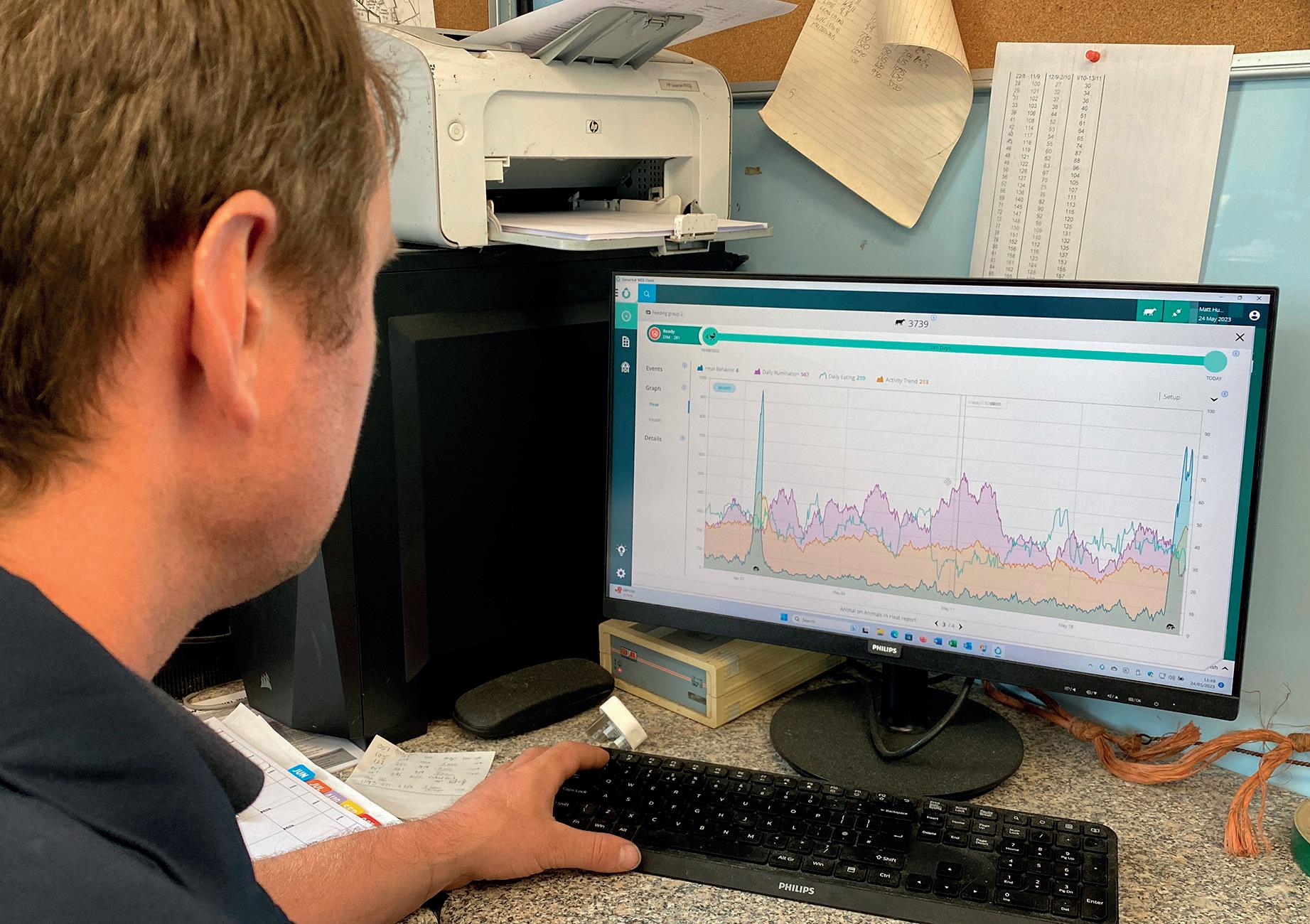
“We are retaining more young cows as second calvers simply because we are detecting more silent heats.”
e system has also changed the farm’s culling protocol.
Ma says: “With more cows ge ing back into calf sooner, we are no longer forced to cull cows due to poor fertility. Instead, culling decisions are based on health parameters, which means the herd is more e cient and more productive.”
The unpredictable weather meant [cattle] had to come back in a week later, but it is that kind of challenge which keeps the job interesting
MATT HUMPHRYThe SenseHub app informs the herd management team when cows are in heat, when they will be most receptive to artificial insemination and when a potential health issue is developing.
For more information speak to your local ForFarmers Account Manager or visit >
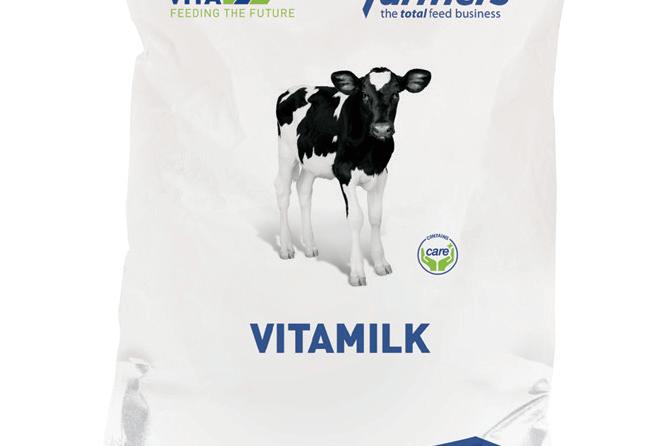
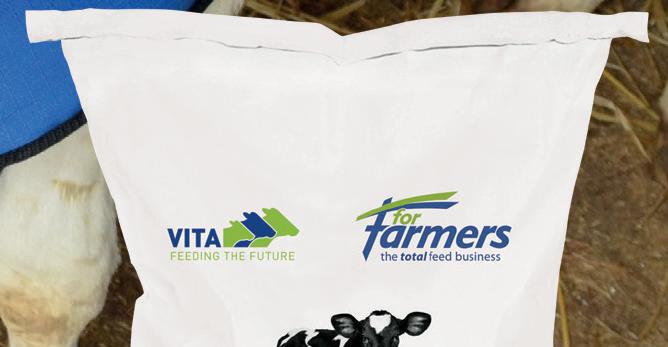


Switching to cross-breeding has improved herd health and fertility at one Devon dairy, with conception rates lifting by almost 20% across the herd and calving interval falling by 45 days. Dairy Farmer reports.
Patrick Cock, who farms at Younghouse Farm, near Ashburton, Devon, alongside his brother Graeme, previously milked pedigree Holsteins three times a day with yields peaking at 12,000 litres.
Holsteins predominantly calved in summer, but the herd’s calving index had slipped to 420 days, extending the block significantly to 10 months. Patrick says he had also become disillusioned by higher vet costs.
The transition to ProCROSS, which uses VikingHolstein, VikingRed and Coopex Montbeliarde, and subsequent fertility gains, enabled Patrick to move to back to a lower cost system and get cows back out to grass.
Patrick decided to start using VikingRed semen on his Holsteins in 2012 and then served the two-way cross heifers to Montbeliarde.
The farm has been shut down with TB for 20 years, and Patrick admits this created
initial hesitation and he was reluctant to cross-breed 100% of the herd.
He says: “We have lost 1,200 reactors to TB over
the years and I dithered a bit because I was worried about losing my pedigree status and how it would affect TB valuation.
He says: “It is a big step when you have had a pedigree herd and I started by doing it for periods of the year and bred back to Holsteins.”
But he now says that although he no longer commands pedigree valuation for TB-stricken stock, he says the benefits outweigh this.
For example, cull cows have a higher value of £150

The lower production is countered by lower input costs
PATRICK COCK
on average, with the Montbeliarde improving fleshing ability.
e transition in breeding led to a complete reversion of his system. A er milking the cross-bred cows three times a day initially, they went back to twice a day in September 2019, enabling Patrick to ful l his desire to get cows back outside to graze.
Patrick says: “ e animals were producing 750kg of milk solids when we were milking them three times a day –only 100kg less than the

rMilking 600 cross-bred cows
rFarming 607 hectares (1,500 acres), which is a combination of rented and owned land

rSpring and autumn calving
rCows milked twice daily through a 40:40 parlour
rYielding 4.45% butterfat and 3.63% protein
rSupplying Arla
pure Holsteins, but with fewer problems. Heifers were doing 10,000 litres easily.”
Having reduced the calving block suitably, Patrick felt it would reduce labour pressure by going back to his roots and running a grass-based system.
Two blocks
Cows now calve in two blocks. About 230 cows calve from February for 13 weeks. e remaining cows calve from July for 17 weeks.
Patrick says: “Animals are averaging 660kg of milk solids annually. e lower production is countered by lower input costs.”
Heifers have always been reared outside from one month old on a milk taxi. ey stay on grass for their rst winter and are supplemented with a blend.
Patrick says the hardiness of the cross-bred cows is be er suited to outwintering.
e grazing platform is just 100 hectares (247 acres), so autumn calvers which are safely in-calf take priority and will graze from March. Spring
• NWF Fusion dairy feed range is free from soya, soya hulls and palm kernel.

• Formulated to offer cost effective rations for early lactation and high yielding cows.
• Rations feature high levels of digestible fibre, starch and protected proteins to aid rumen function and cow health.
• Inclusion of Ultra Pro-R, a high-quality vegetable protein with a high level of DUP, and Ultra Starch-W, a protected wheat, aiding rumen health to achieve feed utilisation.
• Sustainable sourced raw materials utilising British and/or European grown crops helping to reduce carbon footprint whilst keeping raw material provenance in mind.
• Manufactured at NWF UFAS accredited feed mills in Cheshire, Cumbria and Devon.
calvers join them when there are su cient covers later in the season.
At peak, the platform will be stocked at four cows/ ha (1.6 cows/acre), with the stocking density on the platform constantly being balanced as autumn calvers are dried o .
Cows are rotationally grazed, with grass covers measured weekly and recorded using AgriNet.

Patrick says: “We graze slightly higher covers in spring, because I am nervous about grazing myself into a drought at such a high stocking rate on the platform, so we have a longer round of 30 days.”
Multi-species leys are also being used to improve drought tolerance. is spring, 20ha (50 acres) of a herbal mix of chicory and plantain was over-seeded a er silage or grazing. It established well and is currently being grazed by late autumn calvers.

e herd is now 98% ProCROSS and Patrick says running a three-way breeding programme is simple.
He says: “Breeding is very simple and the upside is I do not have to worry about inbreeding because we are
cross-breeding, which brings hybrid vigour.”
Leg pedometers are used to monitor heats alongside scratch cards, with the farm undertaking their own arti cial insemination.
Although computer breeding records are kept, visual aids are used to make breeding easier.

Coloured bu on tags are inserted into the ears of heifer calves during rearing.
Montbeliarde-sired animals receive blue tags and they are mated to Holstein. VikingRed heifers are given an orange tag, and these are served to Montbeliarde, and Holsteins have white tags and get VikingRed semen.

Patrick says: “It is not uncommon to have a lot of Holsteins with white faces the rst time around. [But] once you have been through the cross once, the markings are not as characteristic, so the bu on tags are very helpful.”
e best cows are served with sexed semen and, a er seven weeks, will be mated to British Blue sires. Heifers are synchronised and served to sexed semen; Aberdeen-Angus and Longhorn bulls sweep up
any returns. Conception rates have improved from 28% to 44%, on average, since 2012. With 70% of cows calving within six weeks in autumn, the target is now to shorten the autumn block to 12 weeks in total and continue to drive herd improvements.
We graze slightly higher covers in spring, because I am nervous about grazing myself into a drought
PATRICK COCKColoured button tags are used as visual aids to make breeding easier. Multi-species leys are being used to improve drought tolerance.
Ruminant
Trouw Nutrition GB
Includes
HYDROXY TRACE MINERALS
• Improved fibre digestibility


• High relative bioavailability
• Healthier, more productive animals
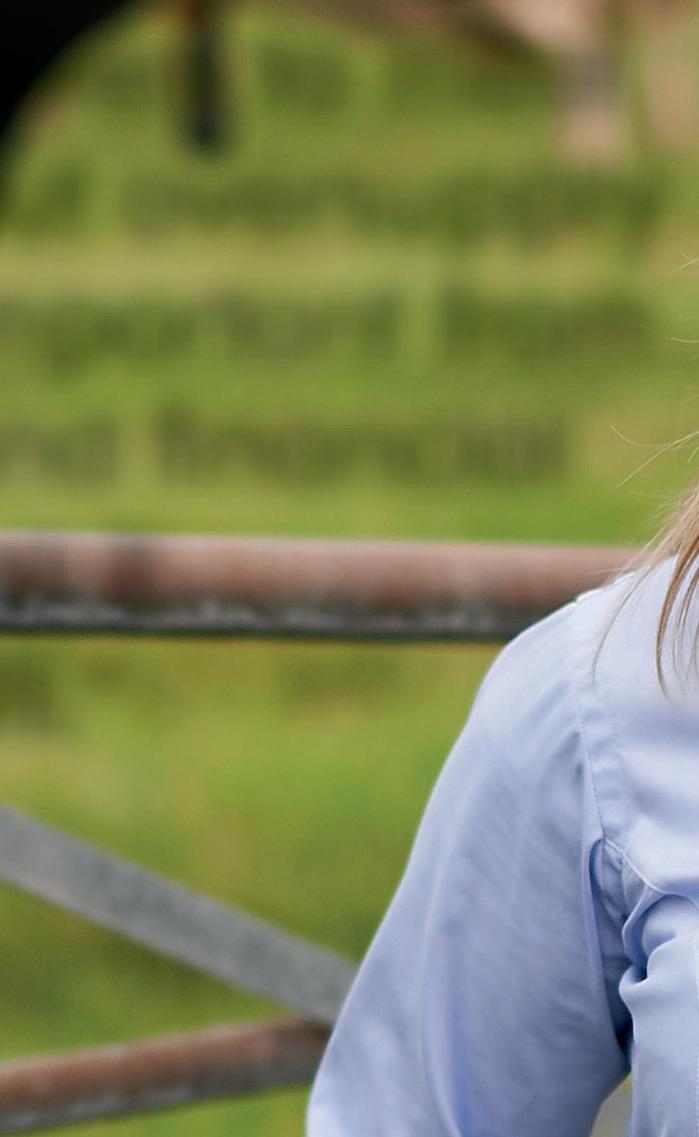

For more information visit trouwnutrition.co.uk/maxcare

“Balancing mineral levels to meet requirements, without oversupply or undersupply, is important from an environmental and financial perspective – we call it Responsible Minerals.”
Alicia Bexon
Nutritionist
DeLaval has recently completed the installation of 24 VMS V310 robots for Lonholm Agro in Denmark, making it the largest batch milking robot farm in the world. Dairy Farmer reports.

Batch milking is not a new concept and worldwide there are 150 DeLaval VMS robots installed using this method with herd sizes from 250 to 2,000 cows.

Use autumn to reflect on what can be done a little better next year to make even better silage. Here, two experts share their advice.
Attention to detail can make the difference between good and great silage, but you need to measure to manage.

Taking a closer look at soil nutrition is a good place to start, according to Yara agronomist Philip Cosgrave.


He says: “There is now a legislative requirement to sample soils for phosphate, potash and pH on cultivated land in England and this includes grassland which has received fertiliser or been reseeded. Elsewhere, while it is not a statutory obligation, it is good practice.
“Soil pH is a critical part of the fertility jigsaw, both in terms of availability of nutrients to the plant and also to enable the industry to reach climate net zero ambitions.
“A correct soil pH will require less nitrogen fertiliser to maintain productivity and there is evidence nitrous oxide emissions will also be lower.
“Leave about three months between applying any fertiliser or manures and soil sampling to allow any nutrients to stabilise.
Sponsored by
However, it is a unique milking system. Robots are stationed in a collecting area and cows are dra ed in groups to visit the group of robots.
Only one member of sta is required to manage the pro-
cess and clean down the area, making batch milking labour e cient.
At Lonholm Agro, owner Klaus Jacobsen, is developing a new business at an existing farm site. New buildings and

picture of what deficiencies need to be addressed.”

When making silage, the importance of chop length should not be overlooked. It can influence intakes and longer chop lengths can promote better rumination and prevent slippage in the clamp when the moisture content of grass is higher.
Ben Davies, product manager with Krone UK, says the degree to which chop length can be easily adjusted will depend on the machine used for harvesting.
The farm has 830 Jersey cows, with plans to increase that to 2,000.
“Carrying out a physical examination to analyse the texture and estimate the sand, silt and clay content provides valuable information about the ability of soils to hold on to nutrients.
“A broad spectrum analysis to include calcium, sulphur, some key trace elements and the cation exchange capacity is beneficial as it will provide a more comprehensive
He says: “Forage harvesters give greater flexibility, as chop length can be altered by both changing the number of knives on the drum and varying the speed which the grass is fed into the machine via the feedrolls.
“Manufacturers offer different knife and drum configurations to give a range of chop lengths. The faster the grass is fed into the drum and the more knives on the drum, the shorter the chop length.
“Feed roll settings on forage harvesters can be easily adjusted between fields or
the batch milking robot set up were researched and compared to more conventional methods before he made his decision. He says: “I wanted this to be
farms to give the desired length to suit the weather conditions and farmers’ requirements.”


Where a forage wagon or baler is being used, there is a fixed knife bank and the grass is pushed through with a feed rotor. Chop length is determined by the distance between the knives, says Mr Davies.
“For forage wagons and balers, removing half the set of knifes gives more space between each knife and the chop length is therefore longer.”
Find out more at farmersguardian.com/bettersilage, or scan the QR code

a dairy that could be scalable without having to find additional labour. The DeLaval team introduced me to batch milking and took me to visit other farms, including one in the Netherlands, before I made my decision.”
He is currently milking 830 Jersey cows with 180 cows passing through the robots per hour.
The Jerseys were incumbent, and he had no reason to change, believing that a traditional breed could be hardier.
Soon he expects the robots to milk more than 200 cows per hour as the system beds in.
“I am really happy with how well the cows have adjusted to the system.
“I managed the first six
milkings myself and found it easy.
“The older cows were the easiest to work with. The heifers took a little more time to adapt, but now it is equal. I already have the confidence to grow the herd to 1,400 in the next 12 months and would like to reach 2,000 in the future,” he says.
Unlike automated milking systems, batch milking enables cows to be milked in a similar way to a conventional parlour.
Cows are drafted two or more times a day and visit the robots instead of a stall or bail in a conventional parlour.

Unlike traditional methods, there is no skilled labour required to manage each milking, the cows visit the robots voluntarily and leave through gates along a passage back to the shed.
Mr Jacobsen says: “Controlling the frequency the cows are milked is important for us, so an automatic system in which robots milk cows based on permissions was not what we wanted.
Our range of self-propelled and single, twin or triple auger trailed feeders with capacities from 5m3 up to 46m3, all available with a wide range of specications and options, makes BvL the ideal solution for all your livestock TMR needs.

 Klaus Jacobsen
Klaus Jacobsen

“The system is working well at two milkings a day. We could milk three times a day, but at the
Powerful mixing augers with adjustable knives ensure thorough mixing of all types of feed, including bales. Gentle mixing, consistent ration quality.

The patented EDS discharge system provides an extremely consistent, uninterrupted loose ow of forage to both sides if necessary, even without the optional cross conveyors or elevators.
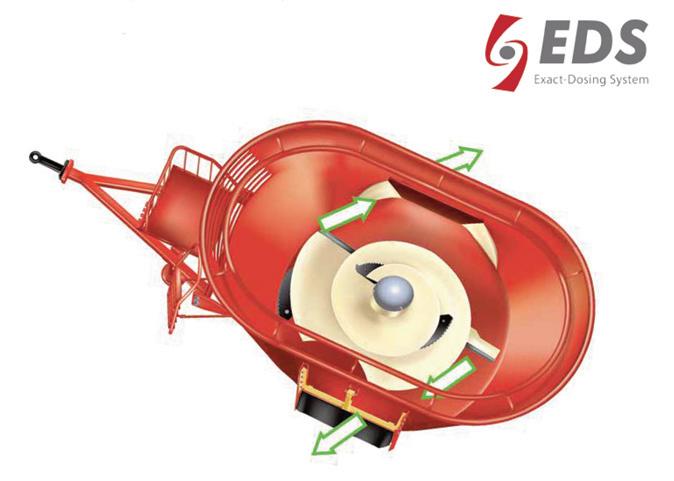
North:
moment it would not bene t the farm as milk prices are not in our favour.”
ere are 700 hectares (1,730 acres) of land at Lonholm Agro with 70% allocated to forage production.
e cows are fed a high forage diet and Mr Jacobsen is keen to stress that he wanted a milking system that did not rely on high volumes of concentrate to motivate the cows.
“ e cows are motivated by food, but not while they are at the robot. ey want to be milked and return to the feed pass as quickly as they can because they know fresh forage will be waiting for them.
“We only feed 400g of concentrate per cow and we will reduce that to around 250g soon.
“We are only feeding at that level now because I stockpiled too much in advance of the dairy starting,” he says.
e cows are averaging 10,200kg of milk per cow per year, and Mr Jacobsen is optimistic that this too will improve as the herd and ration adjusts to the new system.
However, while yield is important, he decided on batch milking with robots as a labour-saving measure.
“With this set up, I can milk with one person and a second
can be cleaning and replenishing forage in the shed to encourage the cows back from the robots.
“With a rotary I would need at least three just milking. Finding labour is tricky in Denmark and the robot set up has made the farm less reliant on sourcing a larger workforce,” he says.
Mr Jacobsen also says the data he receives from the robots enables him to manage and improve productivity while also monitoring cow health.
He achieves this using only his mobile device, enabling him to manage the herd from anywhere in the world.
“I can see yield and use the cameras on the farm to see which cows have been separated
out for foot-trimming or AI. I can use the progesterone testing system to see when a cow needs to be served, track her days in milk, when she peaks and learn from each cycle to make the next be er for her and for the farm,” he says.
e data extends from basic indicators such as somatic cell counts, which are currently at 104, down from 130 at the start of milking, to creating key performance indicators for each cow to optimise individual cow performance.
Individual
e batch milking design concept is unique to DeLaval farms, yet each farm installation is individual. Mr Jacobsen opted not to have any monitors on his robots. ese are the screens used to help sta monitor and manage the robots.


“I can do it on my phone or tablet, so I did not need to buy 24 monitors that a ach to the robots. It is a cost saving, but it is also less to go wrong in the future,” he says.

His dra ing system is similar to those of other batch milking farms with cows being dra ed directly from the shed to a holding area in front of the robots.
e exit however was chosen by Mr Jacobsen to help with swi movement of the cows from the robot.
“I wanted the exit lane to be at least a cow length in width from the robot exit to enable the cows to turn easily and not get scared.
“ e passage is also wider than some batch milking farms to give the cows more freedom of movement,” he says.
He has four groups of cows that are grouped based on lactation, not by yield. Milking time is about four hours with the average time each cow spends at a robot at seven minutes.
Cows with a drop in milk yield are agged up according to percentage reduction. is can be set at a level that Mr Jacobsen chooses.
“We have set tolerances for the cows so the robots will inform me if a cow’s yield is down. is enables me to look for the reason among the data pertaining to that cow.
“However, o en the robot ags up an issue and the cow is moved to the separation area to be seen by a member of the team,” he says.
“In a batch milking system, any problem cows do not slow down the rest of batch signicantly because there are still many other robots operating for the cows to visit.
“ is makes batch milk more e cient than a conventional parlour such as a rotary because a problem cow cannot hold up the whole milking system.”
The earliest and fastest protection from BRSV and Pi3.


The broadest M. haemolytica prevention. 1 Concurrent use of Bovilis® IBR Marker Live and Bovilis® Bovipast® RSP.
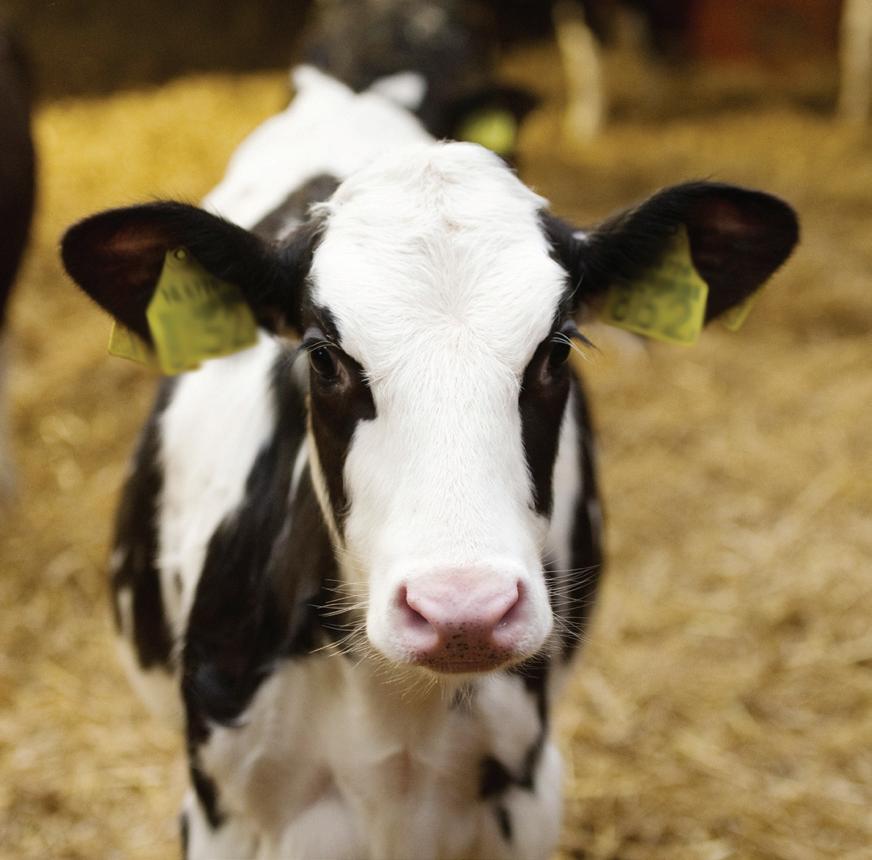


Defra has recently released details about its new calf housing for the health and welfare grant. Hannah Morgan finds out more about what farmers need to know and who is eligible to apply.
The Defra calf housing and welfare grant is now open for applications with grants of between £15,000 and £500,000 available for cattle keepers to co-fund new and upgraded calf housing.
Aimed at boosting calf health and welfare, enhancing environmental sustainability and introducing innovation, the new grant will fund housing that is deemed to provide a good ambient environment and facilitate social contact through pair or group housing.
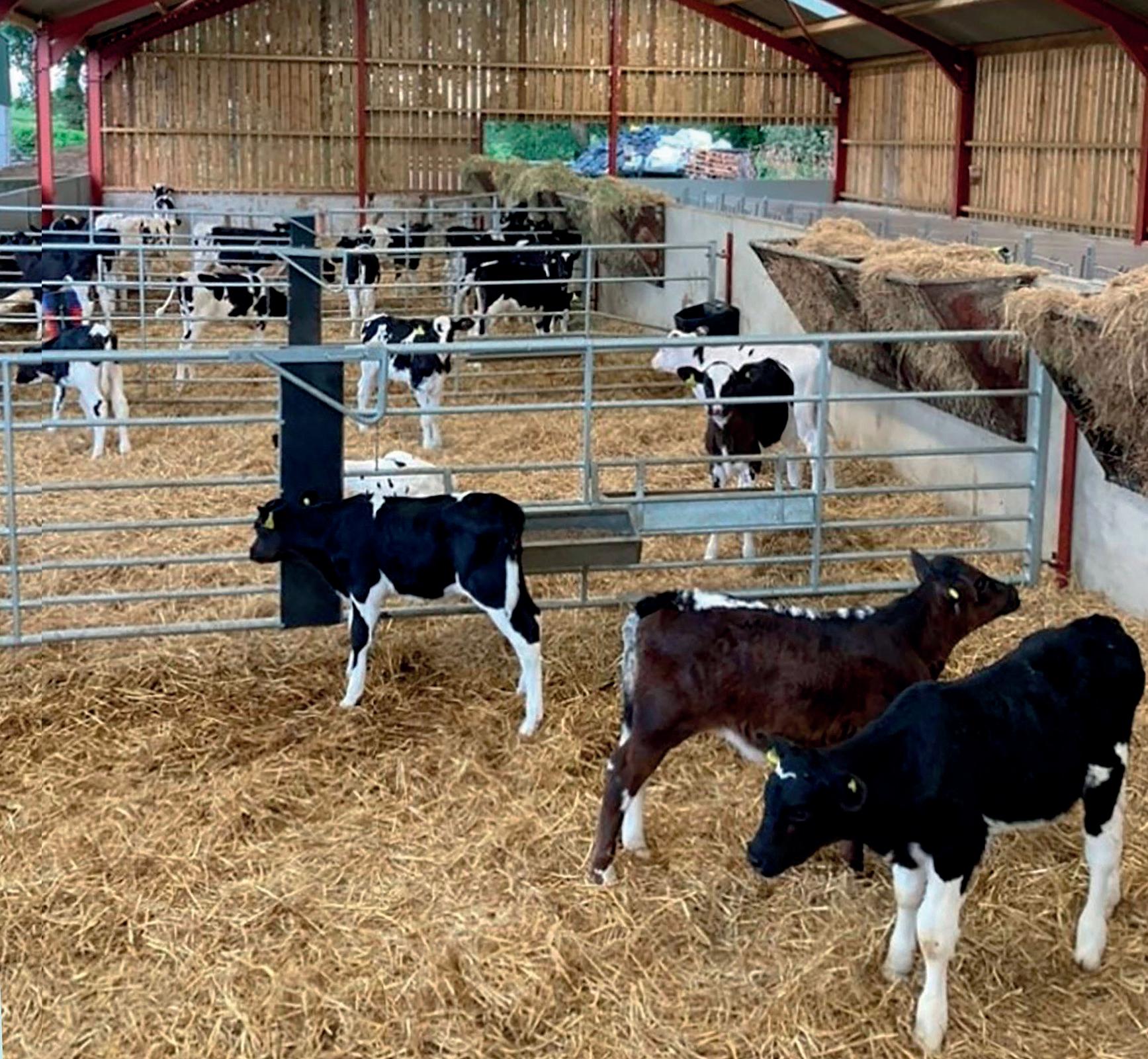
Defra terms state that a good ambient environment must ensure good air quality, temperature, and humidity within the building through choice of suitable location, ventilation, and other building features.
Richard Wordsworth, NFU senior support schemes adviser, says: “We know that healthy, productive animals are at the heart of farm businesses and that well-designed calf housing, with improved drainage, bedding and good ventilation at all times of the year and in all weather conditions, can deliver some real bene ts to improve the health and the lifetime productivity of an animal and prevent performance-limiting respiratory diseases like pneumonia.”
e grant can cover a maximum of 40% of project costs, with the minimum grant businesses will be able to apply for set at £15,000 –40% of £37,500 – with a maximum grant of £500,000.
Applicants must also be able to pay the full project costs upfront before funding is released and can
make a maximum of three claims over the course of the project.

To make an application, a three-stage process will need to be followed:
rStage one of the process, an online checker, is now open and will close on November 30, 2023. is will check eligibility to apply and how well the project ts the funding priorities.
rStage two is an ambient environment assessment. is will be sent to those eligible to apply and will require a range of details including the building site, exposure to wind and shelter, proximity to areas used by adult ca le and plans detailing building dimensions and aspects of the design. rStage three is the full application form. is will be sent to those who have successfully met the rst two criteria.
Mr Wordsworth says:
“Recent surveys by the NFU have shown that a large number of farms are concerned about the scale of on-farm investment required for their businesses and are being squeezed by current market pressures, volatility and insuicient returns.
“It is important to ensure this grant is accessible to all and helps enable those who are looking to
improve their calf housing to make the investment.
“Planning restraints and requirements must also be taken into account as delays to planning approval could create problems for those looking to apply.


“ e NFU is working with Government and local authorities to improve the planning application process to support investment in projects which help to improve the sustainability and reduce the environmental impact of a business.
“If the number of applicants
exceeds the £10m budget, we would also encourage Government to look at extending the scheme and increasing the budget.”
It is important to note that those in receipt of a grant must not start work, commit to any costs including paying deposits, enter into any legal contracts or place an order until a project application has been successful and has a start date, as this could
rApplicants must be located in England
rApplicants must be rearing
11 or more cattle
rThe land that is being built on must be owned by the applicant, or they must have a tenancy agreement for the land which lasts for at least five years after the project is complete
rAn initial online application must be completed through the Rural Payments Agency

rProjects need to be discussed with a vet, and
make an application ineligible. is date will be on the grant funding agreement.
Mr Wordsworth says: “A top tip I would give anyone applying is to review all of the information carefully, make any claims as quickly as possible and, if accepted, give yourself as much time as possible
applications are required to include a letter of confirmation. One way to do this would be to apply for an annual health and welfare review, available through Defra’s Animal Health and Welfare Pathway.
The review is a fully funded visit by a farm’s choice of vet who will give bespoke advice on animal health and welfare, as well as testing for key diseases and conditions. Farmers can also make their own arrangements if they wish to.
to make necessary arrangements such as the necessary planning permissions.
“When looking to make signicant on-farm investments, we would also advise farming businesses to rst visit other units which have already made similar investments to help plan their application.”

your cows?
If accepted, give yourself as much time as possible to make necessary arrangements
RICHARD WORDSWORTH
While requirements on slurry storage are subject to change, advice on the current slurry cover options and available support was discussed on a recent AHDB webinar. Katie Fallon reports.
ith UK agriculture responsible for 87% of the country’s ammonia emissions, it is unsurprising that the Government set out the target to reduce ammonia emissions from agriculture by 16% by 2030, as part of the Clean Air Strategy launched in 2019.

But five years on, how the industry is practically going to achieve that target still remains unclear.
On a recent AHDB webinar, industry experts discussed the current advice in terms of reducing ammonia emissions in slurry storage and the options currently available to farmers, including covers and treatments.
The current proposal, as part of the Clean Air Strategy is for all slurry stores to be covered by 2027, as well as an extension of environmental permitting to dairy and intensive beef farms by 2025.
However, these proposals are subject to consultation by Defra and the Environment Agency, with the outcomes due to be released later this year.
David Ball, environment and senior manager at AHDB, said the intention under the Clean Air Strategy is for dairy, intensive beef farms and other regulatory requirements to be included within
treated to reduce the slurry’s pH level. For existing stores, there will be a requirement to reduce ammonia emissions through the treatment of slurry or an appropriate cover.
environmental permitting. For that to happen, Mr Ball said the appropriate emission limits and the best available techniques would need to be agreed, with evidence gathered to support any inclusion within a regulatory framework.
He explained the Royal Association of British Dairy Farmers, AHDB and the NFU have collaborated to develop an alternative to the proposed blanket permitting.
He said: “The intention is that as part of this alternative industry initiative, there would be an online registration system where farmers could select options for mitigation measures, including
storage and spreading options.”
The proposal received a positive response from Defra and Mr Ball remained hopeful that it may be included in the consultation.
When it comes to slurry storage and reducing ammonia emissions, Mr Ball said the current thinking, which is subject to change following the consultation, is that there will be a requirement to cover all new and altered stores with impermeable covers.
This is unless the slurry has been
Mr Ball said: “In this case, the covers may include the geometric plates or lightweight expanding clay aggregate [LECA] balls, or even crusting as part of the consultation when it is released. We are encouraging all farmers to respond to this consultation when it appears.”
Mr Ball said if natural crusting is permitted, it will depend on the dry matter content of the slurry to ensure there is sufficient material in the store to form a crust. But if an effective crust is allowed to develop, it could reduce emissions by up to 50%.
Other measures which could be adopted in existing stores include slurry treatments to reduce the pH level, where sulphuric acid is added to the slurry under controlled conditions.
JWhen looking at what support is available in England, Catchment Sensitive Farming (CSF) adviser and senior air quality adviser for Natural England, Ceri Meehan, said support is available through the Countryside Stewardship scheme.
She explained there were a range of capital items available through Higher Tier, Mid-Tier and the Capital Grant schemes to help address water and air quality.
She said: “Specifically, on the ammonia reduction side, we can offer support
for floating covers and the self-supporting covers, as well as other items, including low ammonia emission flooring or automatic scrapers.”
Support is also available through the Slurry Infrastructure Grant brought in last winter to increase storage capacity up to six months based on existing livestock numbers.
Ms Meehan explained this increased storage capacity can be achieved through extending existing stores, building additional storage capacity or replacing existing stores with a larger alternative.
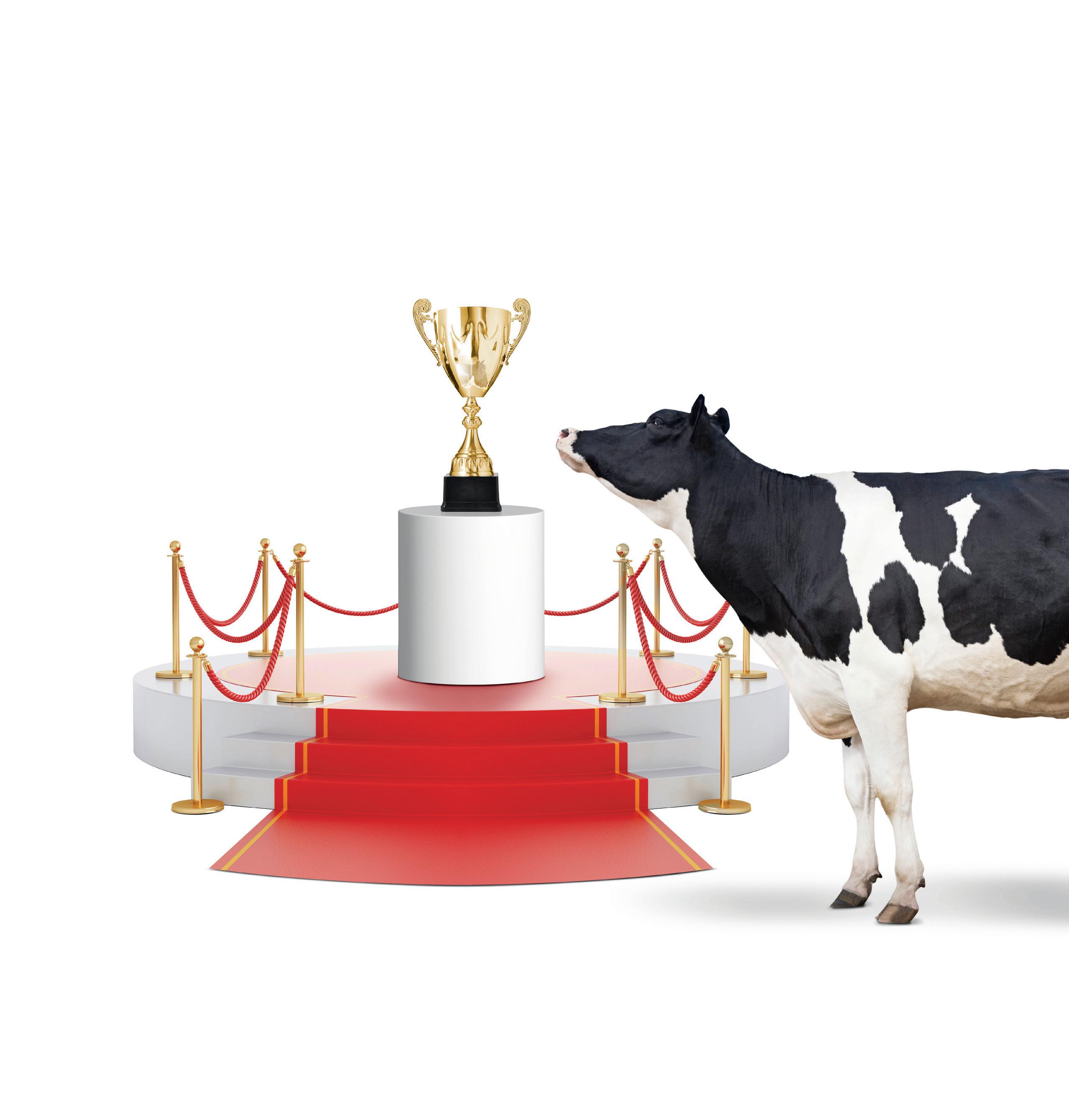
Boost milk production and reduce feed costs with Evonik’s rumenprotected methionine for dairy cows. Mepron® delivers highly concentrated DL-methionine precisely where it benefits the animal most – in the small intestine. How? With science. Mepron® is equipped with a sustained release film coating that ensures handling and mixing stability. It can be mixed homogenously, and is not affected by potentially abrasive components, high temperatures or low pH.
Sciencing the global food challenge. | evonik.com/mepron
In the first of a series of articles from Rory Dean, a self-employed, large animal vet who practices in the Kaipara region of Northland, New Zealand, we hear about some of the challenges currently being faced by New Zealand dairy farmers.

Iwould describe recent events for New Zealand dairy farmers as ‘concerning’, especially in light of a couple of depressing Global Dairy Trade auctions, which has seen the Fonterra payout fall twice in as many weeks.
Fonterra, the main milk buyer and a co-operative, had just slashed its predicted payout by a dollar when it ‘trimmed’ another 25c (13p) from the price of a kilo of milk solids to $6.75kg (£3.14/kg).
is has put the cost of production under scrutiny, and I’ve been spending considerable time consulting dairy farmers on targeted animal health spend with the aim to optimise return and minimise waste while maintaining welfare.
While we are not likely to see the dreaded low payouts of just $4.40kg (£2.24/kg) per milk solid, that were seen in 2014-2015, this recent fall threatens many farms that are overburdened with debt and high farm working expenses.
To continue on in a rather dreary note, my farming clientele has su ered a particularly harsh winter. In Northland, a wet, mild winter is expected, but this year has seen an unrelenting deluge fall on some farms.
With many of my farmers milking cows on land that is at, or slightly below, sea level, this heavy country has seen farmers unable to
graze dairy cows for fear of damaging pasture. Standing o cows on feedpads, laneways and herd homes (where available) has been the norm, and there have been numerous animal health issues as a result.
We recently held an event at the local War Memorial Hall with a brilliant charity — Rural Support Trust — to get farmers o -farm and have a decent laugh, a good feed, and a beer.
While na ering away with the owners of one of the smaller herds in the district about which of the main Australasian horse races we planned on a ending this year, it made me realise how pe y my own problems are.
He is still milking 90 cows at 71 and has seen it all before. e boom and bust of the dairy industry, market volatility, decoupling from the UK, the lot. Perhaps we should all take a leaf from his book and live from one Melbourne Cup to the next.
Driving o -farm the other day, I had to stop to smile at the new wave of calves that have arrived in the pens.
Increased consumer pressure has threatened the ‘bobby’ calf industry, but in true New Zealand form, the market has created a solution.
‘Bobby’ calves, which gained their name from their historical value of a shilling apiece, are
marketed and o en slaughtered from four days old. Understandably, the consumer has expressed concern over this practice, and farmers, not the Government, have reacted to great e ect. I nearly stalled my Hilux truck to see glorious Charolais calves skipping around.
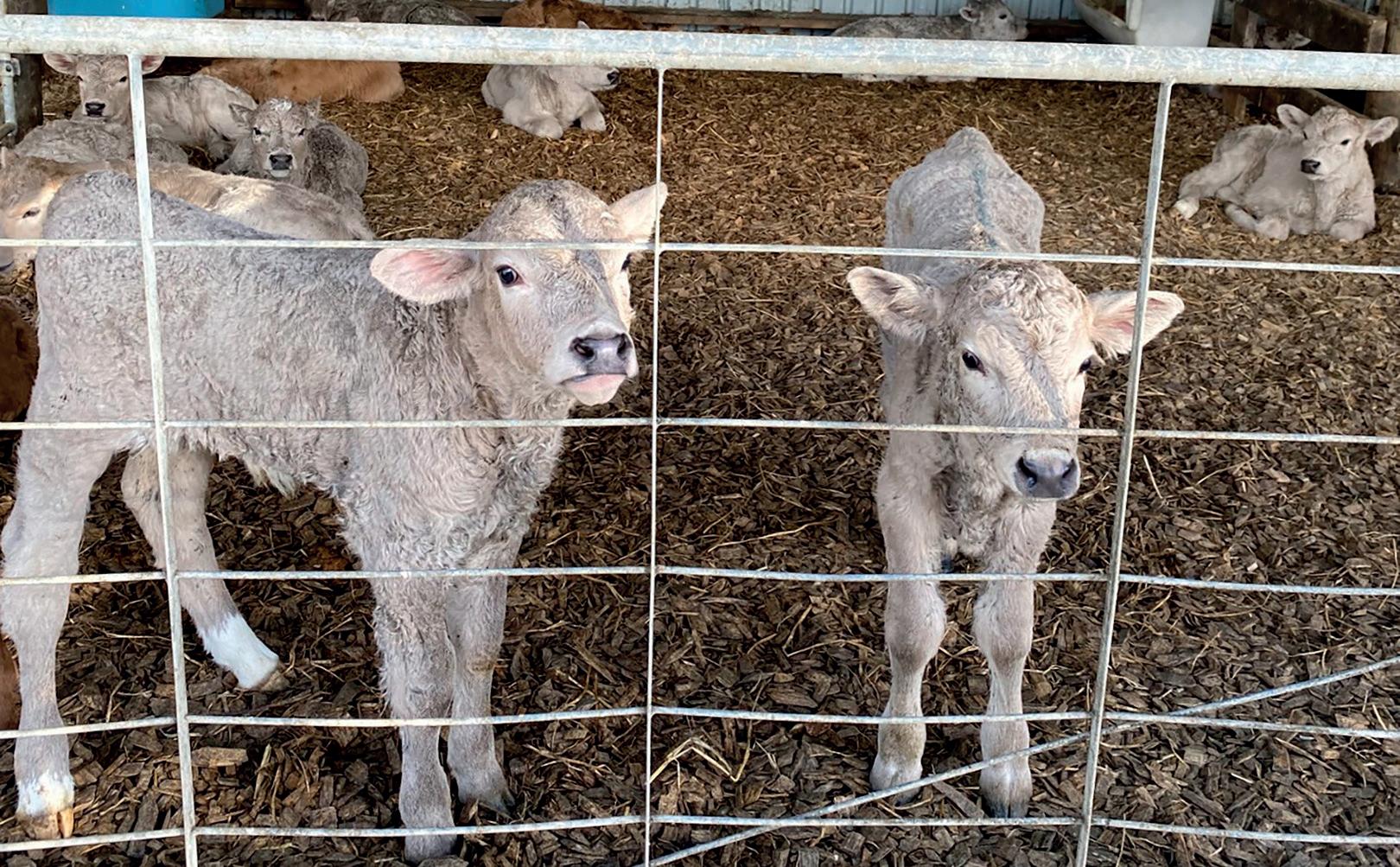
Many farmers have invested in Charolais, Angus or even Belgian Blue bulls for tailing o a er an initial six weeks of arti cial insemination with dairy breeding. ese far more valuable calves are quickly snapped up for more than $100/head (£45) and taken on for rearing.
Easy-calving genetics means my evenings and weekends are safe
as, touch wood, I’ve yet to perform a caesarean section despite being more than eight weeks in to calving. What a fantastic example of the need for market-based solutions to societal pressures on agriculture.
Most of my farmers have applied nitrogen by now, using the local helicopter service. Timing has been critical to prevent excessive runo and improve N use eciency. With the (relatively) new limits of 190 tonnes of nitrogen per hectare and an increasing cost associated with all forms of nitrogenous fertiliser,

e cient use has become critical. Interestingly, a number of oncea-day (OAD) milking herds locally have decided to milk twice daily. is shi is an interesting reaction to the reduction in payout, and I can’t see it paying o , personally. Northland has a signi cant number of herds that milk OAD, and it really suits a lot of farms. is reversion to twice-a-day milking will be an interesting experiment as most farmers realise how much be er life is milking OAD and stay that way. e reduction in yield isn’t as bad as we once thought, and the increased
costs of milking a herd twice daily can outweigh the production gains in lower output, pasture-based herds.
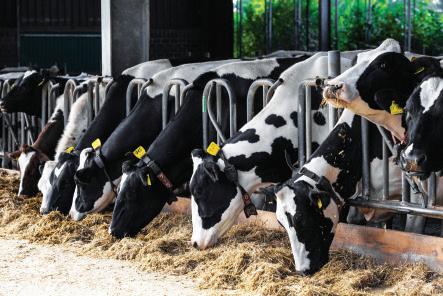


Sta ng seems to be a continual concern. Local labour can o en be unreliable and costly, while bringing team members in through immigration channels can be complex with current regulations.

From a veterinary point of view, the wet conditions have caused an increased incidence of lameness and mastitis on farm.
A number of our clients have Mastatest technology on farm now, giving sample results and treatment recommendations in 25 hours. is has been a revelation — improving treatment success rates, reducing antibiotic usage and improving bulk tank cell counts. It is amazing how far we have come, from a vague stab in the dark when treating mastitis to this careful targeted approach.

It’s all cloud based and farmers can call me to discuss any worries as I immediately have access to all of my clients’ results via email.





















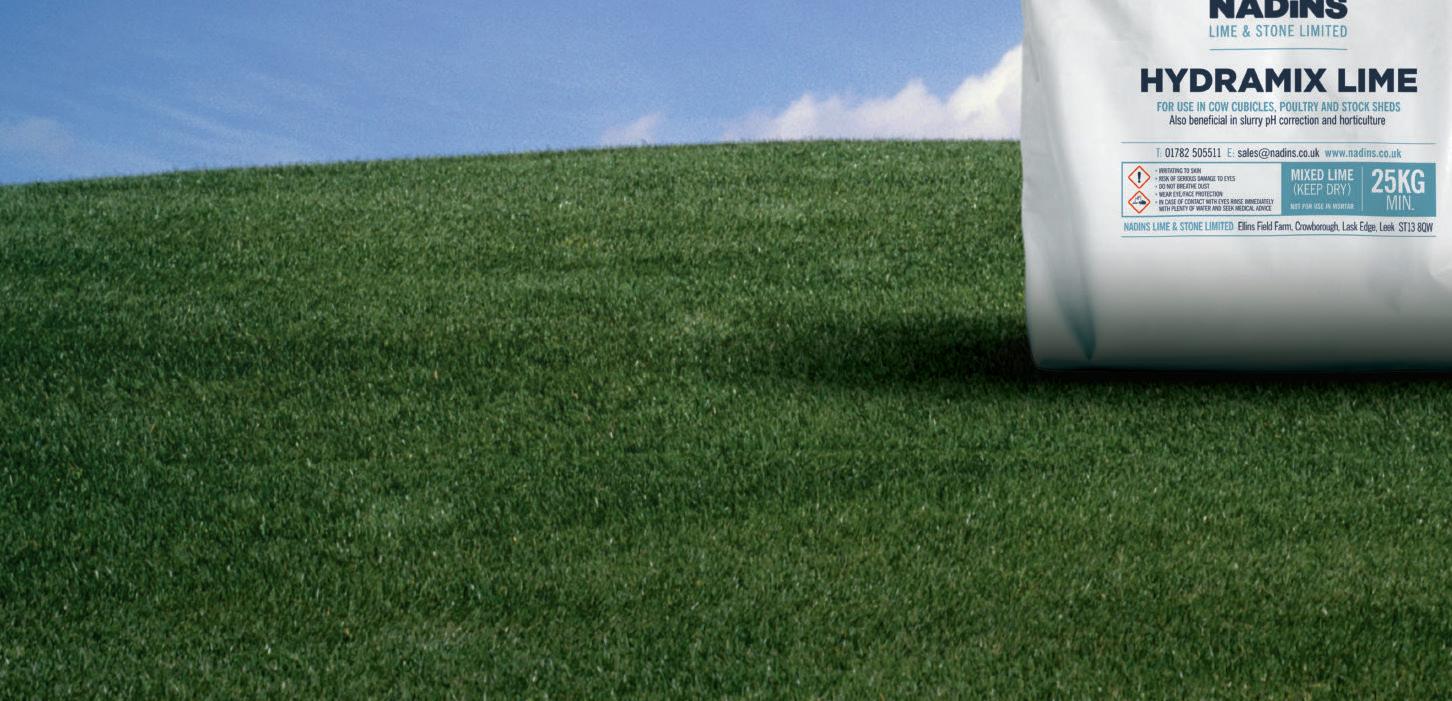
We’ve seen an increase in the diagnosis of Serratia, a mastitis pathogen which is frustrating to deal with. is seems to be a nationwide trend, but is particularly prevalent in the North Island.



I contributed towards a paper on this to be presented at the recent veterinary conference and it’s amazing how many other farmers and vets were also quietly struggling to manage this tricky bug.
Away from work, my partner’s father and I managed to get out shooting turkeys last weekend with considerable success. e local rule is that you should not hunt turkeys in months containing an ‘r’, so time was running out.
e reason for this seems to vary depending on who you ask, but most say it is due to the taint of the meat as the big birds begin to eat crickets in the warmer months.
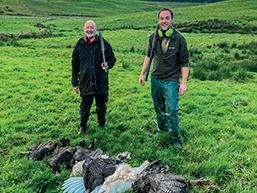
There were cows and industry debates aplenty at this year’s UK Dairy Day. Katie Jones, Ellie Layton and Jonathan Wheeler report on the event.
Producing one tonne of milk solids/lactation is perfectly achievable and desirable, but only for the right cow in the right system.
at is the conclusion of a new study completed by Kite Consulting. Launching the document, director John Allen said some herds were already able to achieve that, which was a fantastic story from both nancial and environmental standpoints. e national average production is 675kg in a 305-day lactation.
Kite consultants Rose Jackson and Maimie French, who conducted the survey, looked at eight housed units that were achieving the standard to identify the factors that enabled them to do it.
ese factors fell into three broad categories — genetics, management and nutrition.
On the genetic front, Ms Jackson said some obvious factors were evident.
She said: “All the farms we surveyed had very clear breeding strategies. ey were already breeding for solids, using sexed semen, basing their breeding strategies on genomic data and were achieving good rates of gain.”
In addition, they were all milk recording, and milking three times a day, except for the farm using robots, where animals averaged 3.2 visits/day to the milking stations.
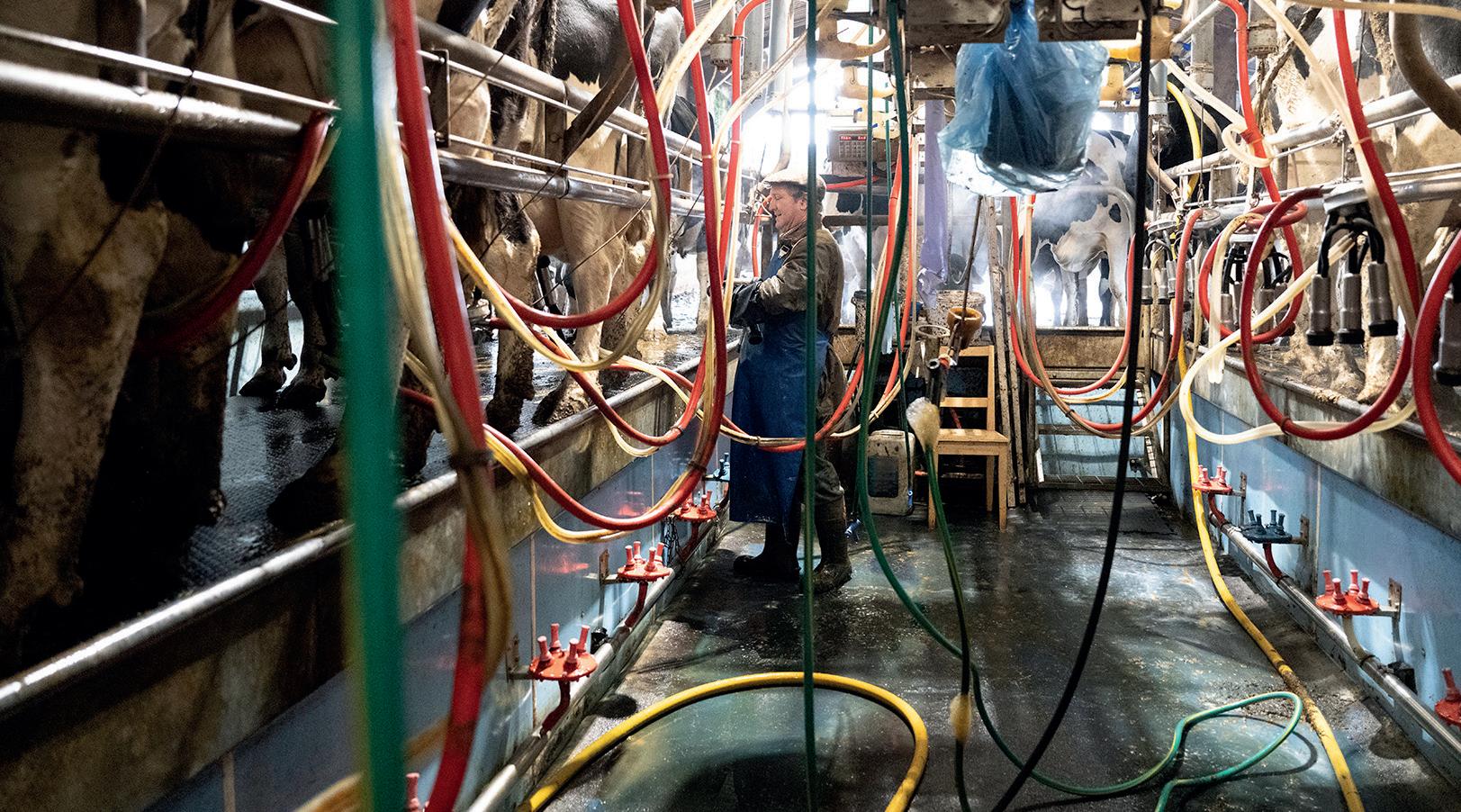
On the environmental front they all performed well, with carbon footprints of between 0.8kg and 1.1kg of carbon dioxide per litre of milk produced, well below the 1.2kg/litre national average.
Feed management was also
e cient, with all units achieving excellent feeding performance with six out of eight gaining more than half their milk from forage, using total mixed ration or partial mixed ration systems.
is helped sustain healthy rumen activity and drive bu erfat production, which was also assisted by the fact that they also fed C16 fat.
Animal health was also be er, with levels of Johne’s disease well below national averages and mastitis levels at between six and 16 cows per 100. is is well below the 30 per 100 national average.
Lameness levels were minimal,
with all herds using activity monitors for heat detection.
Colostrum management was good, with animals weaned at between nine and 10 weeks. at set animals up well for rst calving, which was between 685 and 757 days — well below the national average. And all had individual animals producing well in excess of one tonne of milk solids — the top cow reached 1.49 tonnes.
All units also o ered enriched environments, such as brushes and fans. Ms French also said the farms had more similarities than di erences. “ ere were several management and genetic factors
that could be usefully adopted by other dairy farmers.”
However, Ms Jackson also said the herds were all-year-round systems, and such results were ‘probably not achievable for every farmer’, but were a ‘sensible target’ for farmers to aim at.
For other farmers, John Allen suggested the ideas present a di erent opportunity.
He said: “ ey could choose to achieve lower levels of solids from simpler production systems.”
But he added that farmers achieving such sustainable production should be rewarded for it, which was not happening yet.


ollowing a number of years of being under bTB restrictions, dairy farmer Robert Mallet, of Northleaze Farm, Swindon, has had to make a number of adjustments to his system in terms of how he handles beef sired calves.
Speaking in a farmer panel session, Mr Mallet, who milks 230 cows on in an autumn calving block, explained that since 2019 he has been rearing all beef calves and taking them right through to finishing.
He said all calves were treated the same, whether they were heifer replacements or beef sired calves, with attention paid to colostrum management.
He said: “The beef calves receive milk replacer and calves should put on 1kg a day in the first month. They will then be offered concentrate, and are weaned at about six to seven weeks.”
The calves born at the beginning of the autumn block are reared outside. Mr Mallet said: “There is an overlap of last year’s calves and the new crop, so once the calves are drinking well, at about a week old, they go outside.
“They stay outside until the end of October, which helps take
the pressure off building space as, by this time, most of last year’s crop of calves will be gone.”
In the main, beef calves are marketed via a local livestock mart agent and Mr Mallet said he worked out the cost in the first year that everything was finished on farm.
He said: “The cost of getting
them to three months of age was about £180, and then with finishing costs and some depreciation, we were looking at a margin of about £300 with the aim being to finish everything at 14 months.”
He added current prices would mean this figure would now be about £350.
“This margin is only worth it if the farm is shut up with TB. If not, it would certainly be better to sell them at three months of age and get upwards of £300 for them.”
He said in terms of genetics, he looks for good figures on calving ease and days to slaughter.
“We calve everything outside, so we do not want to have to intervene at calving.”
FROM October 2, 2023, cattle keepers will be able to apply for a general licence, known as licence TB16e, that covers the onward movement of cattle from TB restricted holdings.
This will cover direct movements or movements through an ‘orange market’ in England and Wales to an approved finishing unit (AFU), an approved finishing unit enhanced with grazing (AFUE), or to a licenced slaughterhouse.
The NFU, which has been
lobbying for the change, says this will allow greater flexibility and will reduce the amount of administration required by farmers and the APHA, while also maintaining traceability and disease control.
Speaking at UK Dairy Day, Gabby Emery, NFU Dairy and bTB advisor, said under current rules, which involve obtaining licences for individual animals, the time needed to complete the

process often makes it difficult for cattle keepers to meet the demands of cattle purchasers.
The new general licence will be valid for the time between short-interval tests.
Following each short-interval test, cattle keepers will need to apply for a new licence.
For breakdown herds in Wales, when the next TB test is a potential clearing test, the licence will usually only be valid for calves under 90 days old.
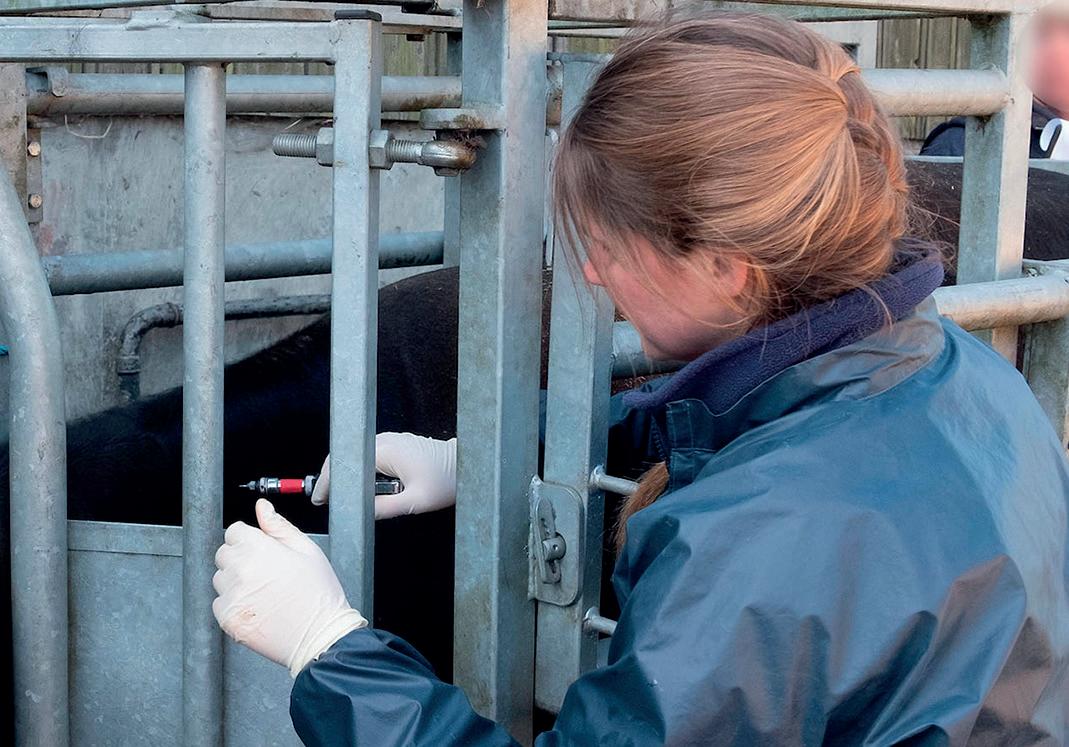
Ms Emery said: “This will lessen
the resources needed and the time take to get the licence back.”
The new general licence was advocated for by the Bovine TB Sub-Group, a collaboration between the NFU, Defra, APHA, AHDB, the Welsh government and representatives from the dairy and beef supply chains.
The next issue which the sub-group is looking at is the possibility of increasing the TB test threshold age for cattle moved to AFUs from breakdown herds from 42 to 90 days.


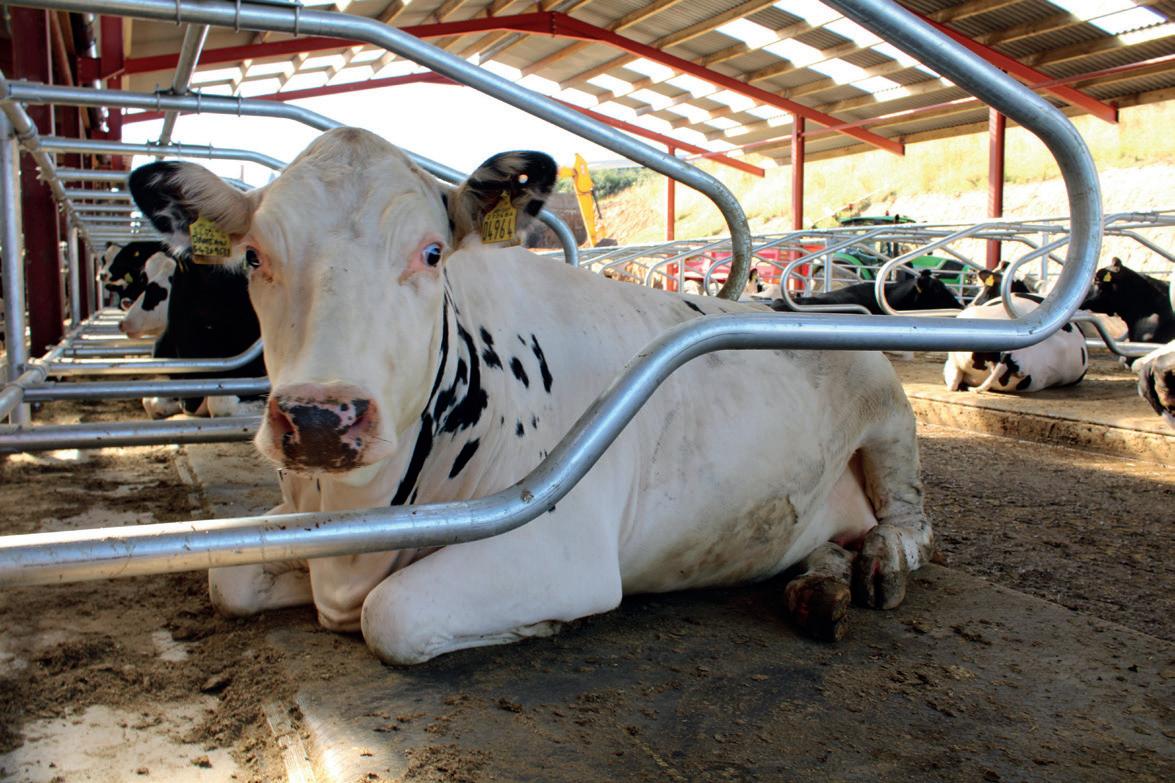

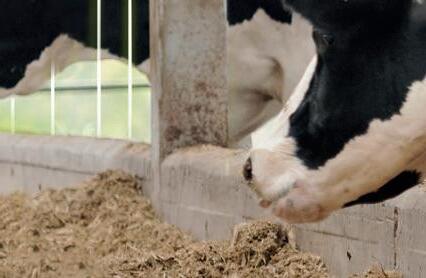


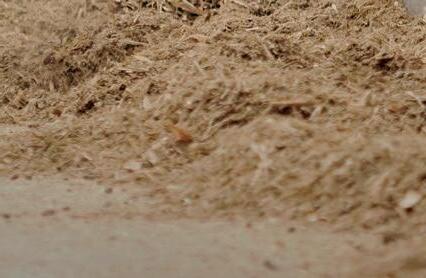




























Dairy farmers are their own worst enemies when it comes to failing to react to falling milk prices, industry consultant Chris Walkland told attendees at a UK Dairy Day seminar on milk pricing.

It only takes a small level of over-supply on the world market for prices to fall, and he said producers must react to changes faster to avoid price drops.
If they do not, Mr Walkland said they could be storing up serious problems for the future. And he said he thought processors should have
cut prices faster and further this year.
He said: “Farmers are a nightmare on this issue and processors have been far too gentle on them this year. They should have made bigger cuts, not just dibbles and dabbles.
“And if milk volumes do not drop, then prices will continue to fall.”
JJust saying ‘thank you’ for a good job done could help a dairy farms retain staff and avoid the labour problems which beset so many farms, said Paul Harris, of recruitment consultancy REAL Success.
Speaking in a session looking at the issues facing dairy farming businesses,
he highlighted that many workers say they left a previous job because of the way they were treated.
By contrast, he said thanking staff, providing them with decent accommodation and providing training would all help generate
Until the industry reacts quicker, he suggested the problems were going to last longer and be increasingly painful.
But he highlighted the opposite side of the coin – pointing out that farmers did have power when supplies were lower than required.
He said: “You could get more power from contract reform if you use it wisely.”
He said the contract reform might help secure better terms on issues such as contract notice periods, and like other speakers in the panel session, which was looking at the future of milk pricing and processing, he said he did sympathise with farmers over who should bear the cost of sustainability.

He said: “Traders do not give a
motivation and could increase staff retention.
He said: “People ask me what is the point of training staff if they then leave. I say what is the point of not training them if they stay?”
They key is learning how to communicate effectively with each member of the team, which might include regular staff meetings as well as one-to-one sessions.
But listening to staff, learning what they think and rewarding good performance is just as important, he said.
“This goes beyond money and beyond recognition; it can mean just saying ‘thank you’. Money helps and good accommodation is essential; so too is a safe working environment.”
monkey’s about sustainability and they do not want to pay any money for it.
“It is crucial for the future of milk pricing that they start to cough up for it.”
Retailers, he said, were very similar in their thinking that farmers should bear the cost of sustainability themselves.
John Allen, of Kite Consulting, also commented on the reluctance of much of the market to reward farmers for their work.
While some aligned and Muller contracts did reward them, many did not.
He said: “I cannot see anybody else getting paid for the things the consumers say they want.”
With regarding to reacting
And nobody likes working for a grumpy boss, he said.
Fellow recruitment specialist Hugh Pocock, of Cultura Connect, said farmers needed to ensure their business stood out from the rest when there was a shortage of potential recruits.
Mr Pocock said: “That might be hard if you are not naturally outgoing and telling the world about yourself.”
He suggested using social media, getting involved in things such as Open Farm Sunday and working with the local community.
“One very successful dairy farmer sends out a newsletter telling neighbours when they will be spreading slurry, harvesting or calving.”
Speaking in another session, Michael Oakes said the NFU was trying to help improve the
quicker, John Giles, of Promar International, cited examples from the horticultural sector, in which the company is also involved.

He said: “Growers have reacted when facing di culties. Some have cut production; reduced the number of varieties they grow; dropped non-pro table varieties or switched to other crops. In some cases they have said ‘enough is enough’ and ceased production completely.

“In dairy farming, changing the pro le of production could take longer for all sorts of reasons. But just carrying on producing seems to be a recipe for suicide.”





labour issue by working with the Department of Education to teach about the industry in schools and offering relevant qualifications, such as T levels.
He said: “There is nothing to stop us from going into schools and talking about what farming is and does, and how it affects their daily lives.”
Farm-O-San Reviva is an easily digestible, highly palatable energy drink for freshly calved cows, that should be given immediately after calving.

It helps the cow to rehydrate rapidly after calving. Farm-O-San Reviva increases the cow’s activity and forage intake.







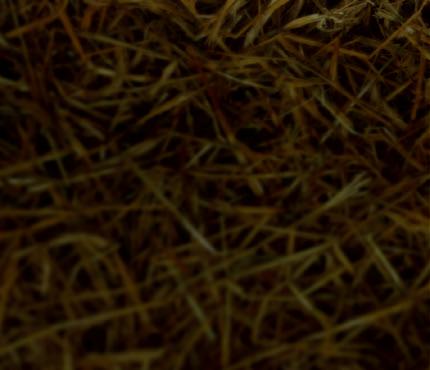
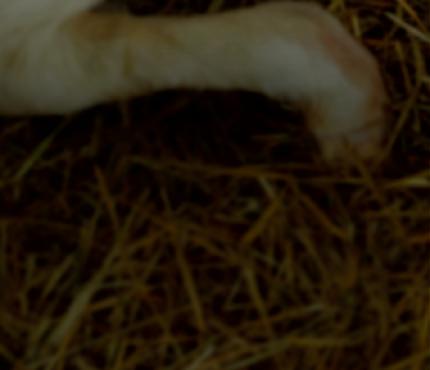
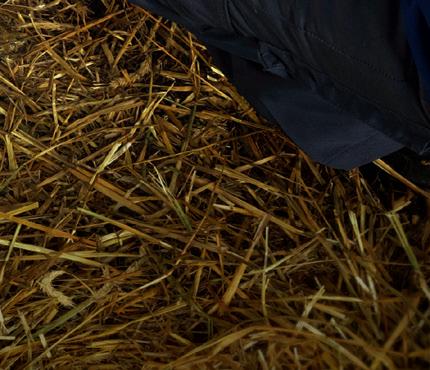
trouwnutrition.co.uk/reviva

The orange energy boost for recovery after calvingJohn Allen The industry would have been better off if price cuts had been made faster and further, said Chris Walkland. Hugh Pocock
Larger entries were seen in the cattle lines at this year’s UK Dairy Day, where national shows were held for the Holsteins, Ayrshires and Brown Swiss breeds.
The National Holstein show judge, Iwan Morgan, from Carmarthen, highlighted the quality of animals brought before him at the show, before tapping out Evening Sidekick Jennifer, from James Wilson, Carlisle, as his overall winner.
The November 2018-born cow is sired by Walnutlawn Sidekick and is a daughter of Evening Stanleycup Jennifer.
Classified VG89 and producing 15,000kg as a heifer, she is now giving 40kg daily.
Last year she won at AgriScot and was champion at Dairy Expo earlier this year.
Mr Morgan said: “This was a very tight championship with little between the top three, but this cow looked great from every angle, had elegance in her locomotion and an exceptional udder.”
Reserve
Reserve champion was awarded to the five-year-old cow in-milk, Wilt Bailay, from Blyth farms, Peebleshire.
Imported from France, this daughter of De Oosterhof Willems was reserve champion at last year’s UK Dairy Day.
She also took the reserve Holstein championship title at the 2022 Royal Highland show.
The honourable mention went to Styche Armour Hilgonda, which took the overall championship title at last year’s UK Dairy Day for Ed and Kelly Seaton, of Seaton Farms, Cheshire.
She won her mature cow in-milk class and is sired by Ladys Manor Halo Armour and out of home-bred Styche Captain Hilgonda.
She has won multiple prizes previously, including champion cow in the Shropshire herd competition.
There were 12 heifers competing for the Holstein heifer title, with Riverdane Tatoo
Ambrosia taking the championship title for the Nutsford family, Cheshire.
The October 2020-born heifer was sired by Duckett Crush Tatoo and a daughter of Sahara Sanchez Ambrosia 3, which won at UK Dairy Expo in 2019.


Junior
The junior two-year-old Wiltor Chief Atlee came in reserve place for D. and C. Jones, Monmouthshire.
This June 2021-born junior heifer is sired by Stantons Chief and is a daughter of Wyndford Doorman Atlee 2, a cow which is itself no stranger to the showring.
Feizor Mirand A Kandie
Red was the honourable mention after winning her senior red and white heifer class. The heifer was bred and exhibited by W. and A. Booth, Lancaster. Sired by Coomboona Zipit Mirand and a daughter of the home-bred cow Feizor Ammo D Kandie Red 2. She calved in April to Riverdane Alaba.
Allstar Ringer Joybell from Evie Tomlinson, Cardigan, won the junior heifer in-milk class, before going on to win the heifer championship and overall National Ayrshire title under Cornwall-based judge Colin Christophers.
This June 2021-born heifer is a daughter of Allstar Supreme Joybell 2, which won the All Britain photographic compe-
tition in the six- to 12-month category in 2021.
Wren 7

Reserve champion Ayrshire was L.C. Window, Halesowen, with Hunnington Wren 7, a senior cow in-milk. She took third prize in her
class at UK Dairy Day in 2021. She is sired by Rosehill Prestige and out of Hunnington Wren 4.
e honourable mention went to Willow elds Famous Clover from L. H. Ba y, Derbyshire.
is July 2017-born cow is sired by Hunnington Famous


and out of Sandyford Crown Clover. She was second at UK Dairy Expo last March.
Claiming reserve in the Ayrshire heifer championship was Longwood Hawaiian Barbara, from Robert Crawford, Suffolk.
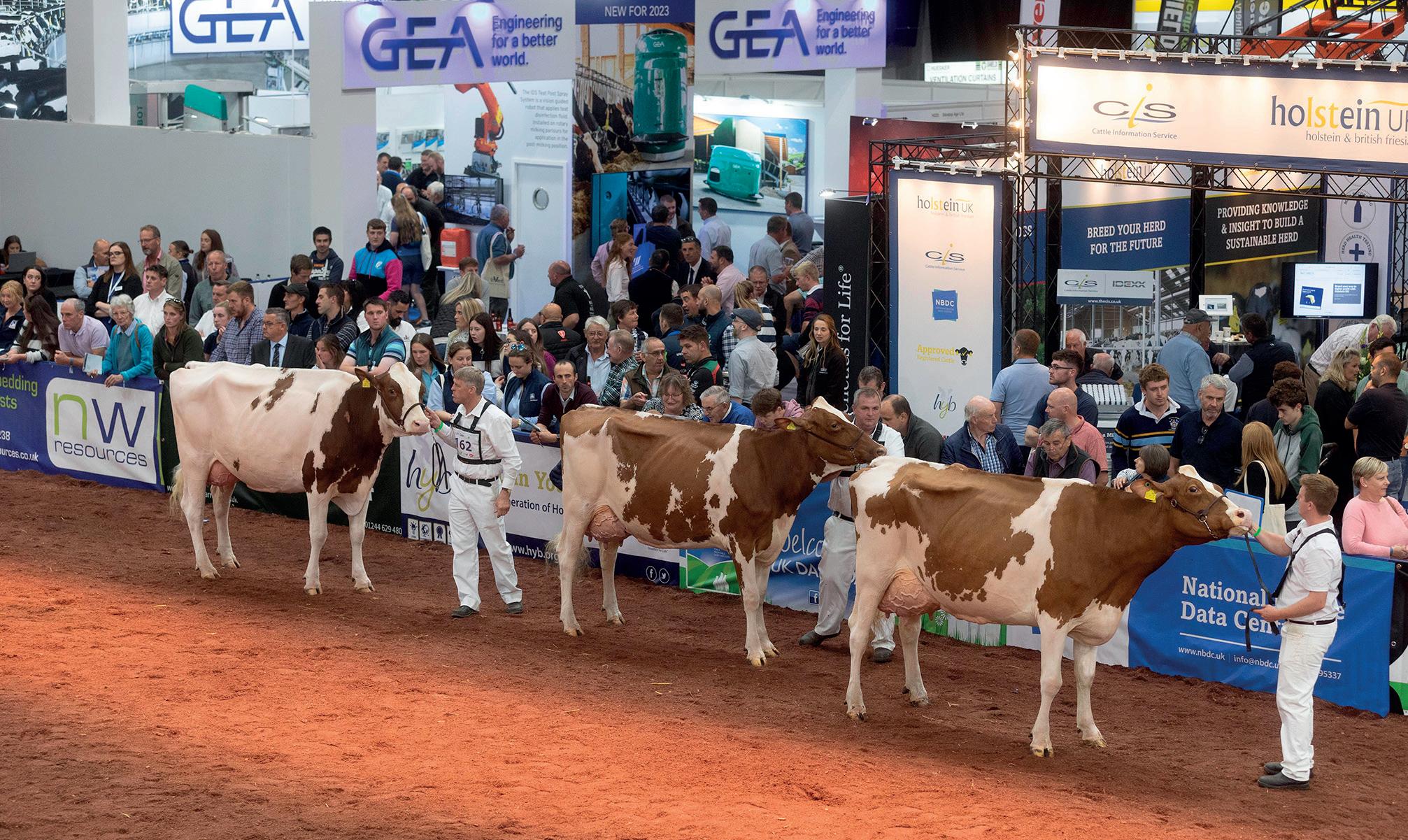
A daughter of Toi Toi Triclo
Rosie, this heifer is by Haydale White Willow and was second to the champion in the junior heifer in-milk class.
Taking honourable mention was Morwick Peggy 126, from G.G. Baynes’s Marleycote herd, Northumberland.
e senior heifer winner is by
Pam Ayrs Hawaiian and out of Morwick Peggy 113.
Three was the magic number for the Lochhead family, Dumfries, after entries from their Kedar herd took champion, reserve and honourable mention.
The overall winner was the senior cow in-milk, Kedar Calvin Sanchia Maria.
The December 2012-born cow, which is sired by Vetschs Nesta Calvin, is out of Old Mill Starbuck Spottie, which won the champion ticket at the National Brown Swiss show in 2013.
Maria also took top honours at Northumberland show this year.
Brian Weatherup Jnr, Fife, who judged the Brown Swiss section, said: “This is a strong powerful cow who had style throughout, the blend of her fore udder attachment and veination was a credit.”

Kedar Nescardo Snickerlicious was awarded reserve champion after being placed second in her class to the champion.
She is a 2017-born daughter of Kalingen Nesta Nescardo and out of home-bred cow Kedar Sickerdee.
Honourable mention went to the junior cow in-milk, Kedar Carmen Eileen, another daughter of Vetschs Nesta Calvin.
Sweeping the board in the Shorthorn classes and taking the championship, reserve and honourable mention was the Collins family’s Churchroyd herd, Dewsbury, West Yorkshire.
Their junior cow in-milk, Churchroyd Bronte Wildeyes
62, took the champion title.
The December 2018-born second calver is home-bred on both sides, sired by Churchroyd Wildcard and out of Churchroyd Bronte Wildeyes 38.
She is currently on her third lactation after calving in June. On her second lactation, she produced 10,084kg at 3.69% butterfat and 3.11% protein.
Judging the Dairy Shorthorn section, Gwyndaf James, Ceredigion, said: “This cow took my eye straight away. I judged the Great Yorkshire Show last year and placed her twin sister breed champion and this cow echoes her dairyness, balance and udder veination and neatness.”
Churchroyd Bronte Wildeyes
54 came in reserve. This is a senior cow in-milk sired by Landino Park Talent Imp.
This February 2017-born cow produced 8,992kg on her third lactation with 4.20% butterfat and 3.39% protein.
She was third in her class at
the Great Yorkshire earlier this year and today’s judge admired her for her clean bone and style.
Completing the trio, the honourable mention was awarded to Churchroyd Heather 134, a February 2021-born heifer sired by Churchroyd Koala and out of Churchroyd Heather 120. Currently in her first lactation, she calved in August.
Mr James said: “This is an exceptional heifer whose time will come; she just lacked the maturity of her classmates.”
Taking top honours in the Guernsey championship was Greensfield Dandy Dan Butterfly from M. and C. Greenslade, Cullumpton, Devon.
Home-bred on both sides, the junior cow in-milk is sired by Greensfield Dandy Dan and out of Greensfield Stinky Butterfly.
She gave 4,615kg in her first lactation at 4.65% butterfat and 3.42% protein.

Judge Colin Christopher said his champion boasted dairy style, balance and was one of the best heifers he had seen for many years.
Clinching the reserve title after winning her heifer in-milk class was Kimcote Brogen Fragrant 8, from A. and R. Thomas, Lutterworth, Leicestershire.
She is a daughter of Kimcote
Legend Fragrant 4, which was champion at UK Dairy Day in 2018.
Receiving honourable mention was Je-Taime Double L Bijiou 2, bred and exhibited by Richard Norman and Polly Whetham, Yeovil, Somerset.
Despite limited showing chances over the past few years, Bijou was champion at UK Dairy Day last year, inter-breed at the Royal Bath and West Show in June and runner-up at the All Breeds All Britain Calf Show in 2019.
Jersey
Pick of the day for Jersey judge John Waller, Cumbria, was Rivermead Verdi Pixie, from the Tiverton-based Davies family.
The champion, sired by Futuredreams Valentinos Verdi was shown giving 34kg daily and is due to calve in March to Victorious.
Reserve was awarded to Kevin and Sian Rickard, Newport, with their junior cow in-milk, Whitefire Dazzler Flamingo.
This cow was purchased by the Rickards from the Glanmor herd in 2019.
Honourable mention was Rivermead Casino Sangria, coming from the same stable as the champion.
Find out more about the ARION 400.
Ask your dealer for a demonstration or visit claas.co.uk
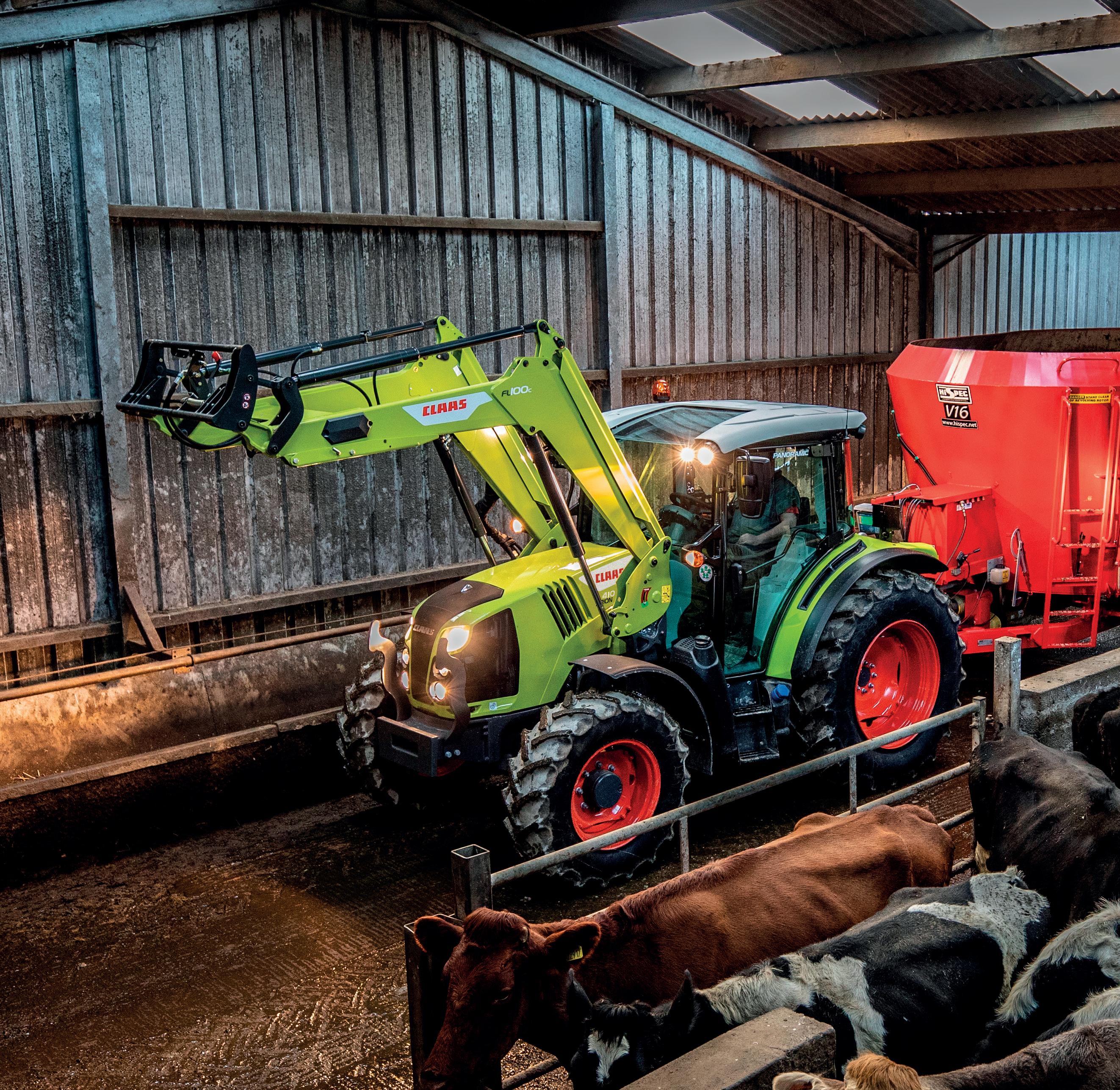
The ARION 400, Stage V offers: 85-155 hp
Intelligent operator assistance systems
Smart data management
Efficient connectivity
Exceptional cab comfort
Farmers looking to protect soils a er maize harvest and tap into the Sustainable Farming Incentive payments for ground cover need to get on with sowing the cover crop quickly to give it the best chance to establish.
Roger Bacon, regional manager for Barenbrug, said the issue of what to sow a er maize harvest was a regular topic of conversation at UK Dairy Day.
“An Italian/Westerwold-based mix will grow at cool temperatures, so they will get up and grow away quickly,” he said.
He added that seed rates depended on the planned use of the eld. When the plan is to graze over the winter, the company recommended a seed rate of 30 to 35kg per hectare, which can be reduced to 25kg/ha when aiming for just a green cover.

“As well as grazing sheep over
Seed rates for grass after maize depend on the planned use of the field.
the winter, the higher rate also o ers the opportunity to get an early silage cut in the spring.
“People are looking to optimise that rst cut to avoid running into issues if the weather
JA major update to the SenseHub Dairy herd monitoring system was announced by MSD Animal Health, which makes it the only system able to monitor dairy cows and calves for the entirety of their lives.
The update also integrates two in-line milk monitors into the SenseHub Ecosystem; the

SenseHub MilkPlus Sensor monitors milk data such as yield, fat, protein, lactose, blood and conductivity, while the SenseHub Somatic Cell Count Sensor provides individual somatic cell count results within two minutes of the start of milking. Both are compatible with any type or
make of milking parlour.
The update also introduces two new service plan options: the entry-level ‘Essential’ package for smart automation technologies and milk monitoring, and the ‘Lifetime’ plan for herd managers who want greater control throughout the entire herd life cycle.
turns dry in June, as it has done in recent years.
“Ge ing a big rst cut is important, and spring calving herds also want good grass to turn out onto.”
Among other questions they faced, many were from farmers looking to grow herbal leys for the rst time, o en at the behest of their milk buyers and customers.
Mr Bacon said: “Some are also how they can reduce fertiliser requirements and are aiming to become more carbon neutral.”
JResearch has shown using a once-weekly bedding conditioner treatment in dairy housing can reduce disease challenges and cut cases of digital dermatitis in dairy cows.
An on-farm trial in France using a bedding conditioner, Cobiotex, resulted in a reduction in both the number of cases and severity of digital dermatitis by 35% and 77% respectively.
e trial included 120 Holstein cows housed for part of the year in
cubicles, treated with 200 to 250g of bedding conditioner per cow per week in each cubicle for 12 months.
At the start of the one-year trial, the farm had 36 cases of digital dermatitis per 100 cows. However, by the end of the trial, the number of active cases of digital dermatitis had dropped to 24 cases per 100 cows.
In addition, cases of digital dermatitis following the application of bedding conditioner were more con ned to less severe lesions (M1, M3 and M4 stages) when
scored using the M scoring system for digital dermatitis adopted by the International Commi ee for Animal Recording.
e proportion of cows in the painful M2 stages associated with severe lameness reduced from 29 cases per 100 cows to seven at the end of the trial.
e product, which is a multistrain bacterial additive that forms protective bio lms across animal bedding and cubicle surfaces, is available in the UK from Envirosystems.
Speaking at UK Dairy Day, the company’s managing director Liz Russell said: “ e results back up what we are seeing on farms here in the UK.
“Not only do farmers see health bene ts in their cows, but the biologically controlled bedding environment created when using the conditioner means that potentially ‘irritating’ bedding additives, such as lime, can be cut, and mastitis/digital dermatitis treatments or antibiotic use are also reduced.”
An energetic booster to support the milking ruminants

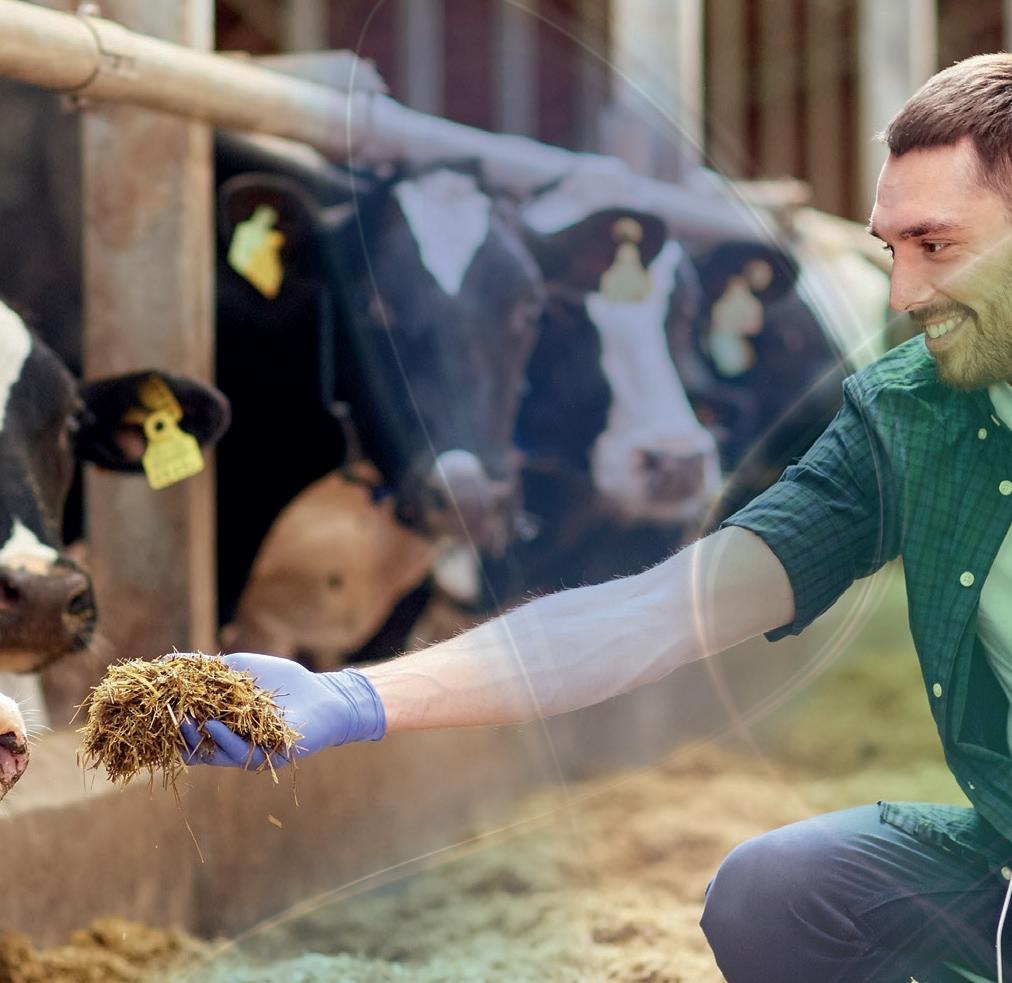

To find out more open your camera and hover over the QR code or use your browser www.ruminantad.com

• Improves Feed E ciency

• Limits Ketone Production
• Reduce Risk of Energy Deficiency
• Lower Carbon Footprint
Propylene Glycol (vegetal origin) and Sorbitol
Energy intake
Volatile Fatty Acids and Sodium Propionate
Energy intake
Yeast extracts and Cobalt
Ruminal activity stimulation

foot trimmers, so feet can be lifted as soon as possible.
The tenanted unit is home to 425 Holstein Friesian cows, which produce average annual yields of 8,900 litres, with milk sold to Muller on a Sainsbury’s contract.
Richard, the third generation to farm at Whitening House Farm, joined the business in 2006 and, in 2010, started the conversion to autumn and spring block calving following a study tour to Australia and New Zealand, where he was impressed by the discipline and efficiency a block system offered.
As well as simplifying the heifer rearing process, Richard says this move has improved feed efficiency, with milk from forage now standing at 3,800 litres.
Some Norwegian Red genetics are now being introduced to the herd to further improve on feed efficiency figures. And in order to increase milk from forage further, there is also a focus on soil health and forage quality.
Cows are mobility scored every six weeks and farm staff are all qualified
With an eye on net zero targets, Richard and his team are measuring and monitoring carbon emissions and taking steps to make reductions.
They are currently looking at the impact of making ration adjustments to reduce methane emissions.
Solar panels were installed seven years ago and the possible use of battery storage is being investigated as a way of increasing the farm’s green energy consumption.



Richard is keen to credit the team at Whitening House Farm, with many members of staff having been with the business on a long-term basis.

A new parlour was installed in 2021 and Richard says as well as improving milking times and efficiency, this has also helped to create a better working environment for staff.
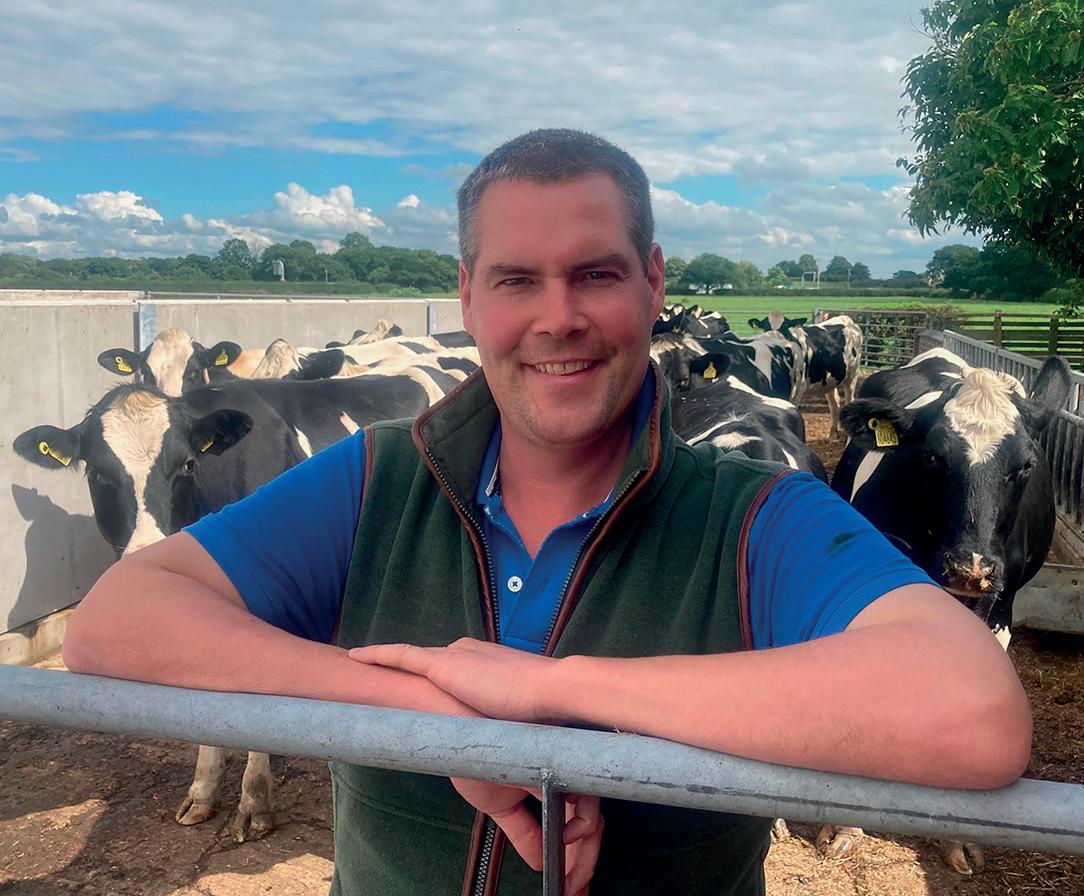
He says: “We have staff who have been with us for a number of years and we aim to look after our team by involving them in the decisionmaking and ensure they have the proper facilities to work in.”


XThe Jersey breed has long been a part of the Jenkinson family’s farming journey, and a passion of Katherine’s since being a little girl.
Her great grandparents established the Heathwaite prefix and Katherine, along with her parents and brother, are milking 155 pedigree Jersey and cross-bred cows, across 83 hectares (206 acres) of owned and tenanted grassland.
Katherine, who also works fulltime as a milk recorder, has her own 45-strong herd and is a regular on the show circuit, scooping various awards along the way.
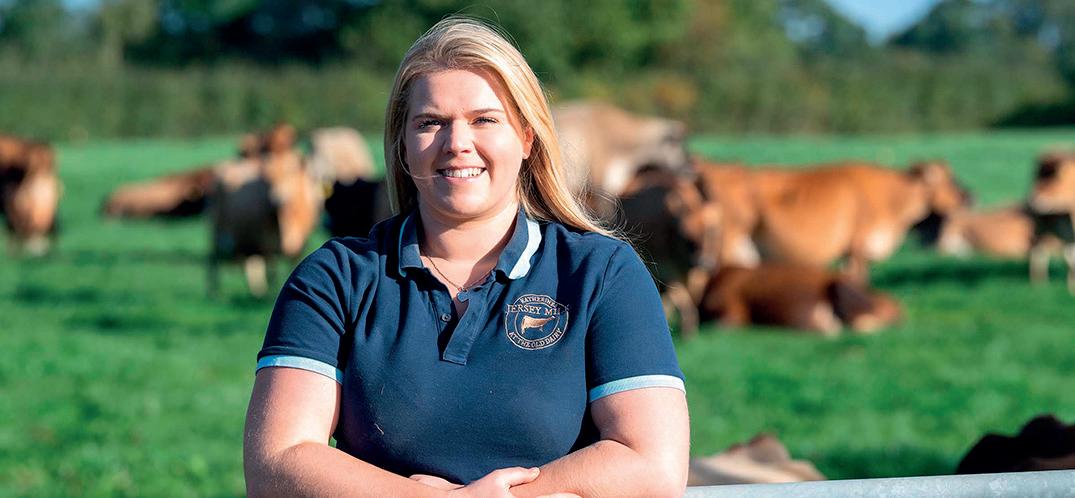
Cows graze outside from late March until the end of October, depending on the weather and condition of the land. They are run on a low-input, lowoutput system, on a mainly grass-based diet, fed alongside a ration of silage, wholecrop and brewers grains, and a protein cake fed in the parlour.
Calving takes place all year round and cows calve outside where possible.
The herd is currently averaging 18kg at 6.1 per cent butterfat and 4.04 per cent protein.
In March 2020, as lockdown commenced, Katherine took the opportunity to explore the idea of diversifying into vending machines, successfully securing a loan to start the business.
Starting with one milk vending machine and selling to family, friends and local residents, Katherine began supplying fresh pasteurised Jersey milk
and a glass bottle dispenser, alongside selling local eggs, cheese and chutney.
Word of mouth has been the biggest advertisement, but the Jersey calves have also been a huge attraction, located in calf pens across from the vending machine.
Katherine is selling about 60 litres of milk per day through the vending machine on a weekend, with the rest of the farm’s milk supplied to Yew Tree Dairies.
She has also built up a considerable customer base of people who are lactose-intolerant, but have found they can digest the Jersey milk, thanks to the protein found in the breed which is A2 beta-casein and processed differently by the body.
In March 2021, Katherine expanded her product portfolio with the introduction of milkshakes and, in October of the same year, locally-sourced ice-cream after installing a freezer vending machine.
Keen to develop the business further, in February this year two weighted vending machines were installed to enable her to stock a greater range of locally sourced products, including jams, peanut butter, cakes and tray bakes to name a few.
The vending machines work on weight, so a customer will scan their card and then when they take products out of the vending machine, it will calculate which products have been removed and charge the customer accordingly.
XAnimal health and welfare, efficiency and sustainability are at the heart of Beckside Farm, run by Patrick Morris-Eyton.

Keen to take over the management of the business from his father, he spearheaded a development project which has created an optimum environment for the cows to fulfil their potential. Key to this have been the investment in new cattle accommodation sing and the installation of a 54-point rotary parlour, while increasing numbers from 220 to 420 plus followers.
The move prompted new protocols, a reinforced team, including expert external consultants, and the capability to move to three times-a-day milking yields has led to increased milk yields, better efficiencies and a huge improvement in herd health and performance.
Patrick’s focus on cow health, welfare and performance has led to an uplift in yield.
Average production per cow per year is now 11,800 litres at 4.4 per cent butterfat and 3.4 per cent protein.
Alongside this, there have been significant improvements in pregnancy rates, which have increased from 20 per cent to 31 per cent.
Mastitis cases have reduced from 30 per 100 to eight, and a 50 per cent reduction in cases requiring antibiotics
thanks to the installation of in-parlour technology.
Patrick says: “The relationship we have with our specialist dairy vet is key to the herd’s health performance and therefore both its efficiency and environmental impact. Through our vet, we have an in-depth herd health plan with a protocol in place for every potential health issue. Each member of staff also has access to this information to ensure consistency of any treatment.”
The herd is predominantly pedigree Holstein, although Patrick has introduced some cross-breeding following the ProCROSS system to improve longevity and feed efficiency.
The top 20 per cent of the herd is put to pedigree Holstein, mid 40 per cent to Montbeliarde and the bottom 20 per cent to Aberdeen-Angus. Any HolsteinMontbeliarde cross heifers in the herd are put to Swedish Red or Angus.
As an Arla supplier, Patrick has been involved with its Climate Check for the past three years, improving efficiency and productivity on-farm, utilising resources and reducing waste across the business.
He is also a district chair and member of his local business benchmarking group, AHDB What Works committee, and the Kite group ‘Milk Tank’. Benchmarking and learning from others has been key to business growth.
XNathan is a third-generation dairy farmer running the business alongside his father, uncle and cousin.
He is responsible for the management of the 300 cross-bred milking cow herd, along with two other members of staff, and has been instrumental in making a number of changes to the business in recent years.
December 2020 saw a move into their new dairy unit and, prior to this, they switched the herd from an all-yearround calving system to an all autumn block calving system.
The installation of a new milking parlour halved milking times, and the new facilities and system has led to improvements in health, fertility and performance.
Nathan says: “Since we have been block calving we have been able to generate more profit in a shorter time period, cows make much better use of the grass in spring and summer and more use of winter feed post-calving.”
Cows are yielding 6,500 litres at 4.5 per cent butterfat and 3.4 per cent protein, with milk from forage standing at about 2,500 litres.
Nathan says he aims to improve this figure, and is focused on maximising forage quality in order to do this. Cover
crops will be used to help improve soil health and fertility going forward.
Milk is sold to Arla, and while Nathan says milk price is an area of concern, he adds he is focused on keeping costs as low as possible.
He says: “We are on a solids contract with our milk buyer and we can achieve this with our three-way cross cows without breaking the bank.”
Taking guidance from farm vet, Tom Hume, Nathan has made steps to reduce mastitis incidence drastically, with cases now standing at 16 cases per 100 cows. He is also focused on reducing the number of Johne’s cows in the herd through testing to inform breeding decisions.
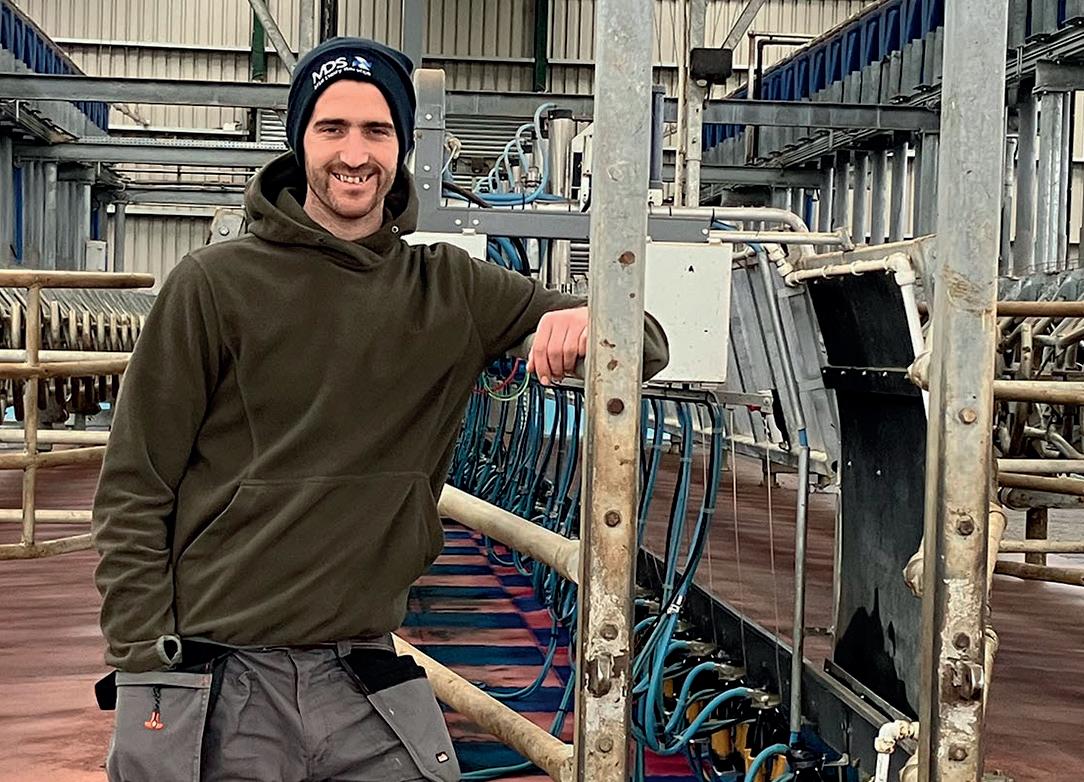
Any cows not destined to produce replacements are bred to beef, with calves taken through to fattening.
Looking ahead, Nathan says he would like to increase cow numbers to 400 cows, and says he would look at all business opportunities including the development of a second dairy unit.
However, for now he adds the business is diverse with the family also running a contracting enterprise for local customers and an agricultural spec shop, which sells anything from 13-amp fuses to fencing requirements.

celebrate with the shortlist, book your seat for the awards night at britishfarmingawards.co.uk
As we head into autumn and winter, focus now turns to utilisation of conserved forages to ensure the hard work of harvesting them, in often tricky conditions, pays off.
The Cargill UK
Fibre Focus project analysed the nutrient content of total mixed ration (TMR) for 25 groups of cows on farms in the UK and Ireland using the polispec NIR reader. Results were compared with accurate calibrations for bre digestibility developed by the company and based on a large-scale TMR results database and specialist knowledge.
Dr Philip Ingram, Cargill’s ruminant technical manager, says: “Access to these calibrations, that are adjusted to account for the types of silages found in the UK and Ireland, has been quite a breakthrough in increasing the accuracy of bre digestibility in our forages than ever before.

“ e same technology has been used to develop calibrations for analysing bre in dung. So, in simple terms, the di erence in bre content between the two tells us how much the cows are digesting.”
Traditional muck sieving was also carried out on the farms in the study to ‘test’ the new technology. Results were comparable.
“But the new way of accessing bre digestibility puts a gure on the result. We know more accurately what feed value the cow is ge ing from the bre in forages,” says Dr Ingram.
e bre focus audit, involving on-farm NIR readings of forage and dung samples using the polispec device, provides an accurate percentage of total tract neutral detergent bre (NDF) digestibility, and is expressed as NDFdig. is
Fibre in forages is the most underused feed resource in dairy cow diets according to a UK and Ireland study that used new technology to investigate fibre digestibility in a range of herds. Dairy Farmer reports.
allows benchmarking between herds and groups of cows within a single herd.
In the trial period from September 2022 to May 2023, Cargill’s calibrations proved to be very accurate, in line with similar trials in herds in Italy and the USA. e trials showed that, at best, only about 50% of the forage bre contributes to
the diet’s feed value. Di erences in bre digestibility were found between herds, and between groups of cows in the herd.
“Early lactation cows had lower bre digestibility than more se led groups of cows,” says Dr Ingram.
“Poor silage quality and a lack of bu er a ected digestibility, and the environment – such as

cow ow and feed availability – made a di erence too. If feed was always fresh and pushed up regularly, bre digestibility was found to be be er.”
Examples
ree examples, which are all housed Holstein herds used in the study, highlight these di erences.



JThe best herd studied in terms of fibre digestibility was a high-performance herd fed on very high-quality grass silage and maize silage plus a range of co-products and concentrates. Cows were fed a compact TMR with a very short chop length and 38% dry matter (DM).
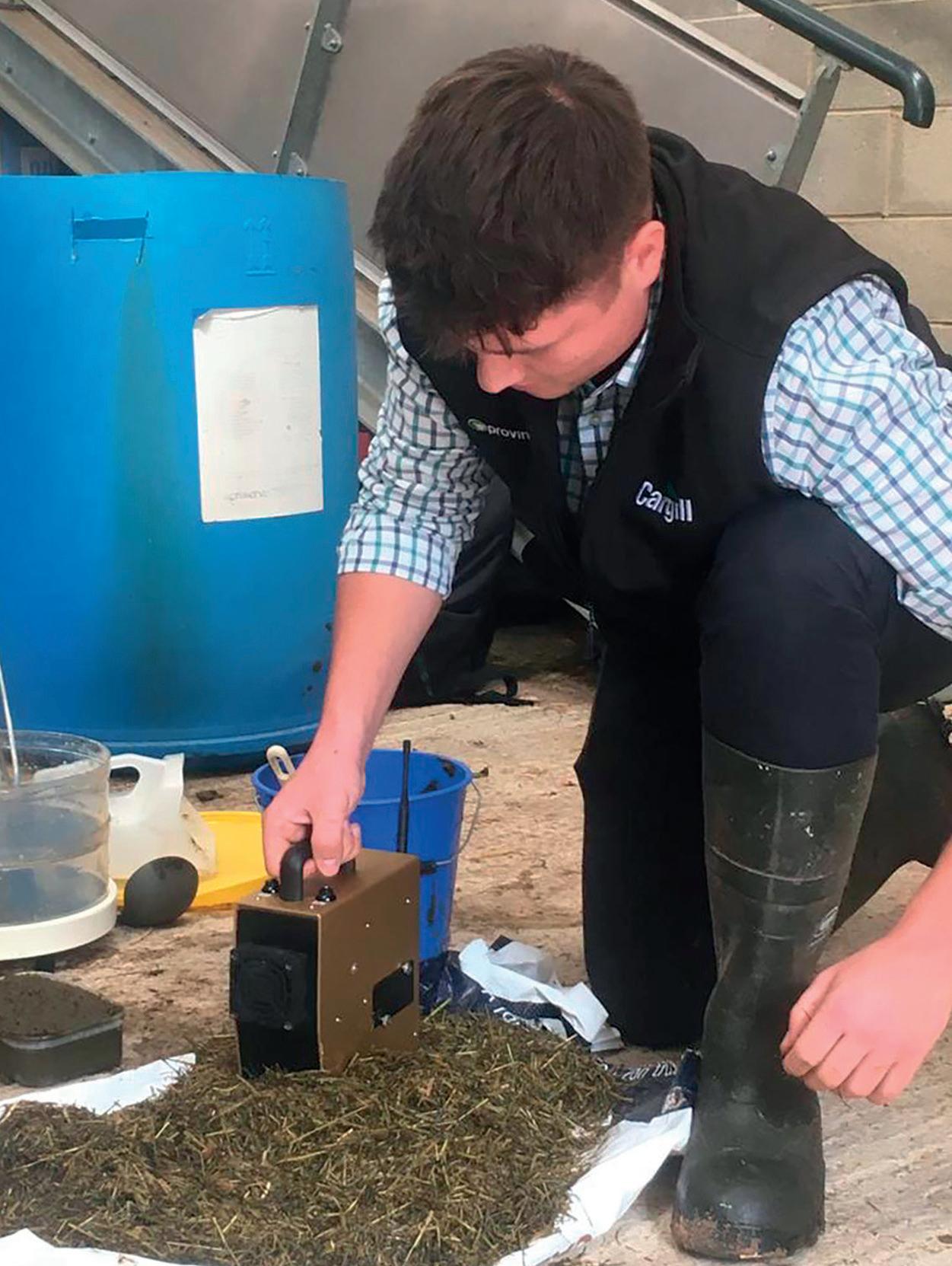

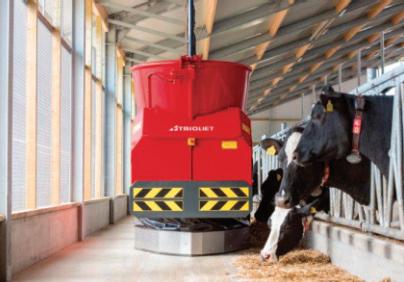

The main group of cows averaged 48.2 litres of milk at 146 days in-milk, and DM intakes of 28.2kg. Fibre digestion for this group was 48.6%.
The low yielding group, giving 31.8 litres of milk at 299 days in-milk, and on the same diet but with additional high-quality grass silage and a total DM intake of 23.5kg, achieved a TTNDFdig of 57.5%.
Dr Ingram says: “The highquality forage in this herd was a great starting point and this was
complemented by a favourable environment and management style. Passageways are exceptionally wide with excess trough space encouraging little and often feeding.

“And the finer details, such as the high-quality silage top up for the lower yielding group, and their slower rumen throughput which helped promote more complete digestion, resulted in our best fibre digestibility result on the study to date.”
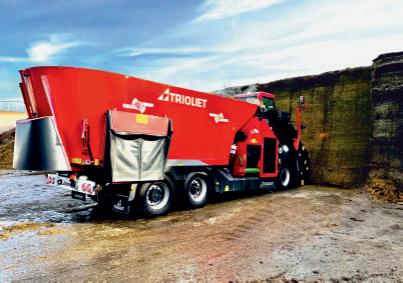
The highquality forage in this herd was a great starting point
DR PHILIP INGRAM
JForage quality on this farm, mainly grass and maize silage, contributed 14.6kg of DM, with 9.8kg of DM coming from other ingredients and a parlour-fed 18% protein. Overall, forage quality in the samples tested was very fibrous and had a lactic acid content above the ideal level.
Dr Ingram says: “Although yields were on par with farm examples A and B, the fibre digestibility for the three groups tested was less, with the freshly calved cow group achieving 19% fibre digestibility.
“Looking forward, the focus on this farm was for better quality forages.
“Also, the diet did not include a rumen buffer, unlike the previous two farms mentioned. Rumen buffers are always an important part of the



ration formulation toolkit, and specialised rumen buffers can make a significant step towards improving fibre use.”
A specialised rumen buffer like Equaliser Fibre+ will hold rumen pH at the correct level and drive fibre digestion.
It also includes the Diamond V yeast fermentation ingredient, which drives the fibre digestion microbes to release energy from cell walls in the dietary fibre. It can improve digestion by 10%, and in practical farm trials it has been shown to increase energy from forage and improve milk yield by 1.34kg per cow per day.
“Farm C will also review the mixing and feeding out of the diet, which can affect intakes and feeding pattern and have a knock-on effect on fibre digestibility,” says Dr Ingram.
JAverage milk yields in this herd are 41.5 litres a day from cows housed full-time and calving all year round.
Cows are split into groups depending on stage of lactation, but all on the same diet, based on quality grass silage and wholecrop silage plus a range of co-products and concentrates, with no in-parlour feeding.
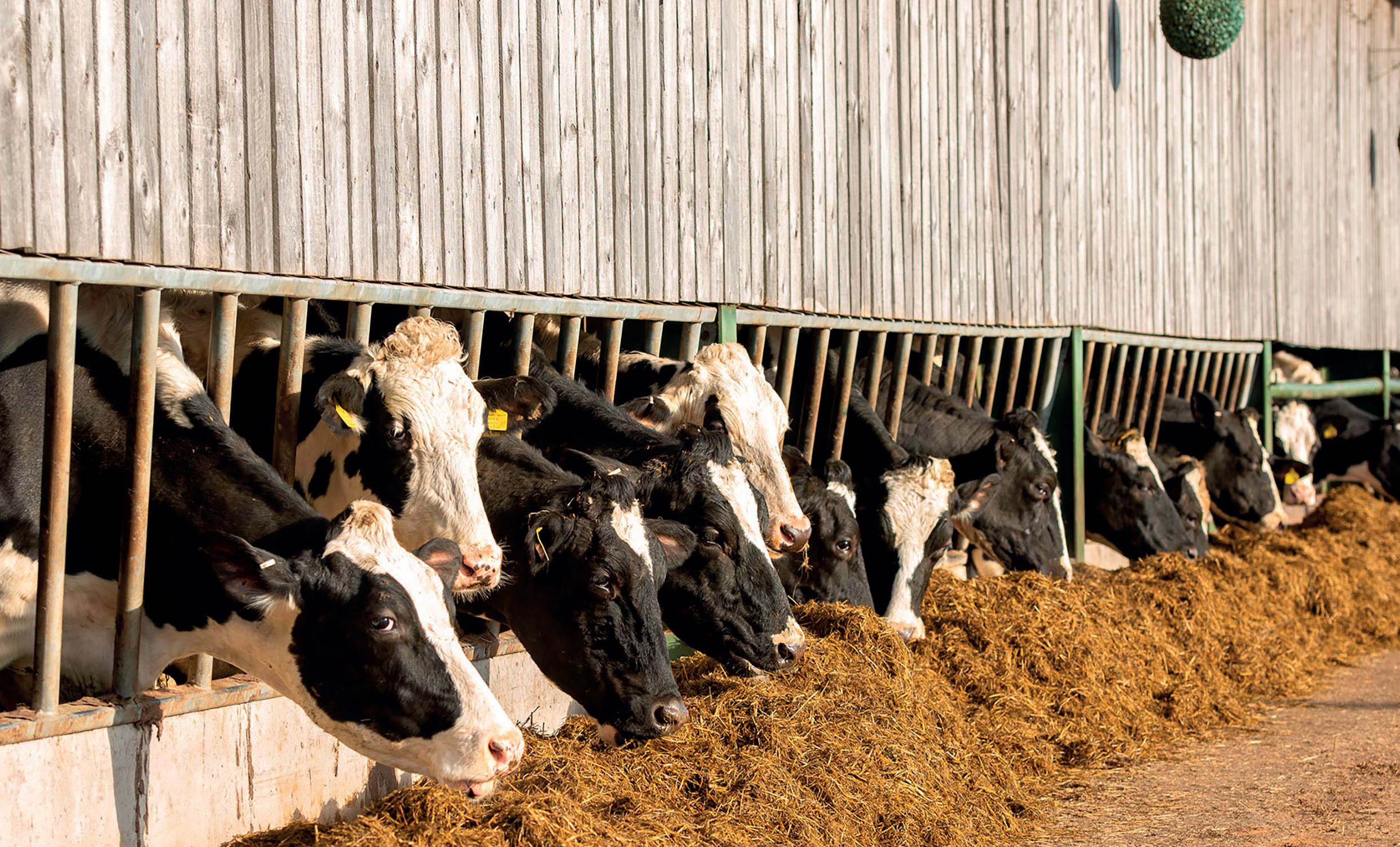
DM intake from forage averages 12.5kg, with a large input from wholecrop barley of 14kg fresh weight.
The fresh group of cows, averaging 27 days in-milk and an overall DM intake of 21.5kg, yielding 33.5 litres a day, achieved a TTNDFdig of 27.4%.
Cows that are 169 days into
JThe Fibre Focus study will continue this winter, and Dr Ingram says more farmers will be encouraged to take part.
“The results have highlighted the missed potential of forages,” says Dr Ingram.
“There has been very little improvement in this area in the past decade at least, and its variability from one year to another means that we cannot

milk and yielding 46.5kg of milk had a DM intake of 26.5kg and an improved fibre digestibility with a TTNDFdig of 35.2%.
Dr Ingram attributes some of this difference in fibre digestibility between the fresh- and mid-calvers as being due to building work in the fresh-calvers’ shed, which limited feed space. This is being improved.
He says: “Mid-lactation cows were accustomed to the diet for a longer period of time and also had a more settled feeding and lying routine, which promoted fibre digestion.
“This digestibility level is perhaps good considering the quantity of wholecrop and straw in the diet.”
assume its quality. So it is important to measure and match what we have and extract more feed value, particularly from the fibre part.
“Fibre digestion is a big driver of milk from forage.
“I think most farms can target at least a fibre digestibility of 40% as a minimum, so there is plenty of opportunity for improvements for many dairy units.”
The study showed early lactation cows had lower fibre digestibility than more settled groups of cows.



Aim to feed a consistent quality mixed ration every day.



If you have two clamps of different silage cuts, open both and feed them together. Feed top to bottom of each clamp so there is the same mix of silage in every feed, while at the same time moving across the face in less than 3-4 days, taking partial grabs if needed, to prevent silage quality deteriorating. Using a condition-specific inoculant increases the shelf-life and palatability of silage.

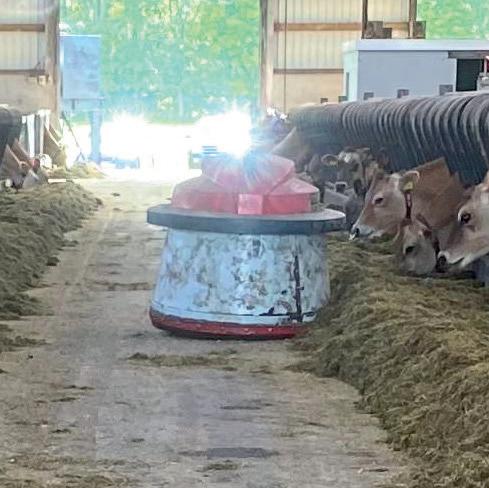
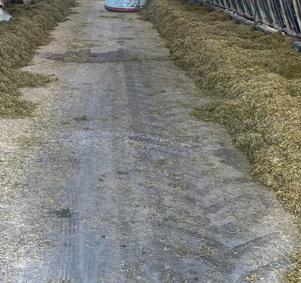







Stimulate cows to access the ration formulated for them throughout the day.

Feeding between milkings and not at milking increases feeding bouts and can improve feed efficiency by as much as 7%. Feeding two times a day or more increases the time spent feeding, reduces sorting and leads to higher milk fat. Pushing feed up regularly cuts down on cows waiting to feed, increasing lying times and rumination.




Add the rumen-specific live yeast, Levucell SC, to rations to improve rumen function.




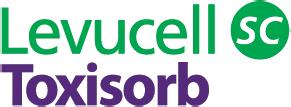
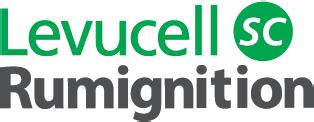
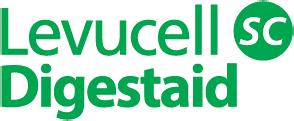





This unique live yeast strain has been shown to both increase feed efficiency and subsequently reduce the carbon footprint of milk production by up to 6% in lactation and when fed prior to calving reduces body weight loss, making a significant contribution to sustainable milk production.






 Pushing feed up
Pushing feed up
Paying close attention to how cows are fed can make a real difference to farm efficiency, profitability and ultimately sustainability.
discusses three important areas where you can make a difference.
Grass silage quality has been variable this year and clamps have not been filled to capacity in some regions, so how can producers redress the balance if crops have fallen below expectations? Wendy Short reports.
Producers who made an early start to silage-making are generally pleased with the results, but there were some disappointments in cases where rst cuts were delayed by wet weather, says Will Tulley of Advanced Ruminant Nutrition.

He says: “May was a cold, wet month, leading to some low-protein/high- bre crops which fell short on quality.
“Meanwhile, June saw high temperatures and low rainfall, which meant some second-cut grass silages were lacking, in terms of both quality and quantity.
“Conditions were more favourable in the second half of the season, allowing for a degree of catch-up.”
Forage budgeting is a fundamental element of any winter feeding plan for dairy cows, he says.
“ e rst step is to make a realistic assessment of silage stocks to determine whether or not the clamps contain su cient material to last until next year’s rst cut silage can be fed out.
“A simple calculation of volume can be made to give an estimation of tonnes of freshweight available.
“ is practice should be continued on a monthly basis, because silage density and dry ma er content will change as the season progresses.
“Regular monitoring will give the opportunity to track how much ca le are eating and, over time, this will give a fairly accurate picture of monthly use, so any supplementary feeding which might be required can be planned ahead.”
e estimated silage tonnage should be considered alongside an initial analysis of nutritional

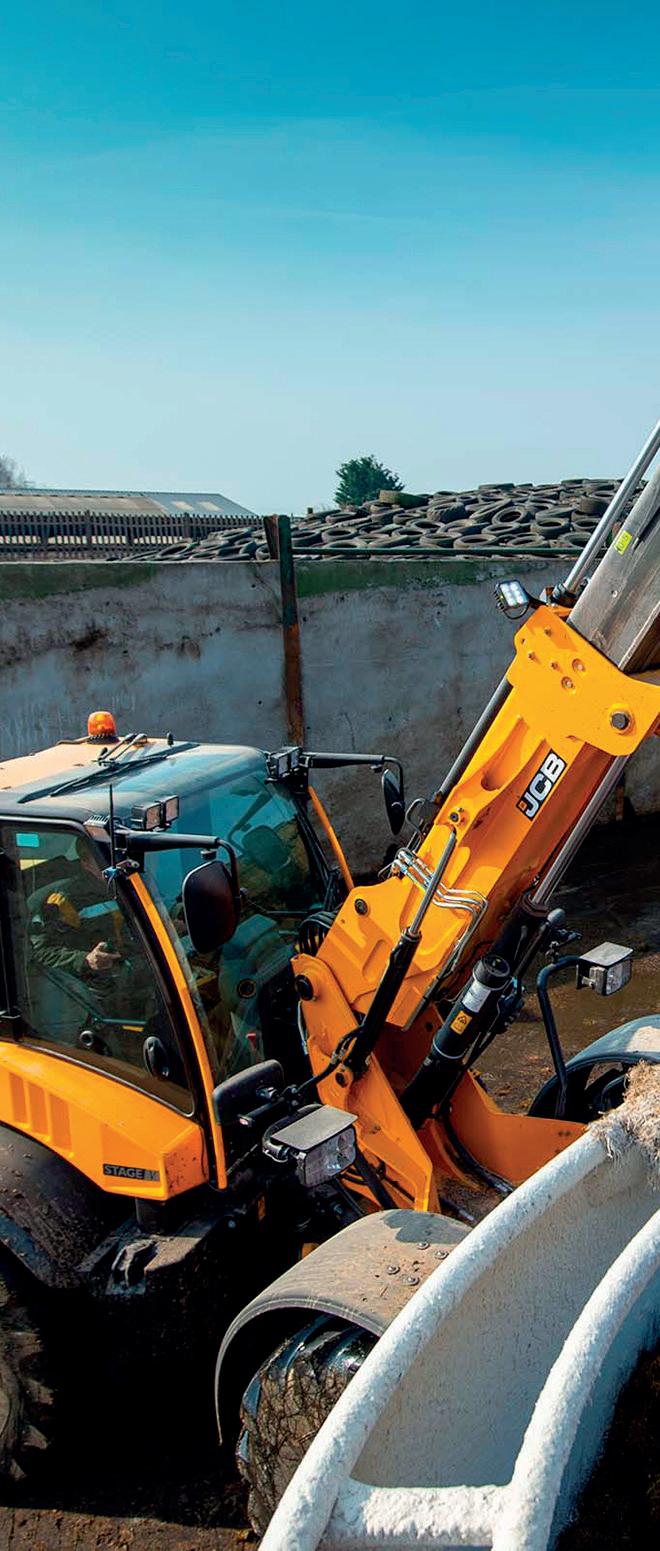
content, and the exercise should be repeated on a monthly basis, he says, as grass silage quality will also uctuate throughout the storage period.
On farms where a de ciency in forage stocks has been identi ed, he suggests a review of livestock numbers.
He says: “Questions to ask would include whether there are any cows in the milking herd which are not performing to maximum e ciency; this will be particularly important in a climate of low milk prices and high feed costs.
“Cows with a prolonged history of mastitis or lameness may not be making a sound nancial contribution to the bo om line.
ere may also be opportunities to reduce heifer replacement numbers or cut down on the number of beef calves to reduce winter forage demand.”
Forage allocation is another important consideration.
“ e be er quality silages can be reserved for the milking herd, with lower quality material of-
fered to youngstock or dry cows. Another alternative is to combine the material from two clamps into one feed, by mixing together poorer quality silage with lea er material of a higher nutritional value.
“Some producers will reserve their be er silage for times when milk prices are on the higher side and open up poorer quality clamps when returns dip.”
Supplementing homeproduced forage with boughtin crops may o er a solution in some situations, although the economic viability of purchased big bale silage or clamped material may depend on travelling distance.
Mr Tulley describes moist feeds, such as brewers’ grains and Tra ord Gold, as ‘forage extenders’ for farms where clamps are expected to run short before rst cut 2024 or grazing turnout.
Meanwhile, grass silage
Urea is relatively low cost and it can help to balance a ration where forage is short of rumen degradable protein
WILL TULLEYForage budgeting is a fundamental element of any winter feeding plan for dairy cows, says Will Tulley.
protein de ciencies can be balanced through the addition of rapemeal or distillers’ grains, as well as soya, if milk contracts permit. Urea is also a good source of protein.
Mr Tulley says: “Urea is relatively low cost and it can help to balance a ration where forage is short of rumen degradable protein. It feeds microbes which degrade bre into protein and will help to maximise dietary forage.”
Rumen-protected fat is a valuable energy source, says Mr Tulley.
“It is not a cheap supplementary feedstu , but it is very high in energy density. Research has shown it has the potential to enhance fertility, so it can have a bene cial e ect in the long-term.
“Starch and sugar can also be fed to o set low-energy silages in the form of small grains, such

• From 8m3 to 45m3 hopper capacities
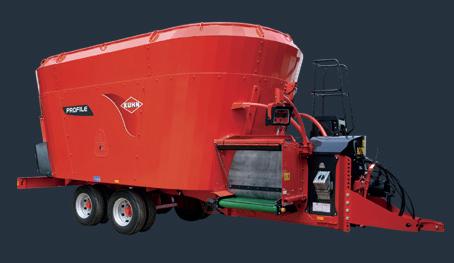

• Single, double, or triple vertical auger

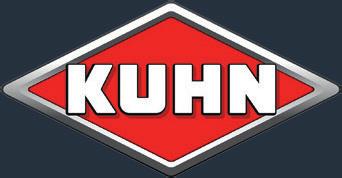
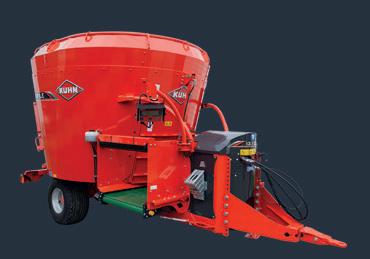

• Programmable weighing and feed tracking
• Direct side or cross conveyor feeding
as wheat and barley, or by adding maize to the diet.
“However, care must be taken to limit cereal intakes, as a high inclusion rate can increase the risk of rumen acidosis, especially when fed in combination with low dry ma er, acidic grass silage.”
Other comparatively cheap feeds include root crops, which can fully, or partially, replace more expensive bought-in concentrate pellets.
ey are typically low in bre and high in carbohydrates and should be treated as a concentrate, rather than a forage.
Mr Tulley says: “Winter ration formulation is not simply a ma er of adjusting the feed for maximum yield. Prior to making any feed purchases, it is worth consulting the farm nutritionist and using a computer so ware program to work out the most cost-e ective plan.”
As thoughts turn to winter feeding, Bruce Forshaw, ForFarmers product manager, explains the importance of silage analysis when preparing diets for the coming season, particularly with current tight margins.
With forage making up such a high percentage of the cow’s diet, it is crucial to know what you are working with, says Bruce Forshaw.
He says: “Go through your planned winter ration sooner rather than later so you can evaluate your stocks.
“If you think you may run out of anything, now is the time to plan for that. In particular, if it looks like you have less than 180 days supply of silage, a moist feed might be a suitable alternative to extend what you have.
“There might also be options to take an extra cut of silage or extend your autumn grazing, if the autumn is dry.”
The ForFarmers’ analyses of this year’s first, second and a combination of third, fourth and fifth cuts show that across the board there is more energy and protein compared to 2022, he says.
High crude protein levels may be, in part, a result of more fertiliser being applied this year than last.
He says: “With these high protein
levels, it is worth thinking about the protein you are buying-in.
“Can you reduce this while maintaining cow performance? Reducing the protein you buy in will reduce costs and contribute to your farm’s sustainability targets.”
Looking at more depth there is some cause for concern from analysis of the second and later cuts.
“They have a lower Conservation Index and a higher Heating Index indicating they are at increased risk of aerobic spoilage and heating once the clamp is opened.
“This is, in part, due to lower lactic and acetic acids and higher butyric acid.

“For second cuts, we are also seeing an average Heating Index of 27.8, which means some will be a higher.
“There is a high risk of clamps heating up and anerobic spoilage, once they are open, meaning energy loss. Good clamp management is going to be crucial this winter.
“We are also seeing higher ash percentages in some first cuts.
“It is creeping up towards 10% in some, which can indicate soil contamination. This might well be as a result of the wet summer and silaging conditions we have had.”
ForFarmers has also compared
the results from silages made using additives with those made without. Those made with additives consistently show higher D value.
This means more digestible organic dry matter which will lead to more milk potential, says Bruce.
“Silage additives might seem like an extra expense, but they help to reduce secondary fermentation, increase palatability and intakes.”
Keeping a close eye on the mineral content of silage is also essential in advance of winter, he says.
“One of the benefits of the extensive ForFarmers network of experts is the sharing of information and insight from farms across the country.
“One colleague based in Shropshire recently shared an interesting observation he had made from customers’ silage analyses.
“He had noticed some high DCAB silages and wondered if this was the same in other areas. This prompted me to look at data from farms across the country with a harvest date of 2023 and yes, the average mineral analysis is showing similar results across the board.
“After further exploration I could see that this was being caused by
Cows fed a diet with high levels of starch and sugars can suffer from impaired rumen performance due to a build-up of lactic acid and volatile fatty acids.
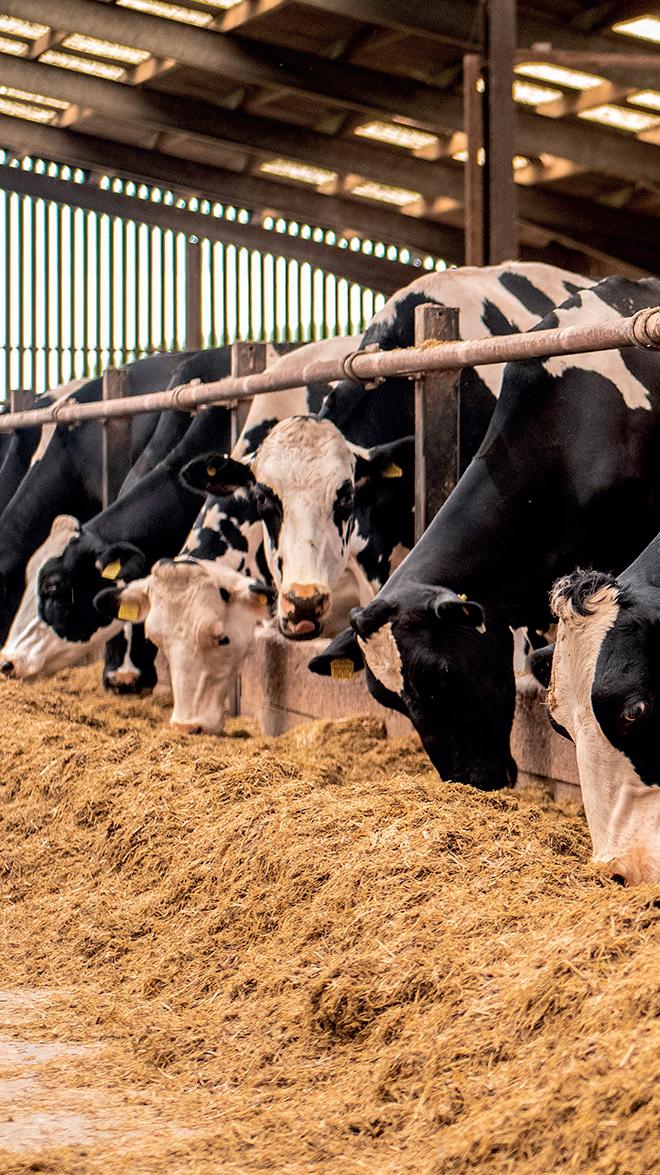
higher than normal potassium levels and lower chloride levels as these are the key parts of a cation-anion balance in a ration.”
While this may not make a huge difference to cows in the milking herd, it can pose a problem for dry cows –both organic and conventional – and can result in milk fever, he says.
“Clinical cases of milk fever might be the only visible signs of the wider issue of subclinical milk fever with dry cows. Do not lose future milk to issues with the dry cow diet.”
It is unclear why this year’s silage is showing raised levels.
“It could be due to a number of factors occurring this season, but what is important is that it has been identified so you can ration accordingly to ensure diets are appropriate.
“When rationing dry cows with full or semi DCAB diets, it is particularly important that mineral analysis is carried out on all forages.
“Our advice is to do the job right when it comes to silage analysis – get full nutritional and mineral analysis of your silage and ration exactly what
your cows need to help them perform at their best while minimising waste.
“Mineral content of silage can catch you out if there is a change, so we recommend all farms take at least one sample at the beginning of the season, especially when rationing dry cows.”
With tight margins it can be tempting to drop supplements from cows’ diets.
Bruce says: “Do not underestimate the benefit they will bring this winter to help you achieve your herd goals.
“Lintec provides a fast-acting source of omega-3 fatty acids which are vital to support high-performing dairy cows.
“On many dairy farms, omega-3 provision is not at optimal levels due to feeding grass silage at variable quantity and quality throughout the season or because of the type of feeding system a farm is operating.

“Offering both milk production, health
and fertility benefits, as well as environmental gains, the targeted feeding of Lintec provides a rare ‘win-win’ nutritional solution within the dairy sector.”
Omega-3 fatty acids play a key role in helping improve successful pregnancies and successful heat detection, says Bruce.
“About 75% of developing embryos are lost within the first 21 days of pregnancy. This is often due to hormonal imbalance in the cow, with insufficient signals being transmitted from the embryo to make a cow aware she is pregnant, resulting in frequent embryo loss.”
The high levels of omega-3 fatty acids found in Lintec have been shown to rebalance cow hormones, boost progesterone levels and suppress prostaglandin levels; all of which help a cow to maintain her pregnancy once in-calf.
Due to the effect Lintec has on cow behaviour during their oestrus cycle, cows also display stronger signs of
heat which last longer, making heat detection easier too.
This in turn helps to improve the number of successful services and boosts pregnancy rates.
Bruce says: “As all dairy producers know, a healthy cow is an easyto-manage cow. Cows with fewer health complaints are also likely to be more productive, profitable and stay within the milking herd for a longer period.
“So anything which can be done nutritionally to support cow health is a good idea.
“Overall cow health will benefit from Lintec thanks to the reduction of acid loading within the rumen.”
Cows fed a diet with high levels of starch and sugars can suffer from impaired rumen performance due to a build-up of lactic acid and volatile fatty acids (VFAs), he says.
“This, in turn, can reduce rumen pH, making it more acidic and cows are therefore susceptible to acidosis.”
Lintec aids the removal of VFAs

from the rumen and therefore works to increase rumen pH, stabilise the rumen environment and ensure optimal rumen performance – all of which will improve fibre digestion, feed efficiency, cow performance and health.
As well as supporting better cow fertility, Lintec has also been shown to have a positive impact on both milk yields and quality.
“Lintec’s high levels of omega-3 fatty acids help increase feed efficiency with the addition of energy in the form of fat.
“This in turn reduces the amount of energy wasted in the rumen and the wasted energy which is ‘suppressed’ would usually take the form of methane.”
With improved efficiency in the rumen and udder, there is more energy available for milk production, he says.
“It is therefore unsurprising that herds feeding Lintec at 0.5-1.5kg/day can experience an uplift in milk yield of up to three litres per cow per day.”

Feeding high-quality silage with a metabolisable energy of 11.5 or higher can achieve an extra 2.35kg of milk per cow per day, as well as help reduce a herd’s carbon footprint. Dairy Farmer reports.
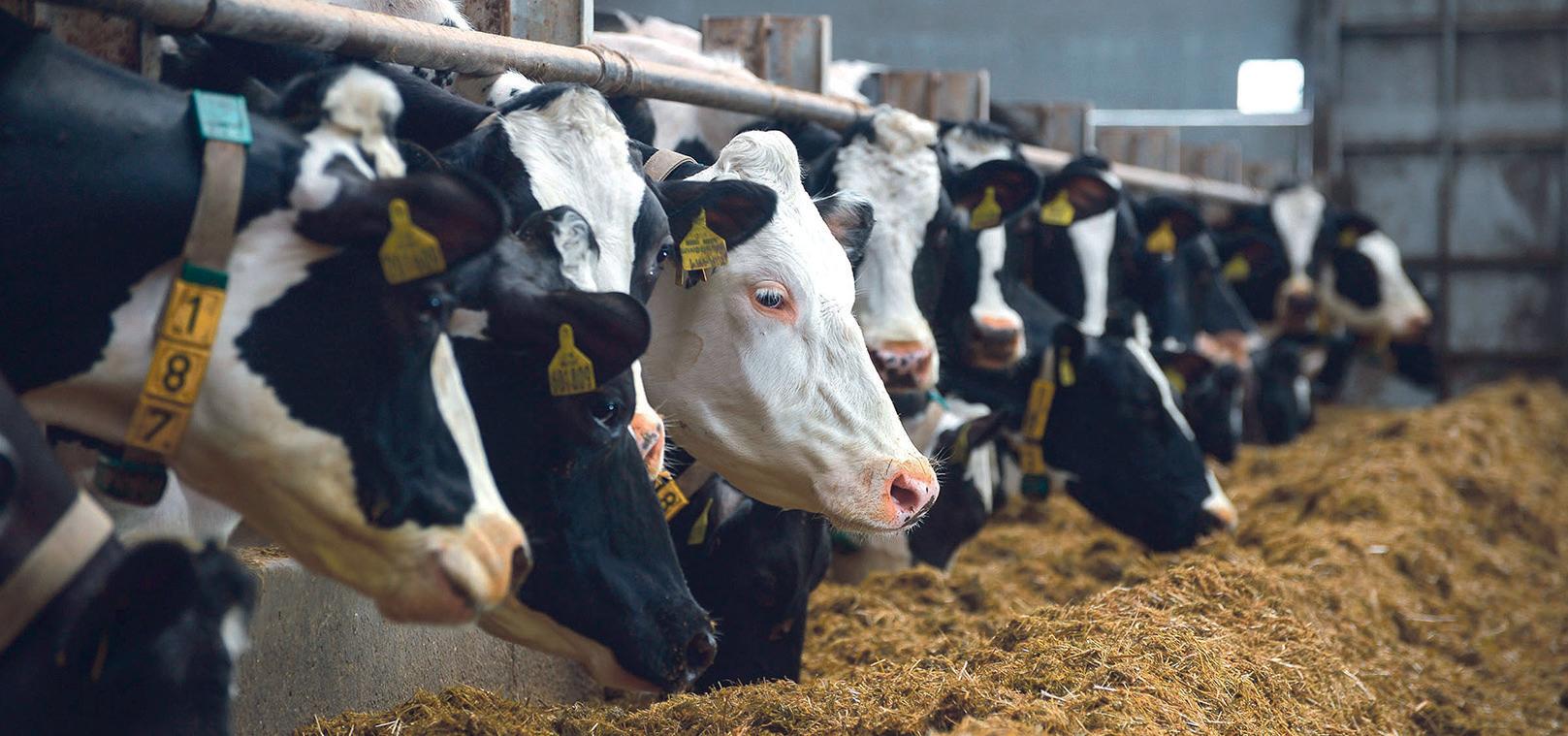
Incorporating high-quality silage into the ration can reduce the need for compound feed inclusion, resulting in lower greenhouse gas emissions and a more cost-effective diet, according to new data.
David Howard, head of dairy at Wynnstay, says forage budgeting is crucial when it comes to formulating rations which boost milk production and reduce emissions.

He says: “Feeding a consistent ration throughout winter will benefit the cow, be more costeffective and help reduce a farm’s carbon footprint.
“To achieve this, farmers should work with their nutritionist to balance the forage and concentrate elements of the ration, so a consistent diet can be fed throughout the year.”
He says it is important for farmers to review what they are feeding regularly, because compound feed is the most expensive component of the ration.
Mr Howard says: “If you could decrease the amount of compound feed in your diet while maintaining milk yields, this could reduce emissions and ration costs.”
Feeding a high-quality forage can enhance milk from forage and feed efficiency and, as a result, provide the added benefit of a reduced carbon footprint, says Mr Howard.
Drawing on data from 1,228 grass silage samples taken from Wynnstay
customer’s farms, he says 20% of the samples were classed as high-quality, meaning they had a metabolisable energy of 11.5 or higher.
Mr Howard says: “The farmers producing silage in that high-quality bracket will be seeing the rewards in terms of more milk from forage, meaning they are able to produce more milk from that ration, reducing their reliance on purchased feeds.
“Our data shows that when feeding grass silage with a dry matter intake of 12kg, the difference between feeding a high-quality silage and an average-quality silage is that an additional 2.35kg of milk will be produced per day from the cows receiving the high-quality silage.
“The increased feed efficiency not only significantly benefits milk yields, but it also reduces carbon emissions, as fewer purchased feeds are required to produce each litre of milk.”
Further to Wynnstay’s insights, Trouw Nutrition has evaluated forage samples and optimised diets in order to understand the impact of high-quality versus low-quality silage on carbon emissions using its MyMilkPrint digital service.
The best 20% and worst 20% of silage samples analysed by the Trouw Nutrition laboratory in 2022 were used. The high-quality silage had a D-value of 72 and crude protein of 16% dry matter, while the low-quality silage had a D-value of 65 and a crude protein of 13.9%.
The company compared both silages when used in a silage and compound-based diet, which was optimised to meet the nutritional requirements for producing 30 litres of milk a day.
Outlining the findings, Dr Liz Homer of Trouw says: “The ration formulated with the high-quality silage included a larger quantity of silage than compound, whereas the lower quality silage required more
compound to meet the nutritional requirements of the cow.”
She says the compound feed incorporated into both rations had the same carbon footprint per tonne, even though different ingredients and formulations were used, however different amounts of the compound were required.
Dr Homer says: “As a result, the carbon footprint per kg of fat and protein-corrected milk was 3% lower in the ration including high-quality silage versus the low-quality silage.
“To achieve these environmental and financial gains, farmers need to work closely with their nutritionist to find the right balance within the ration to avoid a drop in milk yields.”








Acid Buf is a proven rumen bu er, serving as the foundation of our strategy for winter feeding success. Its critical role lies in maintaining a stable rumen environment, while feeding and management pressures may increase for cows housed over the winter period.
Acid Buf prevents rapid pH fluctuations in the rumen, crucial when cows are fed high levels of concentrates or when forages have low levels of e ective fibre.
By stabilizing pH levels, Acid Buf fosters an environment that promotes the fibre digesting microbes. This enhances the digestion of fibrous feeds such as silage and straw, commonly used in winter rations.
Weed Reduce lactate producers
Seed Optimise rumen environment

Acid Buf 0.77a Time spent below pH 5.5 (hours) Positive control 3.17b (Neville et al., 2019) Control 6.10c










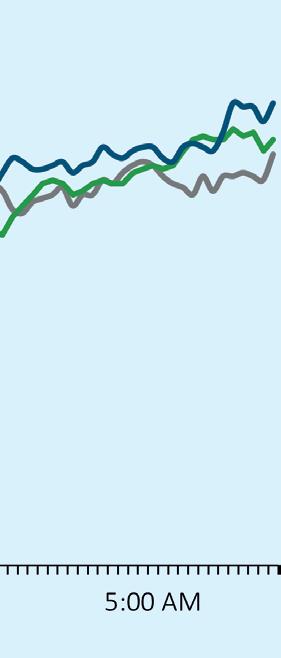













In tandem with Acid Buf, Vistacell plays a pivotal role in optimizing rumen health. Once the rumen has been bu ered by Acid Buf, Vistacell introduces live yeast into the rumen environment, nurturing beneficial microorganisms crucial for rumen health optimization via the Weed, Seed and Feed e ect.
Vistacell's yeast strain creates an ideal environment for cellulolytic bacteria–enhancing fibre digestion and overall feed e ciency. By supporting the rumen, cows can extract more from feeds, maximizing nutritional value.
Vista Pre-T is a forage pre-treatment applied into the feed-wagon which begins to roughen up fibre before feed out, so the feed utilisation in the rumen can be increased. By increasing energy potential in the ration, farmers have the flexibility to decide how this is used - by either pushing for extra performance or reducing feed costs by taking out other more expensive energy sources.
Winter feeding doesn't have to be a daunting challenge. With Acid Buf, Vistacell and Vista Pre-T, you have a comprehensive solution at your disposal. These advanced products optimise rumen health, enhance forage utilisation, and improve feed e ciency.

Many farmers will be having to ration cows with more variable grass silage with potentially lower digestibility this winter. Dairy Farmer gets advice on how to make the most of it.
Acombination of precise ration formulation and reviews of the diet, careful feed management and keeping a close eye on the cows, should help ensure maximum use is made of forages this winter, says Promar consultant Izzi Knowles.
She says the aim must be to maximise intakes while promoting optimum rumen function.
Early indicators suggest many grass silages will be characterised by higher neutral detergent bre and lignin content and reduced levels of rumen-fermentable carbohydrates. Ms Knowles says the consequences will be reduced bre digestion leading to slower rumen throughput and depressed intakes.
Energy
She says: “Make sure the rumen microbes are adequately supplied with rumen-fermentable energy to promote a more e ective fermentation, perhaps by adding starch sources such as rolled cereals or molasses to provide sugars.
“If more starch is added to the diet, there will be an increased risk of sub-acute rumen acidosis (SA ) so make sure there is a good balance of starch, sugar and bre energy sources and if necessary consider adding rumen bu ers to help manage rumen pH.”
Given the variable weather throughout the silage season, Ms Knowles stresses the

importance of ge ing all clamps analysed regularly throughout the winter — ideally monthly.
She says regular analysis is the only way to know the quality of silage being fed and the information can be used to ne tune diets and to decide which silage should go to which groups of cows.
“With infrequent testing it is probable that forage quality changes will go un-noticed, which will result in the diet becoming unbalanced and a ecting performance.”
Where possible, she recommends the best quality silage should be fed to cows in the rst 30 days of lactation as they need to build dry ma er intakes and are most susceptible to rumen problems.
A er this, focus the best silage on higher-yielding cows not yet in calf, spli ing the herd where possible to allow di erent quality silages to be fed to di erent stages of lactation.
Once the diet has been correctly formulated and all steps
taken to promote higher intakes, Ms Knowles says the next stage is to monitor the cows for signs of how well the diet is being used.
She advises keeping a close eye on daily bulk tank readings and feed rejections. Variable yields and intakes are a sure sign of problems with the diet.
She says: “If you are clearing more feed out of the troughs, then there must be a reason the cows are not eating it.
“Look for signs of sorting. If there is waste in a particular part of the trough, this might indicate problems with mixing or ventilation within the sheds.
“Variable dry ma er intakes are an indicator of poor rumen health, so look out for other signs of SA including variable dung consistency and frothy dung.
“To check on rumen function, invest in some dung sieves and routinely sieve dung from di erent groups of cows, especially when clamps are changed.
“If rumen function is good, you should expect less than 10% of sieved material in the top sieve and more than 50% in the bo om sieve.
If there is more material in the top sieve, then bre is not being fully digested, which is depriving the cows of energy, so look at ways to increase rumen health and microbial activity.

“It will also pay to keep a close eye on milk urea levels.
“Levels above 220-280mg/ litre suggest that protein is not being utilised and that it will
pay to ensure the correct proportions of the di erent protein fractions, especially given the current price of protein commodities.”
If you are clearing more feed out of the troughs, then there must be a reason the cows are not eating it IZZI KNOWLESIncreasingly variable silage could impact performance this winter.
JTo help encourage higher intakes Ms Knowles says it is vital to minimise clamp contamination and waste. Here are her top tips:



rNever feed spoilt silage and use a block cutter or shear grab to ensure a clean, tight clamp face
rFork off any mouldy silage and clean it from the face
rKeep the feed trough clean. Remove any uneaten feed to prevent heating

when new feed is placed on top of rejected feed
rFocus on presenting a well-mixed diet to encourage better intakes. Get the feeder wagon checked and replace knives when required to ensure the diet is well mixed

rEnsure the diet is loaded in the right order, that the mixer is not overloaded and that the diet is mixed for the correct length of time
JMs Knowles says it is important cows have adequate time to achieve high intakes.
rEnsure cows have adequate trough space, at least 60cm/cow and up to 1m for high yielding cows

rIf the silage is more difficult to digest, it will be vital to ensure cows have access to cubicles or straw yards to promote rumination, allowing at least 12-14 hours lying time
Technical AdviserFor more details about OsmoFit contact Laura at trouwnutrition.co.uk/osmofit






“Hydration of calves with OsmoFit is easy and key to maintaining health, performance and growth.”
Izzi Knowles
ith autumn block calving underway, farmers are being urged to act now to prevent milk losses due to ketosis and transition-related disease.
Roxy Winstanley, key account manager at Elanco, says with milk prices dropping off, it is important cows reach peak milk production as quickly as possible after calving, while staying healthy, to protect margins.
“Although autumn block calving helps streamline management, calving a lot of cows at a similar time can result in additional stress to the animals,” says Ms Winstanley.
“A higher stocking rate in the shed can increase competition for cubicles as well as feed and water space.

“This means that some cows may struggle to get the nutrients they require, decreasing the amount of energy available post-calving. This can increase the likelihood of them developing ketosis.”
Approximately 75% of diseases in dairy cows happen in the first month post-calving, with 50% of cows developing some level of ill health. This includes ketosis, which is a ‘gateway’ disease, and increases the likelihood of other conditions occurring.
Ms Winstanley says: “Cows with sub-clinical ketosis are 1.5 times more likely to go lame, twice as likely to develop mastitis and six times more likely to develop cystic ovaries.
“When you consider that treatment for mastitis alone can cost between £70 and £250 per cow, this quickly adds up.”
While 0.5% of cows might develop clinical ketosis, up to 60% of freshly calved cows can have sub-clinical ketosis.
Although it often goes undetected, it can have huge implications on milk yields and the overall health and performance of the herd.
Ms Winstanley says: “Over the course of a lactation, subclinical ketosis can lead to direct milk loss of 340kg for a cow and 500kg for heifers.
“Sub-clinical ketosis can also
have a direct effect on fertility by delaying oestrus post-calving and reducing conception by 50%.”
To help mitigate the negative energy balance that causes ketosis, Ms Winstanley recommends administering a monensin bolus to at-risk cows.
“To identify those at-risk, think of the acronym, SOFT. This means cows that are Sick, Old, Fat, Thin or Twin-bearing. These individuals have the highest chance of
developing ketosis and should be targeted for treatment,” she says.
“Administering the bolus around three weeks before calving can help change the microbes within the rumen to make them more efficient at producing energy for the cow.
“It is an effective way to shrink the negative energy gap, prevent ketosis and protect your herd from increased disease levels immediately after calving,” she says.
JAll cows will drop their dry matter intake a few days before calving, but it has been shown that the cows that show the largest drop in intake, and are slowest to recover, are the cows most
likely to get sick after calving. Rumen fill scoring gives an estimate of the daily dry matter intake for the individual cow, which gives an indication that the cow is able to access sufficient feed.
Over the course of a lactation, sub-clinical ketosis can lead to direct milk loss of 340kg for a cow and 500kg for heifers
ROXY WINSTANLEYA higher stocking rate in the shed can increase competition for cubicles as well as feed and water space.
NASYM" : lyophilisate and solvent for suspension for injection or nasal spray for cattle. Each 2ml dose contains: Live attenuated bovine respiratory syncytial virus (BRSV), strain Lym-56 10 4.7 - 6.5 CCIDS0 INDICATIONS: Active immunisation of cattle to reduce virus shedding and respiratory clinical signs caused by bovine respiratory syncytial virus. For more information about side-effects, precautions, warnings and contra-indications please refer to the packaging or product leaflet. Further information available from SPC or on www.hipra.com. MARKETING AUTHORISATION NUMBERS: UK(GB) Vm17533/5008, UK(NI): EU/2/19/241/001-2. MARKETING AUTHORISATION
HOLDER: Laboratories Hipra, S.A. Amer (Girona), SPAIN. LOCAL REPRESENTATIVE: HIPRA UK&IRELAND, Foxhall Lodge, Foxhall Road, NG7 6LH, Nottingham, United Kingdom, Tel.: (+44) 0115 845 6486, ukandireland@hipra.com, www.hipra.com. LEGAL CATEGORY: UK: POM-V. Veterinary medicinal product subject to veterinary prescription. Use medicines responsibly. Under veterinary prescription, advice should be sought from veterinary prescriber
HIPRABov1s·�: Inactivated vaccine with Histophi/us somni and Mannheimia haemolytica leukotoxoid in injectable emulsion for cattle INDICATIONS: For the reduction of clinical signs and lung lesions caused by Mannheimia haemolytica serotype Al and Histophilus somni in calves from 2 months of age. For more information about side-effects, precautions, warnings and contra-indications please refer to the packaging or product leaflet. Further information available from SPC or on www.hipra.com. MARKETING AUTHORIZATION NUMBER: UK: Vm 17533/4005 MARKETING AUTHORIZATION HOLDER: LABORATORIOS HIPRA, S.A. Avda. La Selva, 135. 17170Amer (Girona) Spain. Tel (972) 430660 - Fax (972) 430661. LOCAL REPRESENTATIVE: HIPRA UK&IRELAND, Ltd Foxhall Business Centre, Foxhall Lodge, Foxhall Road, Nottingham - NG7 6LH - UNITED KINGDOM. LEGAL
CATEGORY: UK: POM-V. Use medicines responsibly. Under veterinary prescription, consult your veterinary prescriber for further advice.
Safety and efficacy of these products together have not been evaluated. A decision to use either of these vaccines before or after any other veterinary medicinal product therefore needs to be made on a case-by-case basis.


HIPRA UK AND IRELAND Foxhall Lodge, Foxhall Road, NG7 6LH, Nottingham, United Kingdom Tel (+44) 0115 845 6486 · ukandireland@hipra.com · www.hipra.com

Nitrogen use efficiency is set to become a core measure of dairy nutrition, helping reduce feed costs and environmental impact. Dairy Farmer reports.
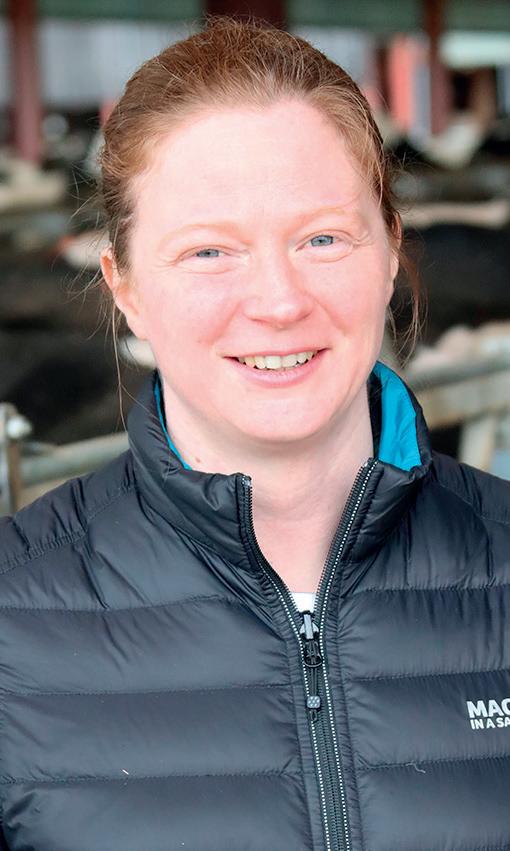
ith the economic pressure on margins and increased emphasis on reducing emissions, cu ing waste is key. Since cows waste about 75% of all the nitrogen they are fed, nitrogen and protein are a good place to start.
“Proteins are the most expensive commodity ingredient in dairy diets,” says Kirsty Farnan from Adisseo.
“Soya is currently trading at about £450 per tonne while rape is about £280. So if we can reduce protein in diets, we can start to cut feed costs.
“With this year’s grass silages coming in at lower crude protein contents than previous years, it is likely that inclusion rates for commodity proteins could actually increase.
W“Feeding less protein and increasing the e ciency with which cows use that protein can also reduce emissions. Unused nitrogen is excreted; much of it as ammonia and nitrous oxide, which is about 10 times a more potent contributor to global warming than methane.

“At some time, it will come under closer scrutiny.”
Ms Farnan says paying closer a ention to how well cows actually use the nitrogen fed in their diets by monitoring nitrogen use e ciency (NUE) can help address both these issues. NUE is simply the proportion of nitrogen fed that is captured and used for maintenance and production as milk protein.
Currently, NUE averages at about 25% in the UK. In other words, three-quarters of the nitrogen fed is just excreted,

creating a nutrient and economic loss.
“By improving NUE, we can help to control feed costs, improve performance, and reduce the environmental consequences of dairy farming. But this will
mean challenging the current UK’s philosophy about how we ration and feed cows to meet their nitrogen requirements.
“Cows do not actually need protein – they require amino acids. e supply of amino acids
By improving NUE, we can help control feed costs, improve performance, and reduce the environmental consequences of dairy farming
KIRSTY FARNANFocusing on NUE has the potential to significantly reduce total feed costs while also decreasing the environmental impact of feeding too much protein.
allow cows to synthesise speci c proteins such as milk protein or body protein.”

All proteins are made up of a combination of amino acids. ere are 20 amino acids and 10 are classed as essential, meaning they need to be supplied in a cow’s diet. When protein is fed to the cow, a signi cant proportion of the protein is broken down into nitrogen and amino acids. ese are reconstituted in the rumen into microbial protein, which passes into the hindgut to supply amino acids for the cow to use.
In the hindgut, the microbial protein is joined by bypass protein, which is protein that avoided fermentation in the rumen. Together, these are used to meet the cow’s metabolisable protein and amino acids requirements.
“A diet must provide the balanced supply of amino acids the cow requires, and this is not directly linked to the amount of protein fed in the diet. It is possible to feed high levels of protein and still not satisfy the amino acid supply. is is due to the di erent amino acid pro les of feed ingredients.
“As soon as an amino acid becomes limiting – in other words, there is not enough to meet requirements – performance is a ected. Cows will divert the available amino acid from functions like the immune system, fertility and milk protein to maintain production.”


It is estimated that 90% of UK dairy diets are de cient in methionine, the rst limiting amino acid. Lysine is the second limiting amino acid.
“ e usual approach when formulating diets is typically overfeeding metabolisable protein to try and ensure the cow is supplied with all the amino acids required. is imprecise approach pushes up protein use and costs while also depressing NUE. ere is no guarantee that feeding more protein in total will meet cow amino acid requirements.”
Instead, Ms Farnan advises formulating diets to amino acid requirements – what the cow actually needs – and, if required, then supplement the diet with rumen protected amino acids.
“UK herds following this approach have been able to achieve an NUE of 35%.



Current nitrogen use efficiency average in the UK.
is increase in NUE compared to the UK average is equivalent to feeding about 1kg less protein per cow per day, or the equivalent of 2kg less soyabean meal per day.

“A typical UK dairy diet is 17-18% crude protein, and this oversupplies metabolisable protein [MP] by 8-10%, while o en still failing to supply su cient essential amino acids. As such, this contributes to poor NUE. A diet formulated to balance amino acids will be closer to 14-16% crude protein, with a MP oversupply of less than 5%, delivering more closely to what the cow requires and allowing them to be more e cient.”



Currently, fewer than 10% of UK dairy
herds are fed this way, while the majority of herds in the US are formulated for amino acids with all the rationing so ware used for balancing amino acid supply. As a result, US diets are closer to 15% crude protein.
“Speci c amino acid supplements allow diets to be formulated to lower total crude protein to meet requirements more precisely. For example, MetaSmart is a rumen-protected source of methionine.
“Adding 35g per cow of MetaSmart would improve methionine supply and allow a reduction of 1kg per day of soya in the diet. is would make around 0.9kg of dry ma er intake available, which could be used to increase total energy content, stimulating increased microbial protein production.”

Equaliser ® rumen buffer is the first buffer to work truly in sync with the rumen needs. Fast-acting and long lasting, it maintains digestion and performance throughout the day.


Available in forms to suit every herd’s dietary needs, the range of Equaliser® buffers ensures optimal usage of homegrown and bought-in ingredients, improving economic and environmental return on investment
To find the right Equaliser ® to power your herd’s performance visit: www.provimi.eu/uk-equaliser

@CargillAnimalUK

Looking more closely at dietary sugars will help unlock the value in this year’s silages and help offset the consequences of more volatile major feed commodity markets. Dairy Farmer reports.
Nutritionists will have to plan rations carefully this year, paying close attention to rumen health and function to maximise forage intakes and ensure cows get the most from forage.
This is the message from Georgina Chapman of molasses blends specialist ED&F Man, who says: “The good news is there are proven solutions to help tackle the specific characteristics of this year’s forages and build effective diets.”

Ms Chapman says that overall grass silages energy levels are slightly reduced, and sugar levels are significantly lower this year. Lignin levels are higher which will affect digestibility while rumen fermentable carbohydrates and proteins are also reduced.
“Many of the challenges when feeding this year’s silages can be tackled by looking closer at the levels of sugars in the diet. Adding sugars, in the form of molasses blends can help improve fibre digestion which will release more of the nutrients in forage while also increasing diet palatability and homogeneity to stimulate intakes.
“Sugars will also stimulate microbial production and supply rumen fermentable carbohydrates without inc-
reasing the sub-acute ruminal acidosis [SARA] risk and can increase dry matter intakes without causing excess rumen fill.”
Ms Chapman says most UK diets are typically about 2% sugars in the dry matter, which is significantly below requirements.
For optimum performance, early lactation cows require 6% sugars, and cows at peak production require 8%. Even late lactation animals need 6% sugar in the diet.

“Filling this sugar gap provides cows with valuable rumen fermentable carbohydrates to fuel the rumen micro-organisms, which will encourage better fibre digestion.
“When lignin and neutral detergent fibre levels are high, the energy in fibre is more difficult to extract. By stimulating the rumen micro-organisms, sugars accelerate fibre digestion, reducing the proportion of undigested fibres which are just excreted, wasting energy.
“Adding the optimal level of sugars in the diet also influences rumen fermentation in two significant ways. The first is that they contribute to increased microbial protein production, which is the most important protein source for ruminants.
“With volatile protein prices, optimising microbial production will be especially important this year. Sugars are more rapidly fermented than starches and fibres, providing the instant energy boost to promote more microbial protein synthesis.”
Although rapidly fermented, Ms Chapman is quick to stress that sugars do not contribute to issues with SARA, commonly seen when cereals are increased in diets.
She says: “This winter it may be tempting to increase cereals in the diet to provide more rumen fermentable carbohydrates, especially if more cereals enter the
feed market due to reduced milling and malting quality.
“From a rumen health standpoint, increasing sugars is likely to be the better option.”
Molasses blends offer an ideal combination of rumen fermentable carbohydrates along with regulated release protein to balance the reduced fermentable proteins in silages.
In trials at the University of Reading, collaborating with CIEL, cows were fed two diets. The only difference between the two was that in the trial diet some of the blend was replaced by Regumix, a 67% dry matter, 27% protein molasses blend with 53% sugars.
“The dietary impact of adding the molasses blend was to increase the sugar content in the diet to fill the sugar gap while also reducing the levels of starch.”
Cows fed the diet with the molasses blend had higher dry matter intakes, and the yield of fat corrected milk was increased mainly as a result of significantly higher butterfat levels, indicating better fibre digestion.
In addition, cows fed higher sugars spent 35% less time above the SARA threshold pH of 5.8 indicating a better rumen environment.
“All the data indicate that rumen function was more effective and that fibre digestion increased, but interestingly methane production reduced per day and per litre of milk produced.
“An increase in fibre digestion is typically linked to increased methane output. However, as this was not the case when a molasses based liquid feed was fed, this suggests that feeding optimum levels of sugars can help improve the use of home-grown forages while also being a sustainable option.”
Sugars are more rapidly fermented than starches and fibres, providing the instant energy boost
GEORGINA CHAPMAN









For those faced with a shortage of labour, the rise of robotic milking machines has been a viable solution for many dairy farms seeking to continue or expand production.
For Louis Staddon of AG Staddon and Sons, that process was put into full swing when the family business looked to replace a 40-year-old parlour in 2011.

“We bought two of DeLaval’s robot milking units for our 120-cow herd,” says Louis.

“ e robots o ered a short-term milking solution, as at some point we were also faced with relocating our farming business.

“At that time, there seemed li le point investing heavily in a parlour, knowing we had to move. So the robots gave us the exibility to bring them with the herd.”

Initially, the farm had two units installed, but when the Staddon family started its relocation to Westwood Farm – part of the Shakenhurst Hall Estate at Mamble, Worcestershire – a third robot milking unit was bought.
“ e third unit was the rst robot to be installed at
After migrating from a traditional parlour to a multiple robot milking system, a Worcestershire dairy has reverted back to a parlour, as its business follows a process of efficient herd expansion. Geoff Ashcroft reports.
Westwood Farm,” he says.
“And as the herd was moved in stages, so too were the other milking units. We never stopped milking throughout the reloca-
tion, and then we pushed cow numbers up to 150.”

However, the experience of robotic milking has not been plain sailing, or entirely positive. Mr Staddon was then the only one receiving alarm calls, and the need to be close by for incomplete cows, mastitis issues or breakdowns meant a member of sta was always available on-site.
“ e robots did work well for us, and they provide a huge amount of cow information if you want to make use of the data,” he says. “But you cannot simply put them in and walk away, as they still demand an
amount of your time – it is just not spent carrying out the physical process of milking.
“On a more positive note, there is more time available for livestock husbandry.”
As a 526-hectare (1,300-acre) mixed farm with 283ha (700 acres) of arable cropping, Westwood Farm has to use its resources e ectively and e ciently to ensure its mixed farming enterprises complement each other, and return a pro t.
When it came to dairy herd e ciency, and the long-term
plan to more than double the herd size and increase milk production, there had to be further change.

“As we prepare for a time without the single farm payment, we need to be milking more cows,” he says.
“But doing so means becoming much more e cient in the way we run and manage the process. Our robots were 10 years old, and had become more expensive to run and also more unreliable.

“All three were costing £3,000 per month on a service contract, and with a pending energy price hike, we faced an estimated monthly running cost of about £14,000 just to stand still.”
He says that each robot had its own vacuum pump, its own water heater, and there was a constant need to cool milk.

“Electricity consumption was not frugal, and it all adds up when kit works for longer,” says Louis.

“And with our long-term plan to expand the herd number to 500 cows, we asked ourselves: should we replace our three robots at a cost of £100,000 each, and then add another three robots to handle the size of herd we want? Or was there a be er, more e cient solut-

ion for our circumstances?”
He says that adding three more robots would have also required another building. So the decision was made to return to a parlour, in a new building complete with collecting yard and an automatic backing gate.
In addition, the installation
could incorporate races for AI and hoof trimming, plus a footbath and automatic dra ing gates that could divert cows, triggered by their transponders.

“We did not want the cost or complexity of a multi-point rotary, but more importantly, we wanted a comfortable

working environment that was bene cial for the cows and our sta ,” he says.
at criteria led the Staddons to trade-in the three robots for DeLaval’s P100 parallel parlour in a 40:40 format with rapid exit on both sides.
“It is a future-proofed design that has given us the capacity to milk up to 500 cows for the equivalent cost of just three robots, with a service contract that has one third of the price needed to run the robots. We are also using a lot less electricity too.”
e parlour has been built around a wide, open pit where two sta could work without tripping over each other.

Lighting is by low-energy LED lighting and the oor spaces –in the pit and around the parlour – are dressed in so , rubber matting to make the site comfortable, including secure footing for cows leaving the unit.

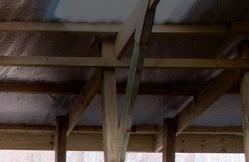

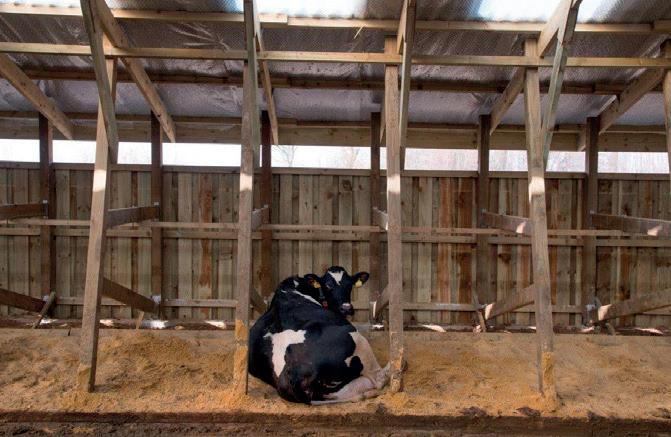
Currently, the farm has 210 cows in-milk, but with heifers in the programme, herd numbers are expected to reach 350 by
the end of Spring 2024. e 500-cow target is on track to be reached within three years.

“It is proving to be a great set-up for us,” says Louis.
“We are milking twice a day on a 14/10-hour split, which sees morning milking completed in 90 minutes, with a ernoon milking taking just an hour and 10 minutes. And it is currently achieved with just
a single member of staff.”


Herdsman Jack Adams carries out 95 per cent of Westwood Farm’s milking, and says the parlour is a joy to use.
“Cows are milking up to 50 seconds quicker, using DeLaval’s integration of robot technology that sees vacuum increased progressively as milk ow increases from the udder,” says Jack.
“ e whole process is smooth,

easy on the cows, and with kick guards and muck protection, being in the pit is no longer such a high-risk task.”
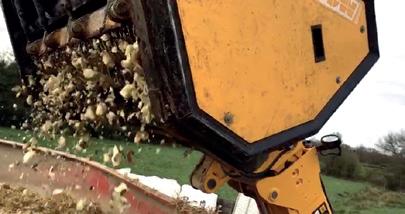
He says that downsides are few, and while a slow milking cow can hold up one side of the parlour, the installation of rapid exit stalls with water jets at foot level encourages the cows to exit. Animals do not need to make a sharp turn on exit, so can meander out and loiter as the rapid exit gates close for the next batch of 20 cows.

“By the time you get the third cluster on, all 20 cows are in their place,” he says. “It is a high-tech set-up that also includes cluster ush, post-dip, yield meter, conductivity and blood monitoring, with data reconciled to cows through transponders. ere is no cell count

capability, though we have all but eliminated mastitis thanks to high-quality sand bedding.”

Mr Staddon says that where robot milking used to average 2.6 times, going back to twice-a-day milking has brought the herd average up
by an additional 1,000 litres.
“With the robot set-up, our cows were on their feet too much – circling, walking about waiting to be milked,” he says. “Now, they are resting for longer, are quieter and just seem to be generally much happier and far more content.”
Tub Grinders
- Exclusive UK Distributor of Haybuster & Rotogrind Grinders.
- Range of models from 5t - 25t / hour output.
- New, used & refurbished machines available.
- Ideal for straw, hay, green waste, roots, biogas feeds etc

Root Choppers & Cleaners
- Loader, 3 point linkage, free standing PTO and electric drive available
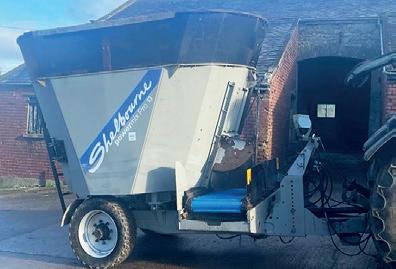
- UK Distributor of VDW range of choppers, cleaners & feed dispensing equipment
- Output from 10t/hour to over 120t/hour available
Diet Feeders
- Largest stock of mixers in the UKover 50 ma chines in current stock
- Refurbished, used & nearly new units available
- New Mini Mixer available
- Diet feeder parts available- Blades, Conveyor belts, gearboxes, weigh cells.


- All feeders undergo 30 point service

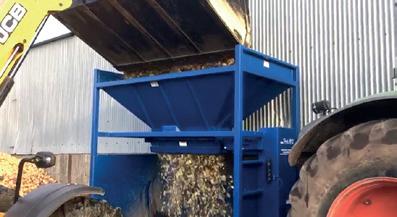
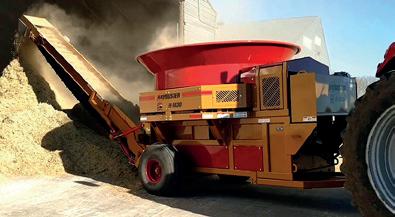
- Finance available subject to terms

- Nationwide delivery available
Current Used Stock:
- Trioliet 20 x 2
- Strautmann 10, 20m
- Bvl 10, 12, 15, 20m
- Kuhn 12, 14, 27
- Siloking 14 x 2, 14 duo, 18m
- Shelbourne Reynolds 13, 19
- Hi Spec 12, 16, 20

- JF 18, 22m
- Redrock 14,16
- Rotogrind 760 x 4
- Farmhand Tub grinder -
Please visit www.enegis.co.uk for more photos or call 01789 205132 or 07721 442979
EXPERTS IN SLURRY HANDLING & BIOGAS SOLUTIONS ABOUT US SEPCOM® and CHIOR® offer advanced solutions through a comprehensive range of machines and accessories for livestock manure treatment and for effluents in biogas production
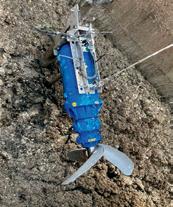



It is a futureproofed design that has given us the capacity to milk up to 500 cows
LOUIS STADDONRapid exit makes it easy for cows to leave once milking is complete.

JWhile most non-aligned milk prices for milk processed into the liquid market have held stable this October, unfortunately the same cannot be said for the cheese sector.
Here, producer milk prices are starting to crack under continued market pressures caused by weak demand, higher milk supply, hugely devaluing stocks, plus no support from lower basic dairy commodity returns. Add lower competitor milk prices and the bullishness of customers to force prices lower and the whole scene blends into quite a challenging cocktail.
e decrease takes our manufacturing* price back to 37ppl, which represents a total cut for the year to date of 12.5ppl. Our liquid standard price reduces to 35.68ppl.











e two main Somerset cheesemakers have both decided to cut a li le harder. Barbers Cheesemakers, which had paid the highest non-aligned milk price for cheese for the last couple of months, has reduced its price by 1.65ppl to 36.14ppl on manufacturing, 35.01ppl liquid.
Enviroseal provide a complete range of products for slurry storage
















SLURRY LAGOON LINERS Comprehensive 25 year warranty Materials meet EA and SEPA requirements Installed and tested by certified technicians
While some cheesemakers, such as First Milk and Lactalis, have decided to stick it out with another milk price hold for October, others have seen the writing on the wall and decided action must be taken.

A er decreasing its milk price by 0.5ppl for July, adding it back for August, Saputo Dairy UK, in agreement with its producer group DCD, has cut its price again by 0.5ppl from October.
BV SLURRY LAGOON FLOATING COVERS Keeps rainwater out of slurry Reduces odour from lagoons Covers comply with EA and SSAFO legislation



Wyke Farms similarly has cut its milk price by 1.66ppl to 36.11ppl for manufacturing and 34.90ppl for liquid.
Belton Farms
price unchanged since July. The decrease takes our liquid standard price down to 37ppl. YOUR DEPENDABLE PARTNER FOR SLURRY STORAGE SOLUTIONS enquiries@enviroseal.co.uk t: 01695 228626 www.enviroseal.co.uk
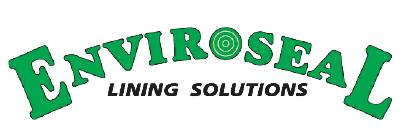
Belton Farm has reduced by 0.75ppl to take price levels down to 35.3ppl and 34.55ppl, respectively.



South Caernarfon reduces by the same amount to 34ppl and 32.85ppl. Wensleydale has reduced its September price by 0.17ppl to 36.79ppl and 35.59ppl.
Stephen Bradley on the latest milk industry developments.

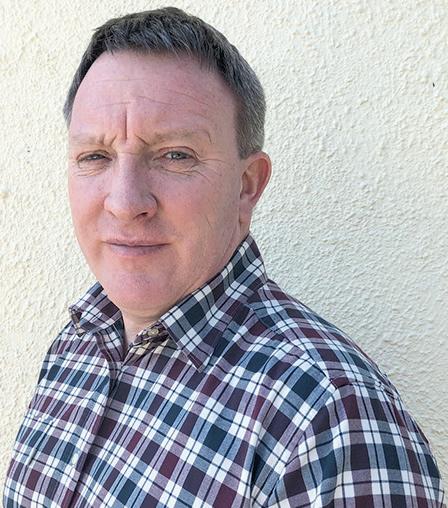
JSainsbury’s has increased its Sainsbury’s Dairy Development Group (SDDG) milk price by 0.34ppl from October, following the annual rebasing of its cost tracker model, plus the introduction of a new 1ppl margin to help its producers.
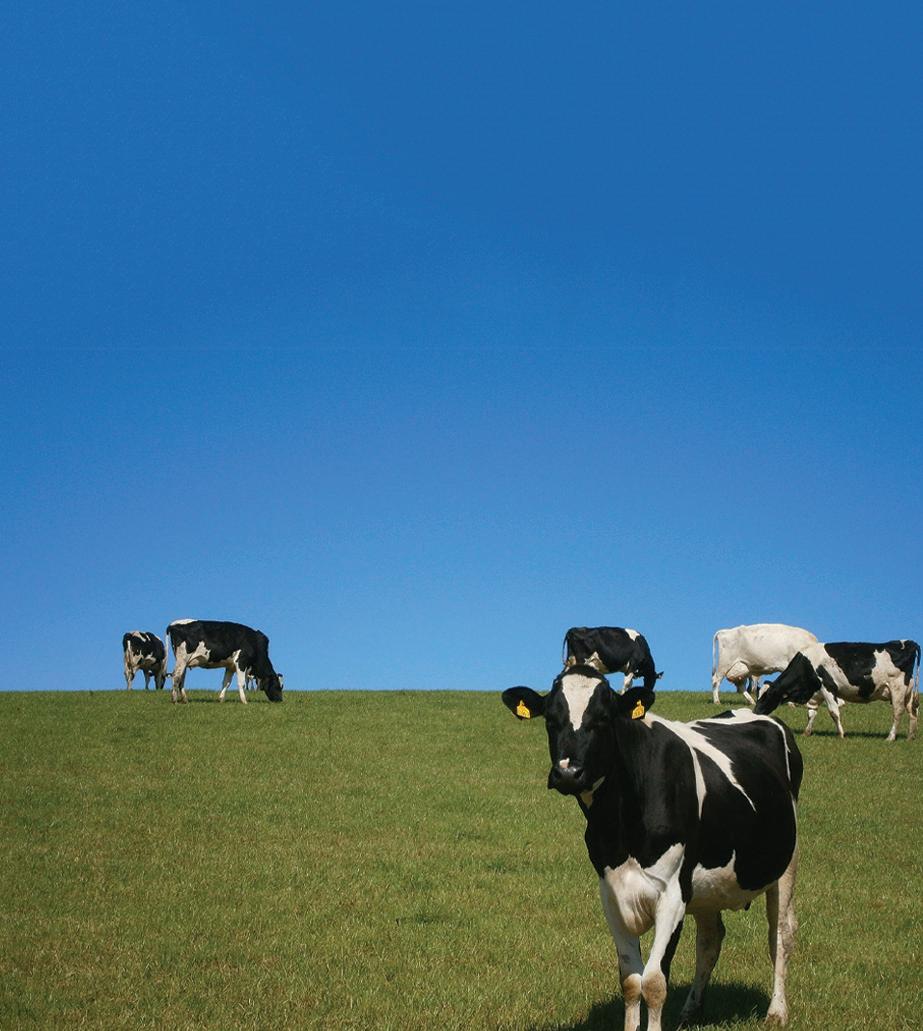
The increase forces a break in the string of eight monthly decreases (-6.95ppl


in total) and takes our liquid price for our Muller supplier up to 40.89ppl.
Our Arla SDDG supplier receives the same level of increase to 40.77ppl after including the company’s 0.12ppl haulage charge.
Both prices including an average bonus of 0.62ppl for herd health and efficiency.

JOn the back of the Sainsbury’s increase of 0.34ppl, the Muller Co-operative Dairy Group (CDG) milk price is to increase by 0.11ppl from
October. The increase reduces the retailer’s reduction for the year to date to 7.93ppl (after eight decreases), while taking our liquid price up 39.91ppl.
JThe revised M&S milk price model has triggered the 1.1ppl tolerance banding, which will see the milk price for suppliers decrease by 1.414ppl from September.
Suppliers in England and Wales are to receive a 0.26ppl additional payment in recognition of their signing up to the retailer’s new Green Fertiliser Scheme.
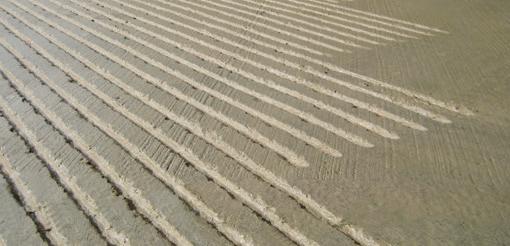



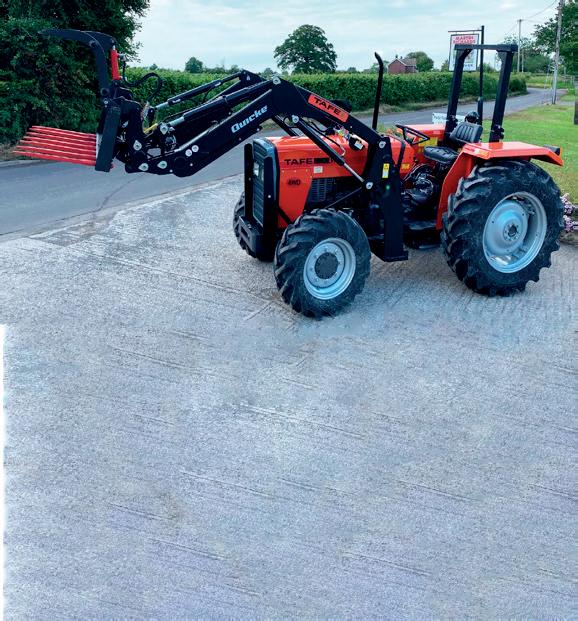





The decrease takes our liquid price down to 45.74ppl.
This price includes the retailer’s 0.75ppl M&S Scheme Standards Payment and is paid to all suppliers including those in Northern Ireland and Scotland. Our England and Wales supplier receives the 0.26ppl payment, taking their price down to 46ppl.
* Our Liquid standard litre is 4%b/f & 3.3% protein, for our Manufacturing 4.2%b/f & 3.4% protein and in both cases Bactoscans of 30,000/ml & SCCs of 200,000/ml, with Thermodurics of 500/ml, 1mltrs/yr on EODC (max vehicle accessibility) based on level supply and therefore, before seasonality, (but includes the winter premiums paid in NI) as well as monthly profile adjustments, balancing charges, capital deductions or annual/part annual growth incentive schemes or supplements not directly linked to dairy market price movement.
Prices for both Liquid & Manufacturing tables paid for a producer sending 1mltrs/yr on EODC (max vehicle size accessibility) with Bactoscans of 30,000/ml and SCC’s of 200,000/ml with Thermodurics of 500/ml. Excludes capital retentions or AHDB levies, profile adjustments from level supply, seasonality, balancing and A&B price schemes (includes the winter premiums paid in NI). Excludes annual / part annual growth incentive schemes or supplements not directly linked to dairy market price movement. Liquid price for milk contains 4% b/f and 3.3% protein. Manufacturing price for milk containing 4.2%/b/f and 3.4% prot. All prices for non-aligned prices are before monthly retail supplements. (i) May’23 prices before seasonality or B pricing (ii) Jun’23 prices before seasonality or B pricing (iii) Table ranked on simple rolling 12mth average of monthly prices Jul’22 to Jun’23). (i) v (ii) The difference Jun’23 compared with May’23. UK Arla Farmers 2.54ppl decrease from May’23 includes forecast 13th payment of 1.24ppkg (1.277ppl) based on our liquid std litre. UK Arla Farmers 2.65ppl decrease for May’23 includes forecast 13th payment of 1.29ppkg (1.329ppl) based on our manufacturing std litre. UK Arla Farmers 1.71ppl decrease from Jun’23 includes forecast 13th payment of 1.24ppkg (1.277ppl) based on our liquid std litre. UK Arla Farmers 1.78ppl decrease for Jun’23 includes forecast 13th payment of 1.29ppkg (1.329ppl) based on our manufacturing std litre. Arla Direct June decrease of 2.64ppl is from the 5th June netting back 0.35ppl for the month. First Milk price includes 0.5ppl Member Premium accrued as a 13th payment paid Apr’24. First Milk Haverfordwest Tesco Cheese Group includes 2ppl retailer premium averaged as 1.5ppl based on seasonal profile. Fresh Milk Company price before Morrisons monthly cheese supplement (last payment made in Dec’22 of 0.072ppl for Jul’22 to Dec’22 period). MMG Direct price includes 1ppl Premium paid annually in arrears to Direct/Organic farms meeting specific Müller Direct criteria (Quarterly payments from Apr’22).Crediton Dairy price includes FarmMetrics Scheme Bonus of 0.5ppl paid monthly. South Caernarfon price includes flat 0.4ppl annual member bonus paid monthly. ‡ Price includes 12mth average rolling profile fixed at 0.57ppl. * UK Milk Futures Equivalent (UKMFE) net to producer includes 5% processor margin and allowing 2.5ppl ex-farm haulage May’23 and 2.47ppl for Jun’23 + milk testing. ** Ave delivered spot milk net to producer allows 3ppl covering haulage + milk testing and margin.


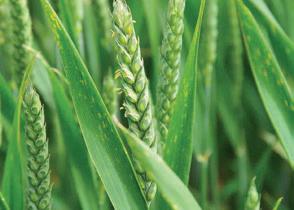

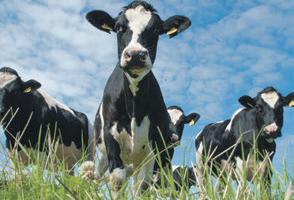
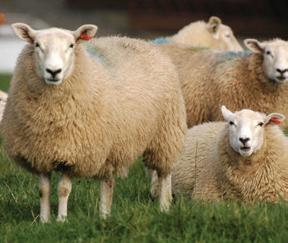





Pump positions: (left, right or centre)
Standard length: 2 or 3 meter


Non-slip flooring
One Touch system programming
Heavy-duty stainless steel construction

Farmgate prices may have stabilised for some, but there is no guarantee there will not be further milk price reductions in Q4, as milk prices are still


outstripping the value of commodities by some distance.
AHDB’s latest gross AMPE price is 28.6p, for example, and that is without a processor margin or transport. The gross MCVE is just
JEU markets are bouncing along the bottom, with no clear sense of direction just yet, as there is no major buying being done.
End use buyers covered their requirements for September well before they went on holiday and show no signs of being short for Q4 just yet, although some sellers hope that there is a lot of buying still to be done for then.
The average European butter price, as measured
by the German, French and Dutch published prices, stands at €4,380 (£3,750).
Spot trades are going from as low as €4,150 (£3,560) to as high as €4,450 (£3,816) for Q1 next year.
The average food grade SMP price is now €2,200 (£1,880). The combination results in an AMPE price of about 27ppl after an allocation for transport, added supply chain costs and a processor margin –similar to AHDB’s AMPE price.
over 34p on the same basis. After costs, AMPE will be about 25p. So far in September, six processors have cut their prices for October, but it is likely there will be more to come.
There is still no major change on the outlook for cheese, according to the EEX prices and forward predictions, with those for curd and Cheddar now lower than they were two weeks ago, in fact, with gouda and mozzarella about the same price.
UK mild Cheddar is £3,250£3,300 – the lowest it has been since September 2021.
Whey prices are still very weak and adding to the challenge cheesemakers are facing.

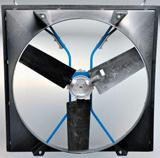
JIt has not been a good month for the futures. EU butter prices have dropped by more than €130 (£110) on average through until Q2 next year, while New Zealand butter is relatively stable, with currency helping its euro price.
Prices for EU butter for the next quarter average €4,600 (£3,945) compared to €4,715 (£4,045) a month ago, with the highest price currently being €4,650 (£3,988) for February next year. The lowest price is €4,450 (£3,816) for September. A month ago, the highest price was €4,750 (£4,074). New Zealand butter is currently averaging €4,270 (£3,662), so a considerable
difference to EU levels. EU SMP prices average €2,415 (£2,071), compared to more than €2,500 (£2,144) a month ago. As with butter, the highest price is for February next year, at €2,460 (£2,110), and the lowest price is September, at just under
€2,200 (£1,887). New Zealand butter is slightly higher and averages €2,300 (£1,972). When converted into a milk price equivalent, the futures return a price of 26-28p for the EU and slightly less than that for New Zealand.

JUK and GB milk volumes are holding up well, despite falling milk prices still.
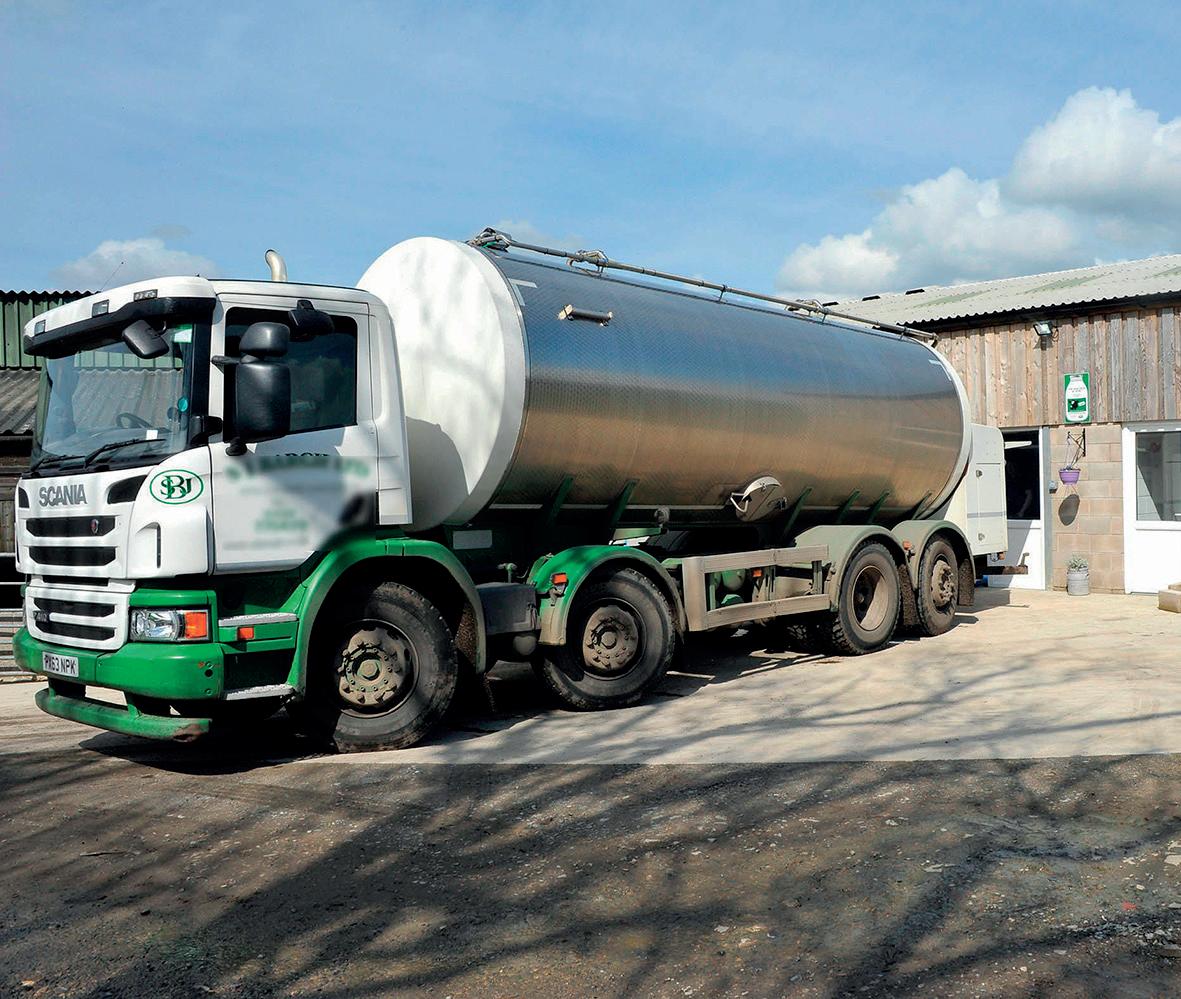
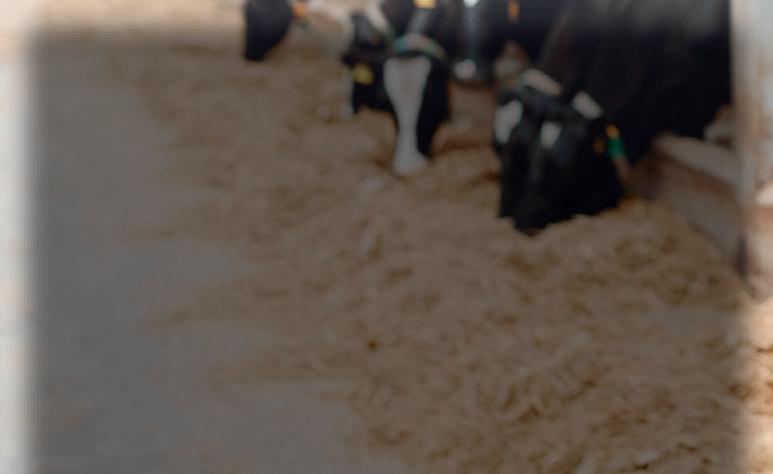


Over the last month, volumes have typically been up between 0.5% and 1% on last year, and down about the same against the medium-term average.

We are now through the




trough and on the rise to the flush next year. This will almost certainly keep the pressure on markets –exactly what we do not want.
In Europe there are some signs of production easing back, with June’s volumes pretty much level with last year.
This month, we feature a new online ordering platform, feed management software, a mastitis diagnostic tool, a milk replacer additive pack and a new supplement.

JA new molecular diagnostic assay to rapidly identify mastitis pathogens in dairy cows has been launched by Scottish Biotech company Biotangents.
AmpliSpec LAB Mastitis works by using isothermal amplification technology, with it said to have a 93% sensitivity and 95% specificity. Biotangents believe its new test has cost, speed and accuracy benefits when compared to traditional culture and PCR testing used by animal health laboratories and veterinary clinics around the world. It is hoped the tool will help farmers, vet, and laboratories to better treat mastitis.
rMore information from biotangents.co.uk
Anew online ordering platform that farmers can use to place compound and dry blend orders has been launched by ForFarmers.
Believed to be an industry first, the MyForFarmers service enables farmers to place compound and dry blend orders any time day or night from their smart phone, tablet or computer.
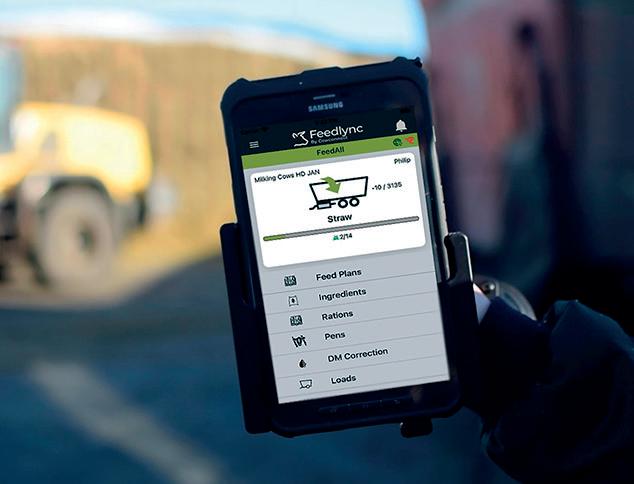
Customers can also use the platform to access help with orders via a direct messaging service, while it can also provide updates on delivery status and gives online visibility of all order and transactional documents.
Order amendments and an option to pay invoices online for those customers who currently pay by credit card or cheque, will be available imminently.
rMore information, including a user’s guide and video tutorials giving step-by-step
instructions on how to access and use the platform, from forfarmers.co.uk/myforfarmers
JNew products are featured in each issue of Dairy Farmer. Please send details and pictures to Katie Fallon at katie.fallon@ agriconnect.com, or call 07815 003 227.
JNew from Cowconnect, Feedlync 2.0 is a new digital, cloud-based feed management system aimed at helping users to analyse feed accuracy quickly and easily, allowing for instant adjustment of feed composition and cow numbers.

Operated via the app, available on iOS and Android, and an online portal, features include a loading accuracy heatmap and stock management features, allowing
for operator accuracy and stock levels of all ingredients to be monitored as well as access to real-time updates on forage stocks.
Other new features and improvements include a loading alarm, resetting mix on unloading, ingredient management within the app and improved smart dry matter correction.
Feedlync 2.0 is the second update to the digital feed management system, with the
primary markets being the UK, US, Denmark and Germany
rMore information from feedlync.com
Our Agriculture and Estates team are leaders in their field
JThe Britannia range of Energised calf milk replacers from TBA has been enhanced with the addition of an additive pack.
The Patriot Gold additive pack, said to contain a unique blend of natural
additives that combine to help maintain the robust gut calves need has been designed to allow calves to optimise the use of nutrients fed.

rMore information from 01300 345 711.
Rural life is my passion. I really understand the people and the business in the countryside – I work with farmers, landowners and a wide range of rural businesses, advising them on all manner of farming disputes.

Bryn Thomas, Partner, Agriculture and Estates 07715 060 321
www.hcrlaw.com

Future-proof your farm business, gain insight and exchange knowledge with a Farmers Guardian Farm Futures membership.
A one membershipyear is only £289
JA new supplement has been launched with the aim of improving nitrogen and feed efficiencies.
Said to combine the benefits of molasses and regulated release proteins with added methionine in the form of MetaSmart from Adisseo, ReguSmart 27 from ED&F Man comes as a combined molasses and methionine supplement.
The additive is a high dry matter liquid feed with 53% sugars, 27% crude protein with the optimal inclusion of digestible methionine with 2.5% of MetaSmart.
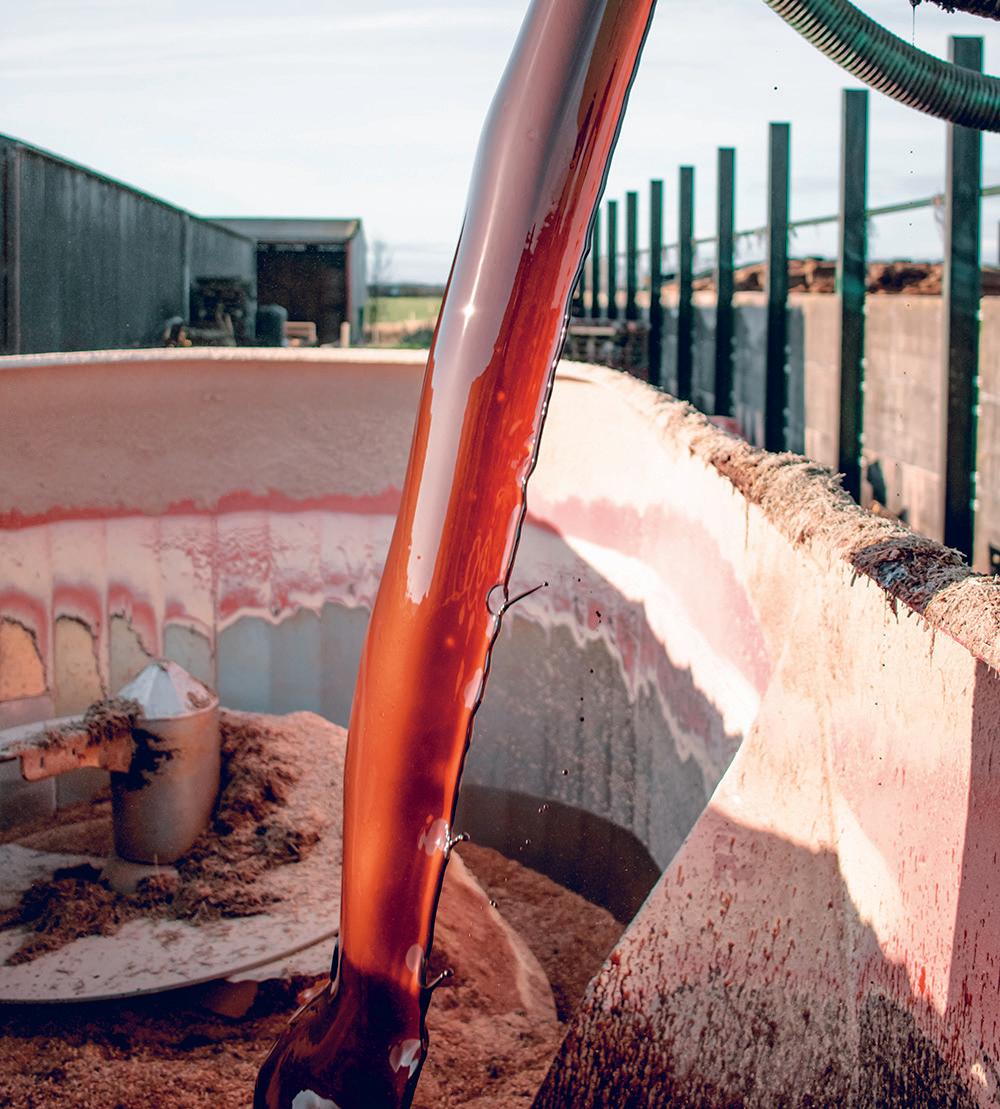
It is formulated to be fed at 1.4kg/day and makers say has been designed to help drive production from home grown forages.
rMore information from ED&F Man on 0151 944 3915.

Included in your membership: Farmers Guardian delivered directly to your door every week including full digital access. Plus, check out our brand-new features exclusive to Farm Futures members.

Insight – Quarterly, in-depth, analytical reports into the latest agricultural trends to optimise your farming practices Exchange – A series of digital events focused on learning from real case studies and exchanging knowledge with agricultural thought leaders

Weekly Digest email – From the desk of FG’s editor every Sunday morning, discover exclusive insights which impact the business of profitable farming Members’ Lounge – Enjoy an exclusive space for members to network at leading events, such as LAMMA, CropTec, Future Farming Expo Scotland and Farm Business Innovation.




Become an FG Farm Futures member today

Visit farmersguardian.com/membership



Call 0330 333 0056 and quote S304

V Mix 33 3S Steering axle, 2 front doors, 600 mm elevator, rear door, app based weighing, stainless liner, mudguards, work & rear lights

V Mix 22 2S Tandem Steering, non DHF, 435/50R19.5 tyres, front RHS door, 1000 mm elevator, LHS door with chute, RGB, App based weighing, HD lighting, 18 mm augers
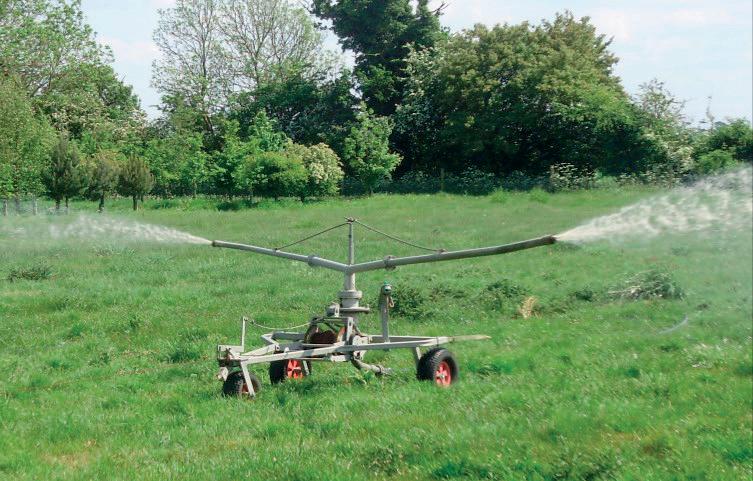
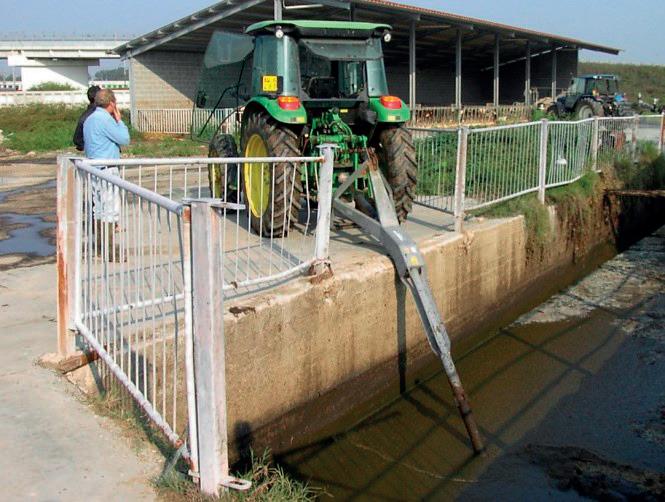
V Mix 20 2S, non HDF, RGB, 435/50R19.5 tyres, 18 mm augers, HD lights, 2 front doors, 600 mm elevator, chute, mudguards, work light
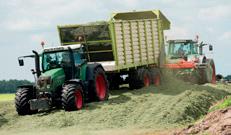
V Mix 15 2S, front R H S door, hydraulic down to up chute, 435/50R19.5 tyres, App based weighing, 18 mm augers, RGB
V Mix 12 1S, RHS door, chute, 400/60R15.5 tyres, app based weighing, manual parking jack



V Mix 10H 1 S, 400/60x15.5, RHS door & chute, weighing, front window, 18 mm auger
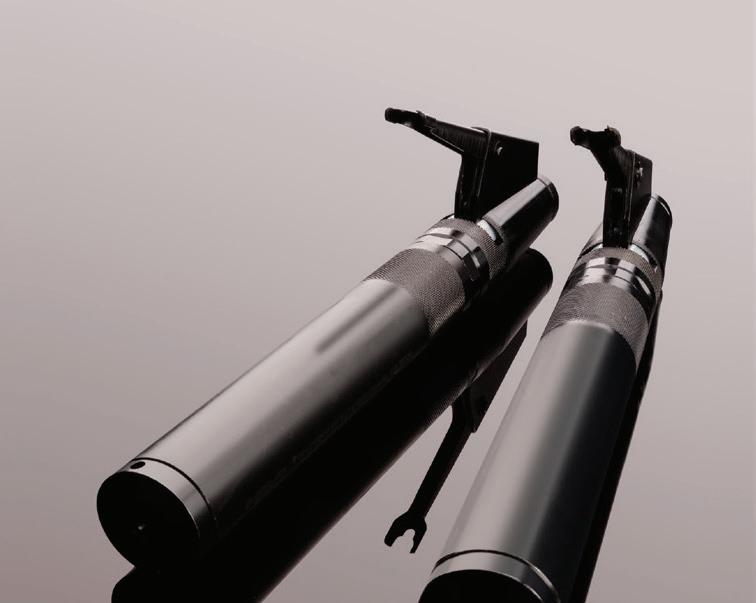
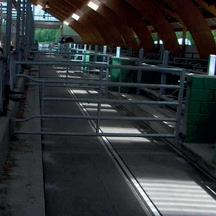
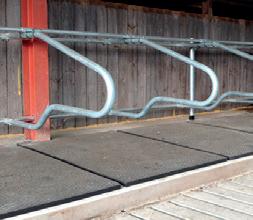

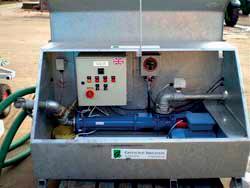
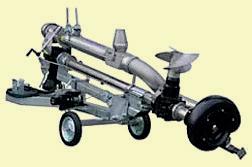


For more information, please contact either: North: Paul McUrich - 07810 040100 paulmcurich@gmail.com



South: John Molton - 07947 719985 john.molton@bvl-group.de www.bvl-farmtechnology.com
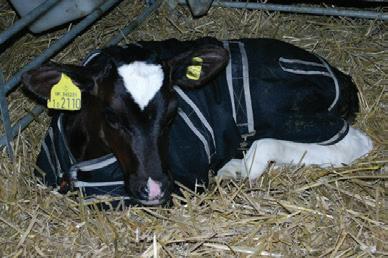
Equipment & Accessories

Delaval mobile milking bale for hire/sale.
Delaval Blue Diamond 32/32 fast exit MM25s. Save energy, Ice Builders : Bulk Milk Tanks. Heavy duty replacement troughs for most parlours.

Delaval VMS Robots : Milk meters, keypads, feeders etc.

Everything for the Dairy Farmer Call Vic/Tracey Brown Tel: 01260 226261 www.milkingequipment.com




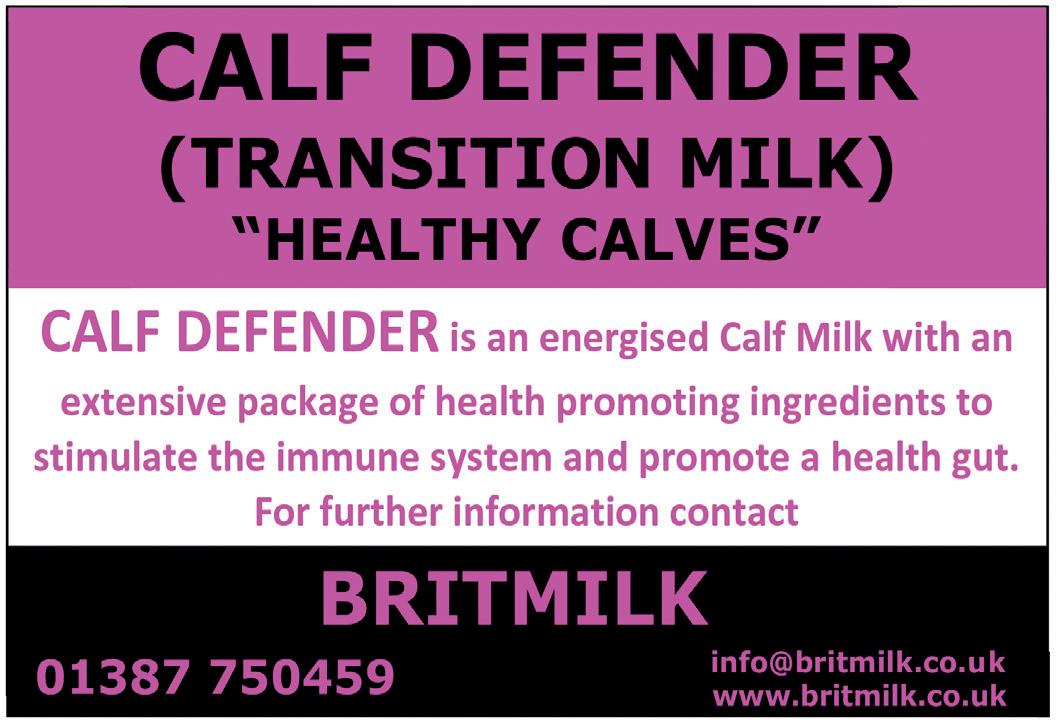





REASONS

This month, Roger Evans discusses the Milk Marketing Board, the importance of food security and gives his opinions on the members of the Government.
It’s a funny old world we live in. If you are not bothered about my political opinions then turn the page.
First under my scrutiny are the water boards; they pollute water courses every day to an extent that farmers wouldn’t dare to do once in a lifetime, and they do this quite openly. The only good thing to come out of this is that everyone now knows.
If ever there were an example of ‘one law for the rich’, this has to be it. I was never in favour of privatising the utilities anyway. What we had was not perfect, but at least it worked. With a bit of fine-tuning it could have worked better.
Now we have a succession of industries returning to public ownership, not because public ownership is a better way, but because private ownership hasn’t worked.
All of this initially was driven by the political dogma of the time and that also led to the demise of the Milk Marketing Board (MMB).
For several years I was involved in the co-operatives which succeeded the MMB and I used to despair when older farmers used to say ‘we could do with the MMB back’. But perhaps they were right?
The writers for Dairy Farmer were very different in those days; there were about six of us and we all used to write every month.
I can’t remember why, but the MMB was getting a bad press at the time, so invited all of us writers to spend the day at the headquarters of the MMB at Thames Ditton.
They thought it was a sort of reunion for us, but the truth was that many of us lived miles apart and we were meeting for the first time.
We spent an afternoon at Thames Ditton and the excesses were plain to see. The place was huge and warm with staff. I particularly remember that there were two big limousines and two chauffeurs to fetch and carry notable guests.
At the end of the afternoon we were taken by coach to a posh hotel in the centre of London. A meal was put on for us that night and we were drilled about MMB.
At about 10pm, our host (a PR man) made a big show of getting up, yawning and stretching and saying that we had an early start next day. I very casually asked him what room he was in and we drank on his room number until the early hours.
It was back to Thames Ditton the next morning and we finished with a Q&A session. I didn’t ask any questions. I can still remember my hangover.
One of the things we all hope for is that food security will move up the agenda. Not that any of us want food shortages, it’s just that it should be an important part of any party’s future strategy.
We take the need for clean water and power as necessities of life, surely food supply should be up there as well?
Change is an essential to life as well and
only when food security is challenged will we get the hope that our efforts will be appreciated.


Don’t expect any hope before the next General Election; food prices will be under pressure as an attempt to bring inflation down.

It’s not the Government, but the supermarkets which have kept food prices down for a few generations.
If you are a dairy farmer and you have a bad price for your milk and, at the same time are challenged by TB, then your very living is precarious.
 Rishi Sunak
Rishi Sunak
I’ve not yet made my mind up about Rishi Sunak. He seems to face a crisis every week and goes to great lengths to say that the
crisis is not of his making, but I’m not so sure and my jury is still out.

Boris Johnson is a sort of Marmite figure. I think he would be a good companion on a long journey. I don’t think he is much bothered about food and farming, as he’s too busy feathering his own nest.



It’s his wife that we need to be wary of. It’s true that she doesn’t have the power she had when Boris had the top job, but she has some wealthy and influential friends and we mustn’t underestimate her influences.I bet she is working away in the background.
The best thing I can say about Keir Starmer is that at least he isn’t Jeremy Corbyn.
He’s got some very clever young ladies in his shadow cabinet, but they tend to be very left wing and aggressive with it.
“One of the things we all hope for is that food security will move up the agenda
Milk prices may have stabilised in the last few months, but it could be some time before they increase, as wholesale prices around the world remain under pressure. Cedric Porter reports.
The drop in wholesale prices has been as dramatic as the rise in values last year. When expressed in pounds, EU butter, skimmed milk powder (SMP) and whole milk powder prices (WMP) were about one-third lower in July compared to July last year, according to AHDB figures.
US prices have fallen by between 22% for butter and 40% for SMP. Prices of New Zealand and Australian dairy products have fallen by up to 39% over the last year.
UK prices have fallen by similar
proportions, but British butter and SMP is competitive against other exporters. British butter is 11% cheaper than US, while UK skimmed milk powder is 6% less than the average EU price. However, UK Cheddar cheese is 36% more expensive than US, but similar to that from Oceania.
The UK has some of the lowest
JGlobal dairy consumption is expected to increase over the next decade. The UN’s Food and Agriculture Organisation (UNFAO) and think tank OECD predict an average increase in consumption of 1% per person a year between 2023 and 2032.
Meanwhile, the world population is expected to grow by 7.4% by 2032, according to the UN. That raises the prospect of more than 15% growth within the next 10 years.
That growth will be focused on India, Pakistan and Africa, according to the UNFAO and OECD. China will remain an important market, but growth will be slower because of its slow down in population. Europeans and North Americans are still expected to be eating more cheese by 2032 and butter may have a resurgence.
Production is expected to keep up with consumption, with annual growth of 1.5%. This outstrips other agricultural commodities. Unsurprisingly, regions with the fastest growth in consumption will see the greatest growth in production.
India is forecast to experience an annual increase in dairy cow numbers of 2%, with yields up
0.5% a year. Growth in Pakistan is expected to be a little faster than in its neighbour, while African yields are expected to increase by more than 1% as cow numbers increase by 1.5%. Crucially, output may come under pressure in countries which are major traders of dairy products, which could support the UK industry. A drop in cow numbers is expected to outweigh
farmgate milk prices in Europe, something unwelcomed by producers, but which could make it competitive when it comes to making products for domestic and export use.
According to figures from Dutch dairy organisation Zuivel, the average price of a group of EU and UK dairies in July was €42.39/100kg
any increase in yields in the EU. A push for more organic herds in the union could impact on supply.
New Zealand is also introducing environmental measures which restrict cow numbers. American yields and cow numbers are expected to increase, but population growth of 0.5% a year may absorb some of that extra production.
of milk (£36.03/100kg). Of the 15 dairies quoted by Zuivel, only four had a lower price than Saputo Dairy UK, the only British company on the list. They were Ireland’s Dairygold and Glanbia, Germany’s DMK and Arla Denmark. The Saputo price was €38.45/100kg (£32.68/100kg).
The reliance on the big six exporters – accounting for 65% of world milk production and 80% of world dairy trade – raises the prospect of more price volatility
depending on supply in those key countries.
The OECD/UNFAO expect price gains for wholesale dairy products over the next decade in actual prices, but when
Note: US, Oceania and EU prices based on £ and US$ exchange rates for relevant months.
is expected to increase over the next decade.


US and New Zealand prices were lower than all European prices at €32.08/100kg (£27.27/100kg) and €34.38/100kg (£29.22/100kg), respectively.
A run of losses on the Global Dairy Trade (GDT) auction going back to the middle of May ended on September 5, with a 2.7% increase
inflation is taken into account, real gains may seem elusive.
Freya Shuttleworth, senior dairy and livestock analyst at AHDB, says: “Much of the extra production
in average prices, although gains were confined to butter, whole milk powder (WMP) and anhydrous milk fat.
The GDT Index is at a level last seen in 2018, with a 45% drop since March 2022.
Relatively strong dairy production across the world has contributed to falling prices. Figures collated
in countries such as India and Africa expected over the coming years will be absorbed by a growing population consuming more dairy products.”
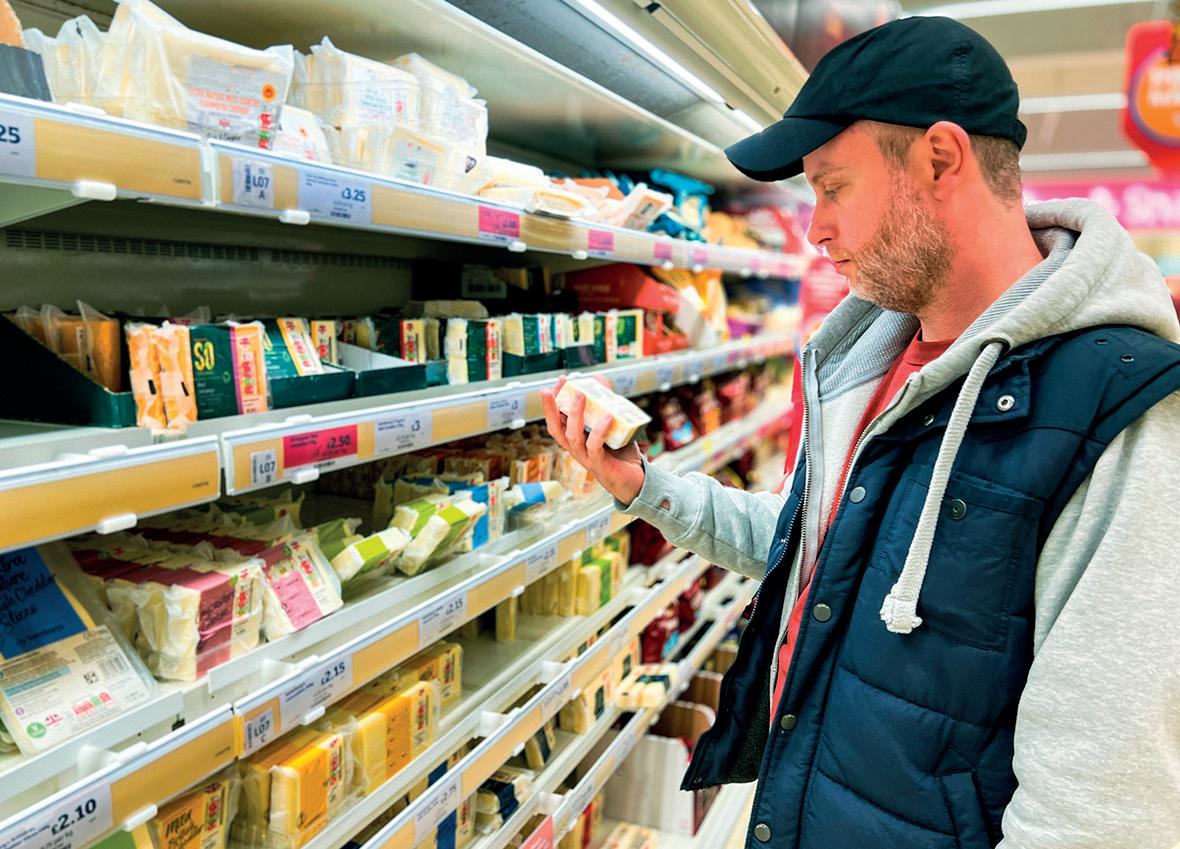
by AHDB show that in the first six months of 2023, the six largest dairy trading regions – EU, USA, New Zealand, UK, Australia and New Zealand – delivered 0.7% more milk than in the same period last year. There is a sign of some slow down, with June output 0.1% lower. In the six-month period, production in New Zealand was 2.8% higher, while it was up 0.7% in the EU and the US. It was slightly smaller in Argentina and Australia.

“Signs of weakening dairy demand are spreading across some markets,” says Mary Ledman, global dairy sector strategist at Rabobank in its latest market commentary.


She adds that Chinese milk production is increasing, which is putting pressure on imports into the country. China is one of the largest dairy importers in the world and a major buyer of products from New Zealand, among others.




The EPIHERD project, led by Antler Bio and supported by the Centre of Innovation Excellence in Livestock (CIEL), was awarded a Smart Grant from Innovate UK to develop a platform which will help farmers access epigenomic data on their dairy herds to improve performance.
Dr Andrew Lessey, chief operating o cer at Antler Bio, says that with the challenges currently facing the dairy industry, such as net zero and market pressures, running pro table businesses with high-performance herds has never been more challenging for farmers.

He says: “In light of current challenges, it is crucial for farmers to have access to tools and technology which will help them raise high-performing cows and therefore they will bene t from utilising epigenomics to manage their herds.”
Antler Bio, a genomics company, initially started looking at genomics
and performance in the equine sector before expanding its focus towards dairy.
Dr Lessey says: “With our work in the equine industry, we were able to identify biomarkers and gene expression pro les which correlated to high or low performance.
“ rough the Innovate UK grant, we were able to extract, implement and apply our technology from the equine industry to the dairy sector.
“In the dairy industry, selective breeding has traditionally focused on a few key characteristics, such as milk yield or fertility.

“However, by doing this and not looking at performance holistically, and the expression of genes in individual animals, you are not necessarily going to be able to raise animals with health and well-being in mind or be able to support optimum performance in every animal in a herd.”
Dr Lessey explains that when
Antler Bio applied its knowledge from the equine industry to the dairy industry, it initially focused on Holsteins, comparing the pro le of high-yielding cows versus low-yielding cows from the same herd.
He says: “We analysed the gene expression of each animal to see common pathways between the cows and why they may have performed be er or worse.
“We were able to gather a good insight on the gene expression pro les which support optimum milk yields, fertility, longevity, feed conversion and hydration, and from this data we can establish that there are real opportunities for farmers to use and analyse epigenomics to make management decisions for performance.
“ e next step of the project is delivering our prototype data analysis platform which will take complex data sets from herds and will present the data in an intuitive and accessible manner which farmers and
dairy consultants can use to make management decisions on-farm.
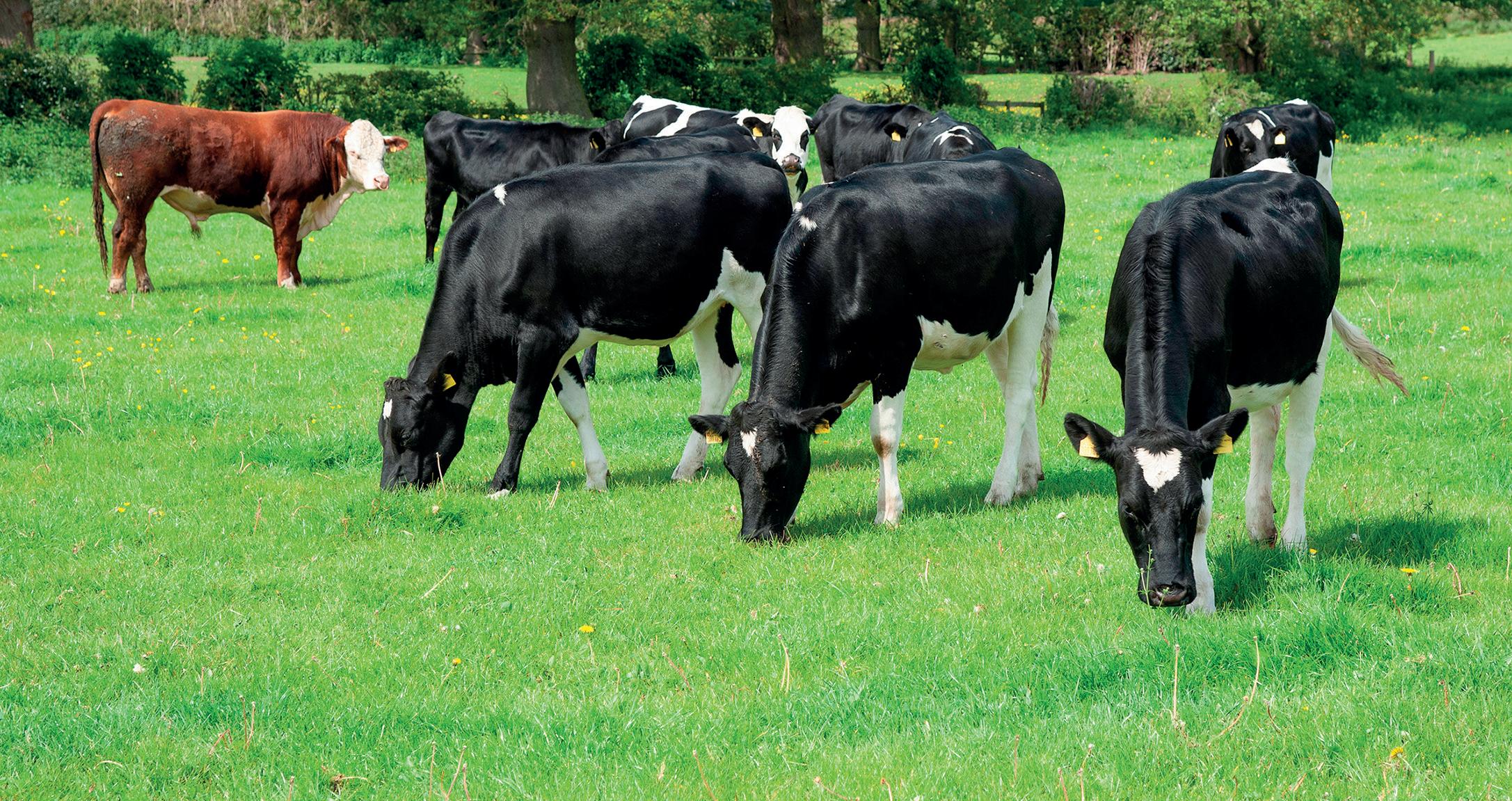
“As we continue to develop this project, we will be looking to grow the data set exponentially and will start to look at other breeds and performance characteristics too.”
Sarah Nightingale, projects and knowledge exchange manager at CIEL, says the organisation has been supporting Antler Bio to develop its digital platform.

She says: “We have been supporting Antler Bio with its EPIHERD project by using the CIEL network to ‘stress test’ the technology, working with dairy farmers and industry professionals to develop a user-friendly digital platform and take the technology from concept into practical use.
“We are looking forward to continuing working with Antler Bio on its epigenomic work and seeing the platform being utilised by farmers.”
REGISTRATION IS OPEN
15-16 NOV 2023 NEC BIRMINGHAM N V


Experience the power of innovation, inspiration and industry expertise at the UK’s premier event for farmers, landowners and agri-professionals.

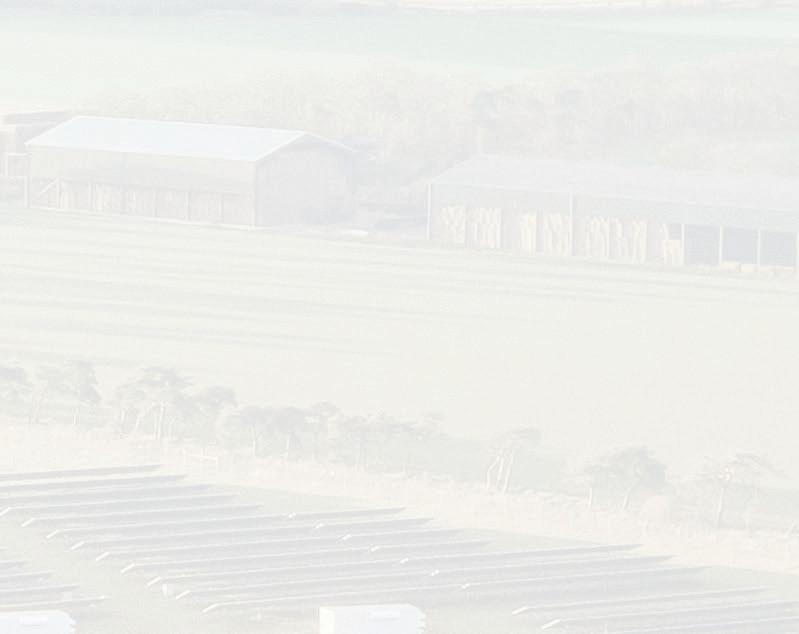

Whether you are seeking to expand your current rural business or explore diversi cation, Farm Business Innovation is the place to be.





See more than 420 exhibitors across four shows

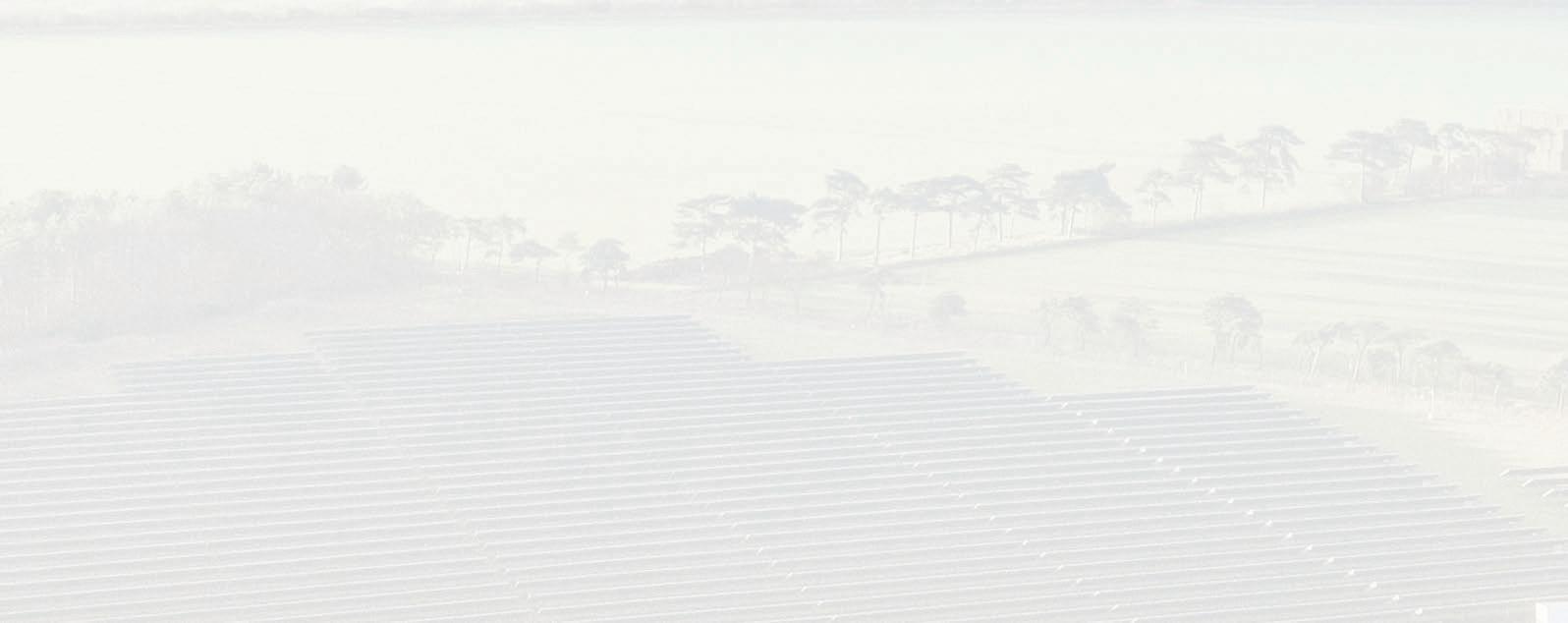
Diversify your income streams
THIS EVENT RUNS ALONGSIDE:
Network with industry professionals
Explore cutting-edge solutions

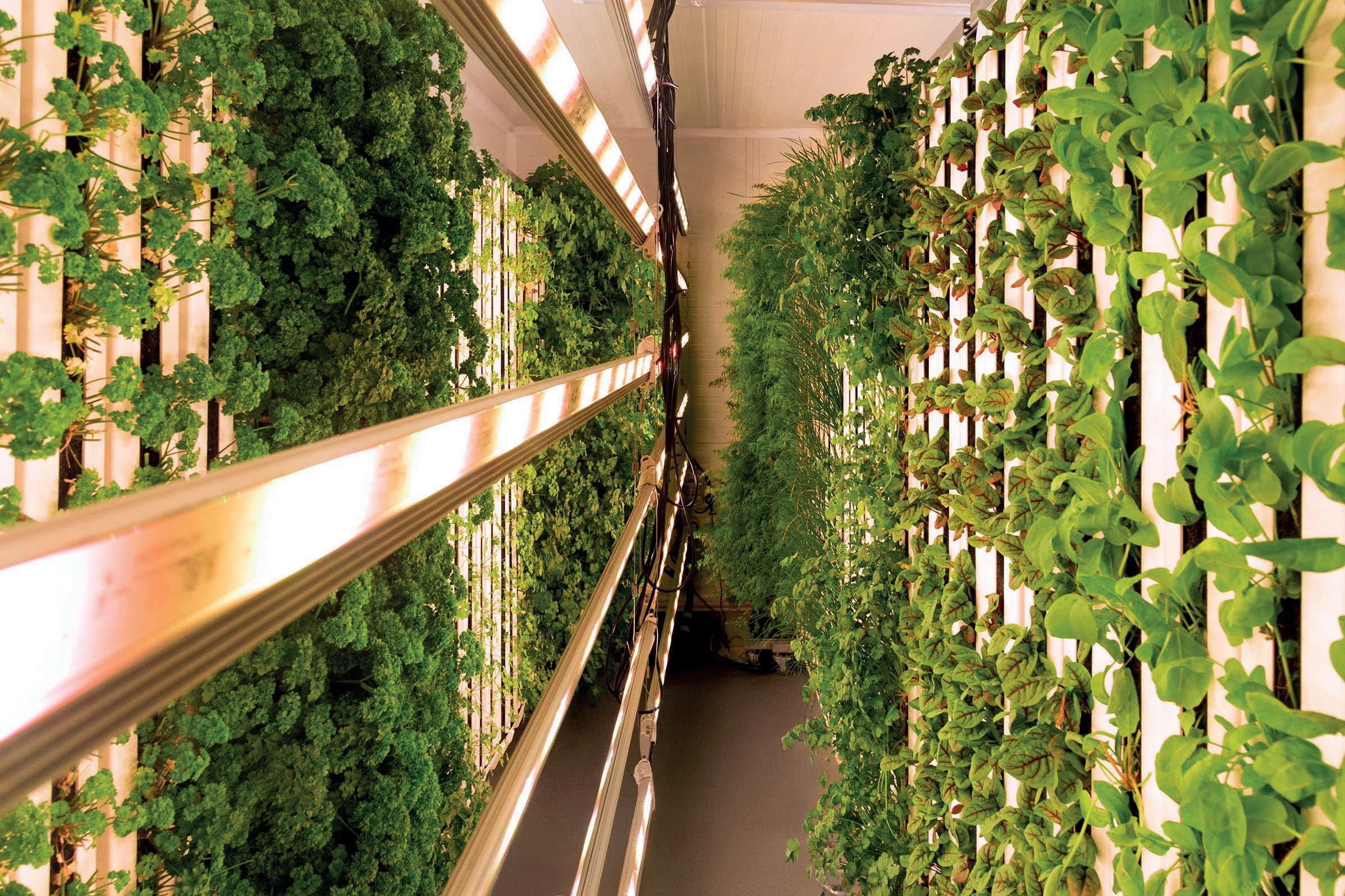

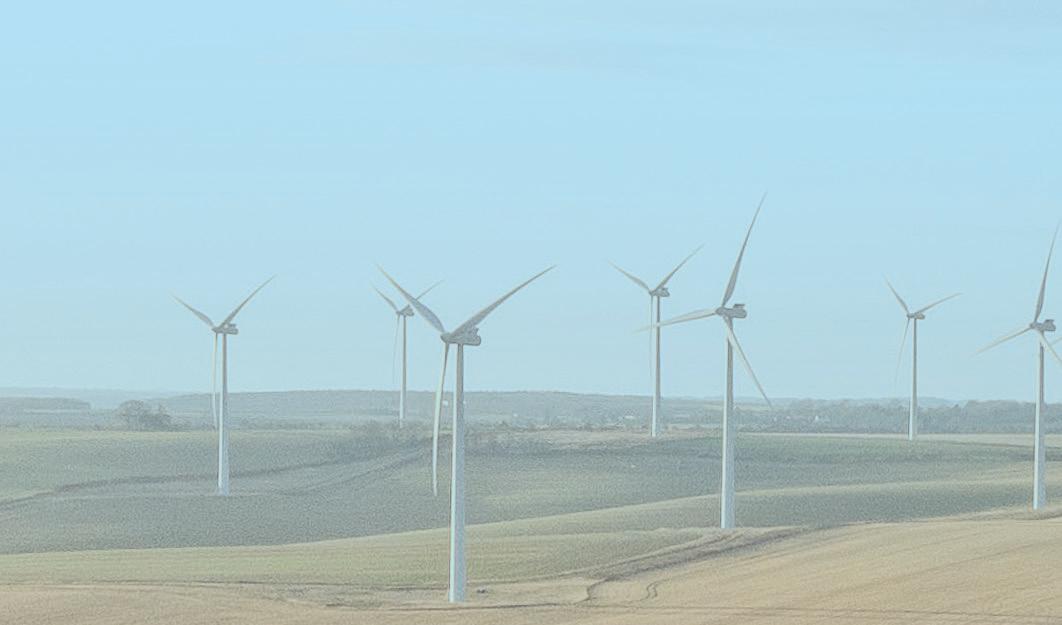

Get expert industry insights




To register for your free ticket, scan the QR code or visit:


farmbusinessshow.co.uk
















